Social media can be a hard nut to crack. You’re competing in a crowded space right alongside the biggest brands. But you never know when your newest idea might catch fire and become a social media sensation. We’ve rounded up 10 of the best social media campaign ideas to inspire you while you’re thinking of the next big thing.
Related: How to achieve brand consistency on social media
1. Show your product in action: Nest Cam
Google+ is sometimes left out of the social media circle, but that means you have the opportunity to become a stand-out brand on the platform. Nest, a company that produces advanced thermostats, smoke alarms, and home security cameras, has an enviable Google+ page that can be an example for your brand. Their page in general has a well-branded and visually appealing aesthetic, but one recurring feature is particularly delightful: the #caughtonNestcam videos (Nest Cam is Nest’s home security camera). This one is pretty good:
Here, Nest succeeds in showing their product in action in an engaging and humorous way. Seeing the Nest Cam in a real person’s home makes it easier for a potential customer to picture it in their home. It seems like Nest’s efforts are paying off, too. They have over 12 million Google+ page views and 604k followers.
2. Try a new platform: Oreo + Vines
Have you considered Vine as a social media marketing tool? It’s not the first platform that typically comes to mind, but Vine is a jungle of opportunity (get it?). Oreo caught the Vine vision and used the platform to make videos that, well, made people want to eat more Oreos. These videos also empowered their customers by giving step-by-step tutorials of several different recipes that feature Oreos as an ingredient.
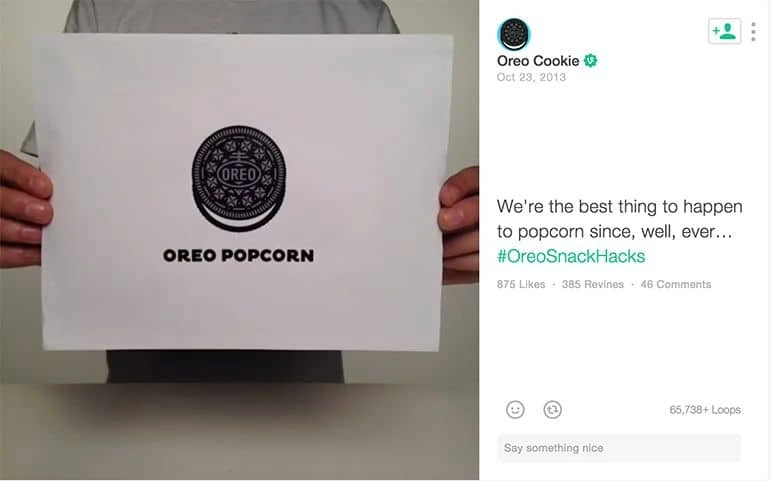
All this has earned Oreo 55.9k followers on Vine and over 3 million video loops. While recipe videos might not fit your brand, how about a product announcement featuring your team wearing lederhosen while yodeling? Or, you know… something like that.
Update: Vine has closed its doors, but the lesson of trying new platforms still stands. For example, has your brand considered Snapchat?
3. Monitor Twitter complaints: #HappyToHelp
Social media can help brands personalize and streamline their customer support, like when a customer tweets about a problem or complaint, and the brand promptly responds with a generous, thoughtful solution.
KLM, an airline operating out of the Netherlands, took this idea to the next level with their #HappyToHelp campaign. During the week of the social media campaign, they set up a control room in front of Amsterdam Schiphol Airport where they monitored thousands of tweets coming in from unhappy airline travelers. They paid special attention to customers having trouble with other airlines. Then they came to the rescue, retrieving forgotten visas, delivering a bed for a stranded traveler, and even singing a lullaby for someone who couldn’t sleep.

This smart campaign racked up 36 million impressions, and doubtless made a big impression of another kind on the many people who received personalized care from KLM. The genius of #HappyToHelp is that it reached competitors’ customers precisely when they were most dissatisfied with the customer service they were receiving. Monitoring Twitter for problems your customers are having is important, but you might consider checking for problems potential customers are having as well—and then solving them.
4. Make your own news: Pepsi
Pepsi has been around for a while, but that doesn’t stop them from innovating. The Pepsi team launched a social media campaign that caught the attention of London commuters by making it look like crazy things were happening on the street outside the bus stop. Here, just watch the video:
This campaign is interesting because it combines social media with a guerrilla street campaign. Pepsi created news by doing something interesting, and then marketed that news on their social channels. But it was done in a way that felt organic and natural, drawing people to the brand. The bus stop video has accumulated over 7 million views on Youtube in addition to all the people who saw it firsthand on the street.
5. Be helpful to your customers: Hellmann’s
What’s up with WhatsApp? It was the new kid on the social media block, but Facebook bought it for $19 billion, obviously seeing serious potential. Hellman’s (the mayonnaise company) saw that potential too and created a fun, helpful social media campaign centered around WhatsApp.
The campaign centers around a service called WhatsCook that empowers WhatsApp users to make something delicious using the ingredients they have on-hand. Here’s the situation: Angela (not a real person) is hungry. She has a few random ingredients in her refrigerator, but doesn’t know how to put them together. Using WhatsCook through WhatsApp, Angela can send a picture of the ingredients to a real chef who will suggest a recipe idea and then walk her through the cooking process. Pretty cool, right?
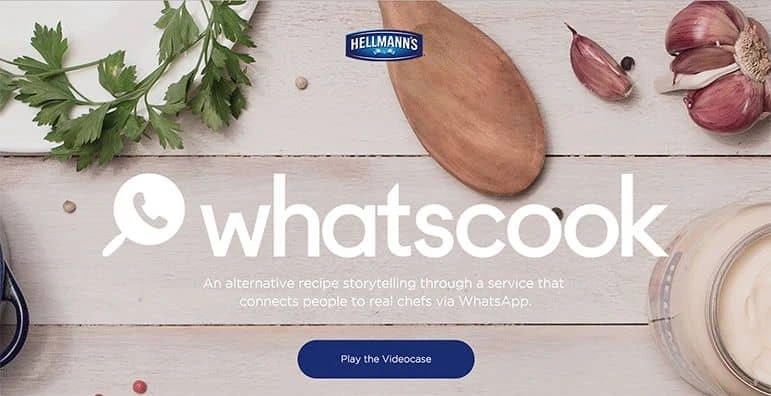
On average, users of the WhatsCook service spent 65 minutes interacting with the chef while they cooked. That’s a lot of time spent with a brand! Hellmann’s made at least two great calls with this campaign. First of all, they found a way that they could be truly helpful to customers and potential customers. There’s no rule that you can’t help your brand and help people at the same time. Secondly, Hellmann’s was willing to try something unique on a new platform. Sometimes you have to go out on a limb to find a gold mine.
6. Tap into the trends: Giformances
Leaders at The Katona József Theatre in Hungary were concerned that young people weren’t interested in theater because they saw it as out of touch with technology. So, the theater enlisted its top actors to create GIFs that expressed all kinds of different emotions, then put all the GIFs in an online catalogue called Giformances.
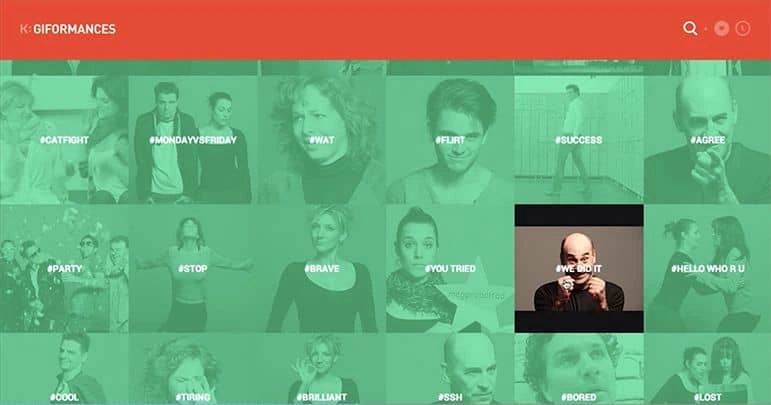
The response was impressive. Giformances got front-page news coverage on every major media outlet and was featured on primetime TV news. Plus, they’ve attracted over 200k unique users to date. Pretty good for a organization that felt it was unnoticed.
In this campaign, the Katona József Theatre demonstrated an awareness of cultural trends that would resonate with an audience they wanted to gain some traction with. In addition to considering a new social media platform for your campaign, you can also make waves by thinking of a unique way to present your content.
7. Showcase your use case: Living with Lag
People don’t like slow internet. So, it stands to reason that people will like a company who gives them fast internet. Ume.net, a fiber broadband provider, set out to prove their speediness in a unique way. They made a YouTube video of people trying to do everyday tasks with an Oculus Rift headset programmed with a three-second delay. The idea was to illustrate the woes of lagging internet in an offline setting. It was a light-hearted and creative campaign, and the YouTube video currently has almost 6 million views. Check it out:
Ume.net recognized that Oculus Rift headsets are en vogue right now, similar to the way the Katona József Theatre recognized the hipness of GIFs. Plus, ume.net invested in a great-looking video that did justice to their creative idea. It’s good to consider which campaigns can be done with little or no funding and which ones might require a little monetary love to take flight.
8. Time your efforts: Marie Callender’s
Ads are another option to consider when working with social media. Ads can leave a bad taste in our mouth, so when we see something that defies that expectation, it stands out. Marie Callender’s hit this nail on the head with tempting ads that spoke to the sudden craving for warm comfort food that might strike in cold weather. Here’s what they looked like:

The ads were wisely placed on Weather.com, targeting people who were checking the weather on a cold or rainy day. These aren’t social media ads, but the same principles of creativity and timing apply. Some great opportunities are holiday-themed posts or something that celebrates a milestone for your company (like this post). If you’re thoughtful with advertising and know the right moment to reach your customers, then you have a recipe for success.
9. Streamline the customer experience: Domino’s
When Domino’s was developing their social media strategy, they didn’t just fall back on the appeal of a delightful, melty slice of pizza. They took what is already inherently appealing about their brand and combined it with something that is quickly becoming almost as iconic as pizza: the emoji.
On Twitter, Domino’s fans can order a pizza by simply tweeting a pizza emoji. This is a unique and creative use of Twitter, and it’s particularly interesting because it is simultaneously a campaign and a transaction. That’s impressive efficiency. You can see from the photo below how many Twitter followers Domino’s has earned:
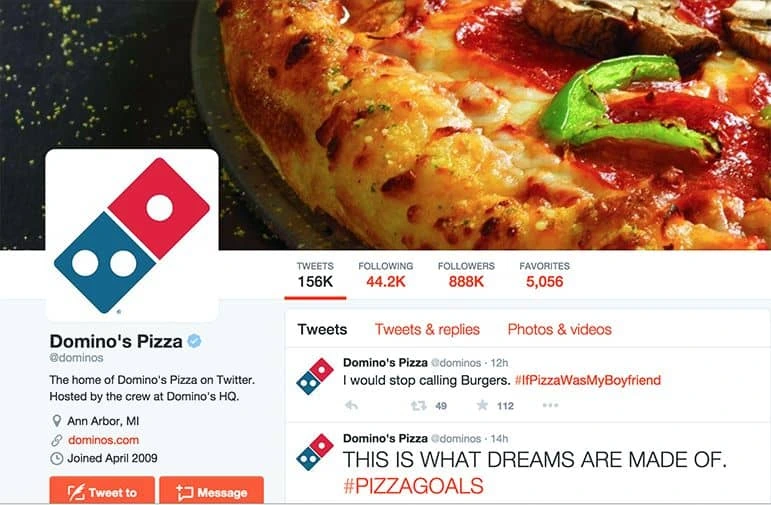
10. Match the campaign to the platform: #LastSelfie
Snapchat: the social media craze that has won the hearts of teens and millennials everywhere. Why not use it to inspire social activism? The World Wildlife Fund came up with a very clever way to utilize the Snapchat medium to rally support for endangered species. As is the case for all Snapchat photos, the ads that came up were only visible for a few seconds, then they were gone forever, hinting at the possibility of endangered animals disappearing for good if they go extinct.
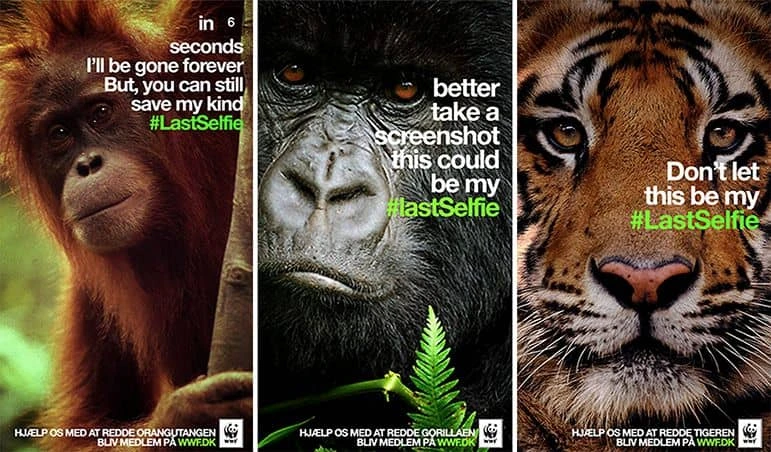
WWF reached their monthly donation goal in just 3 days thanks to this social media campaign. This is a great example of perfectly matching the campaign to the platform in order to really stand out. When you’re putting together your next campaign, consider taking time to note the core characteristics of a few different social media platforms. That way, you can tailor your ads to work in harmony with them.
The 10 best B2B social media campaigns you haven’t tried yet
By now, we’ve all heard how social media can support a brand and make it easier to connect with customers. But not all of us have the benefit of being a consumer-facing brand like Pepsi, Domino’s, or Oreo. If you’re representing a B2B brand, can you still take advantage of social media? Absolutely!
Here are 10 of our favorite examples of B2B brands using social media to build their brands and make an impact online
10. Build brand awareness: MailChimp on Instagram
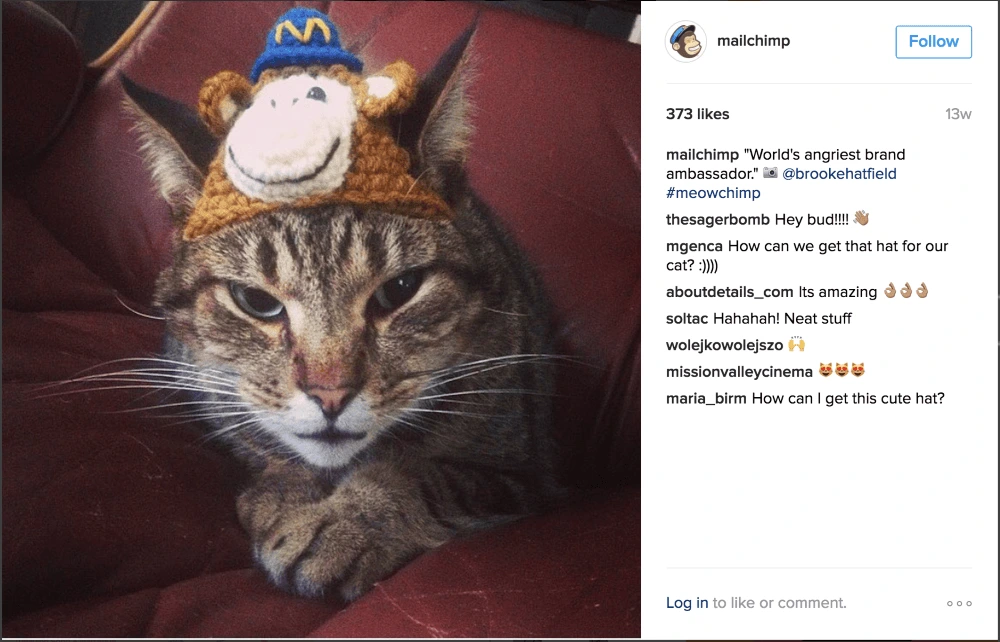
If you take a cursory glance at MailChimp’s Instagram account, one thing is immediately clear: That gosh-dang monkey is everywhere. (Forgive my crude Utah language.) But there’s a good reason for it. “Freddie” the monkey has been MailChimp’s loyal brand ambassador since the beginning, and while he’s gone through a few changes over the years, his fun personality still shines through.
As a visual platform, Instagram is specially suited to sharing Freddie’s shenanigans and encouraging MailChimp fans to do the same. From figurines to knitted caps, he is a constant reminder of the brand without being too ‘on the nose’, and he keeps MailChimp top-of-mind for its followers. (Bonus tip? On the internet, you can never go wrong with cats.)
9. Show off your expertise: Huawei on Twitter

Huawei is the largest manufacturer of telecommunications equipment in the world. Yet, if you asked the average American, it’s unlikely they’d know much about this giant company headquartered in China. That hasn’t stopped the brand from embracing social media in various countries and building up an appreciative audience for its content.
Huawei spotlights innovative technology trends and predictions for the future, inviting experts to weigh in on the tough questions (“Can AI ever function like a human?”) that make for rich conversations. Its Twitter timeline is chock-full of thought-provoking quotes from industry leaders.
By taking the time to create smart, dense content, Huawei sets itself apart from other social media accounts who find it easier to keep things fluffy.
8. Join relevant groups: Lucidpress on LinkedIn
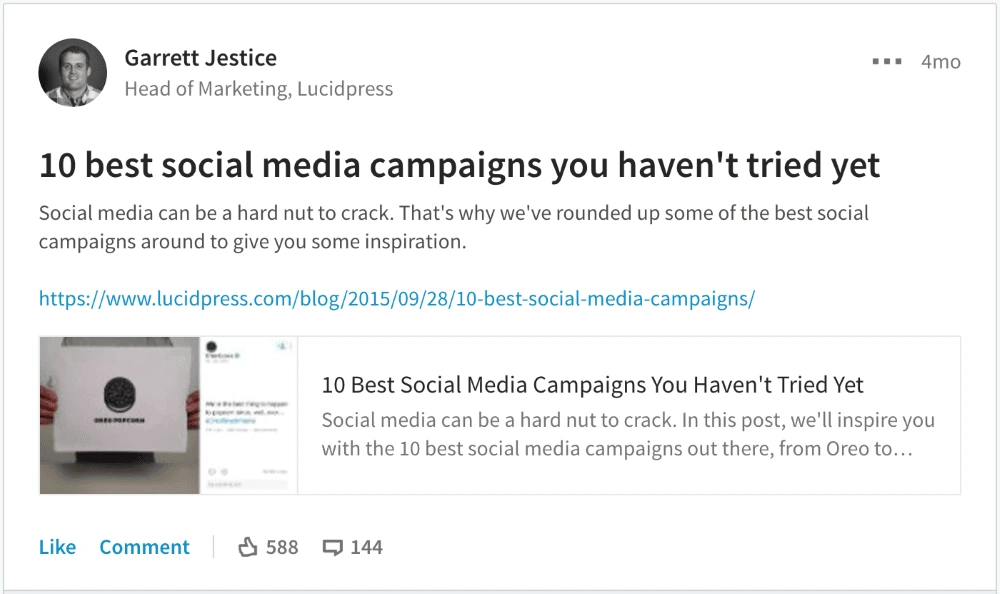
If we want to talk the talk, we’d better walk the walk.
Although Lucidpress isn’t strictly a B2B brand, we serve a large number of businesses who use Lucid’s software across various departments. To reach these businesses, we have found that it’s better to go where your audience is than to expect it to come to you. One way to do that is to join relevant LinkedIn groups and share your content with them. It’s this strategy that likely brought many of you here today, as a follow-up to one of our most successful LinkedIn conversations.
Due to the many comments and feedback in that conversation, we realized there was a content need we were not filling (that is, looking at social media from a B2B perspective), and it gave us the opportunity to serve our B2B users better.
7. Share your human side: Novartis on Facebook
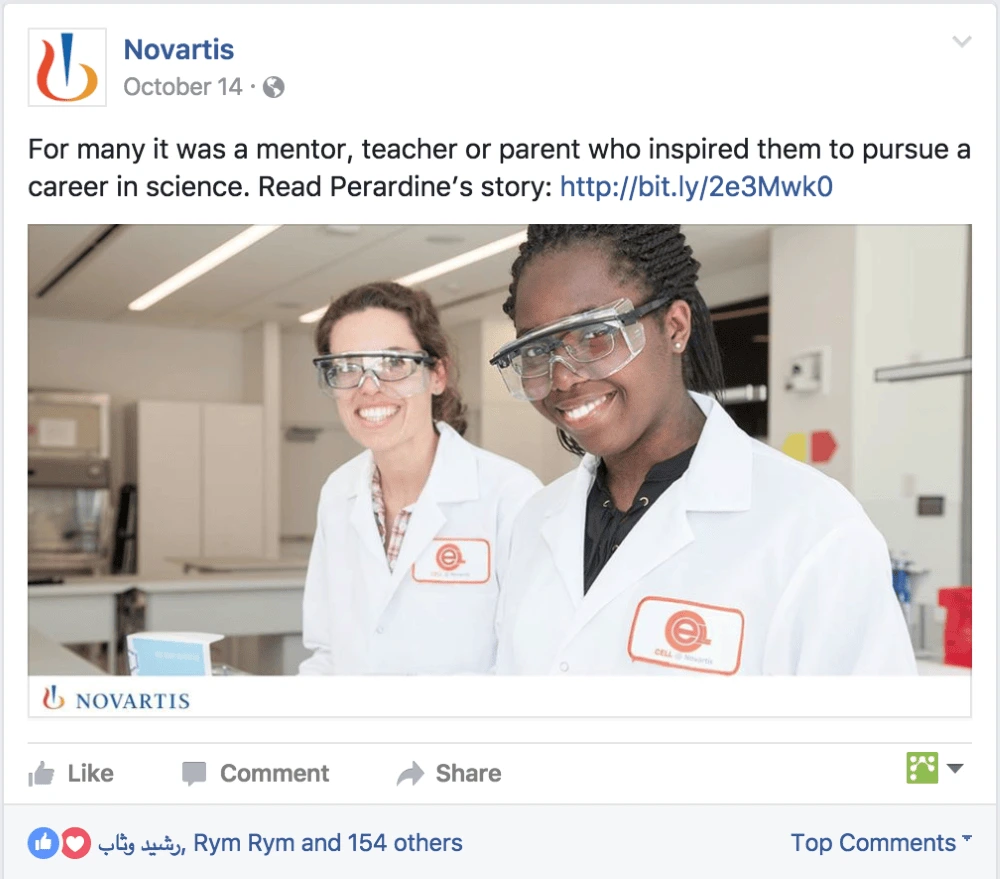
As a B2B brand, it can be difficult to express humanity online. What I mean by that is a corporation can start to feel like a faceless monolith (“We appreciate your business”) when compared to real, one-on-one connections with other people (“I’m so glad you called!”).
Novartis, the multinational pharmaceutical company, has found a wonderful way to remind us that organizations are made up of real people with unique stories and goals, by spotlighting individuals who work or intern there on its Facebook page.
The best part about this strategy is that any brand can use it, because every brand has fascinating people working behind the scenes. Take a look around your office and see who’s got a story to tell. We guarantee your users will relate and respond far better to that than to your next press release.
6. Create a community: American Express on Twitter
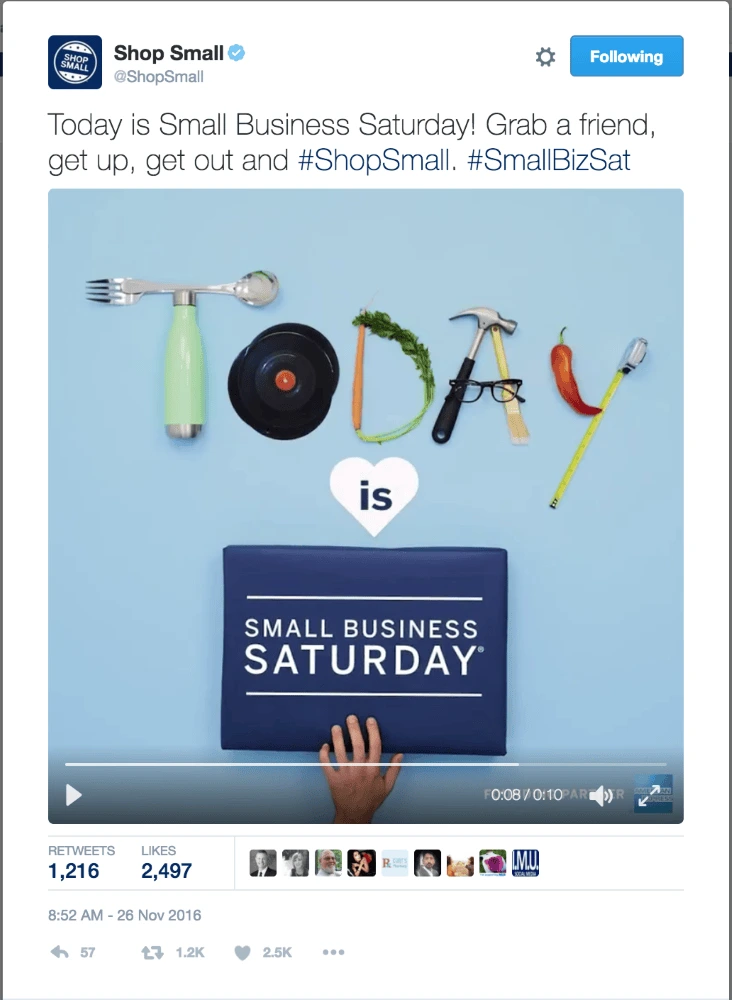
American Express has been recognized in the past for OPEN Forum, its small-business blog—and rightly so. But its dedication to serving SMBs crossed over into social media with the creation of the @ShopSmall Twitter account. @ShopSmall is active throughout the year, but things really ramp up in the fall in preparation for November’s #SmallBizSat.
If you haven’t heard, Small Business Saturday is a national holiday (first sponsored by American Express in 2010) that takes place between Black Friday and Cyber Monday. It encourages shoppers to support small and local businesses—just the kind of places American Express hopes to service.
@ShopSmall is a hyper-focused social media account that leverages the larger SMB community American Express has built over the years, and the community’s passion and enthusiasm are contagious.
5. Highlight user-created content: Maersk on Instagram

What do you get when you combine smartphone photography, shipping containers, and the open sea? For Maersk, the world’s largest container ship and supply vessel operator, you get one hell of an Instagram account. Thanks to pilots, sailors, and travel professionals around the world, Maersk has a deep well of user-generated photos to share with its 77.4k followers.
And the pictures are good. Like, really good. If you had told me that one of the best business Instagram accounts out there specialized in photos of shipping containers, I’m not sure you could’ve convinced me. But after scrolling past sun-lit ocean horizons, grand heavy ships that miraculously still float, and even the occasional double rainbow… I’m a believer.
(And, like Maersk, if you decide to use this tactic for your social media, don’t forget to credit the awesome folks who create branded content for you.)
4. Feature your customers: Square on Facebook
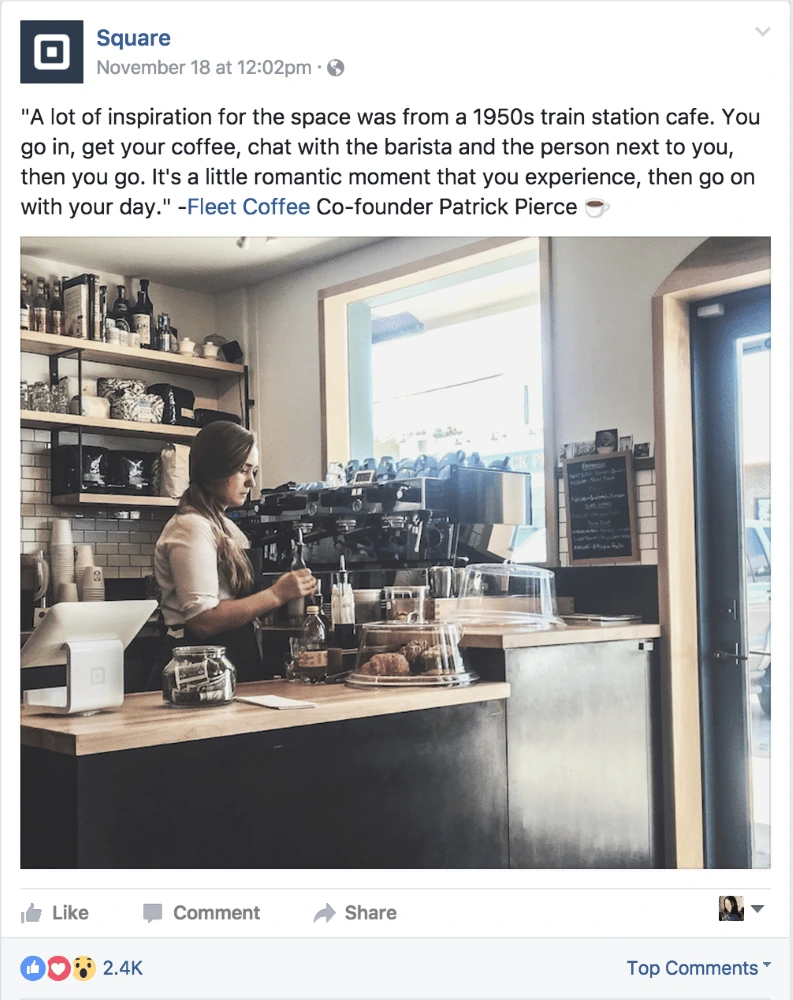
Like we learned from the Novartis example, stories about real people are compelling. But rather than turning its focus within, Square looks out towards its customers for social media inspiration.
Its Facebook page features slice-of-life photos of small businesses and the people who own them, people who depend on Square for payment processing. Next to the photo is a quote handpicked from a longer interview, where you get a glimpse into the daily lives of SMB owners around the country.
In this example, Fleet Coffee in Austin, Texas, is tagged so readers can easily visit their page. It’s not hard to imagine that this feature brought Fleet Coffee a few new followers—which is a nice way for Square to give a little bit back to the folks who keep them in business.
3. Display your culture: Intuit on LinkedIn
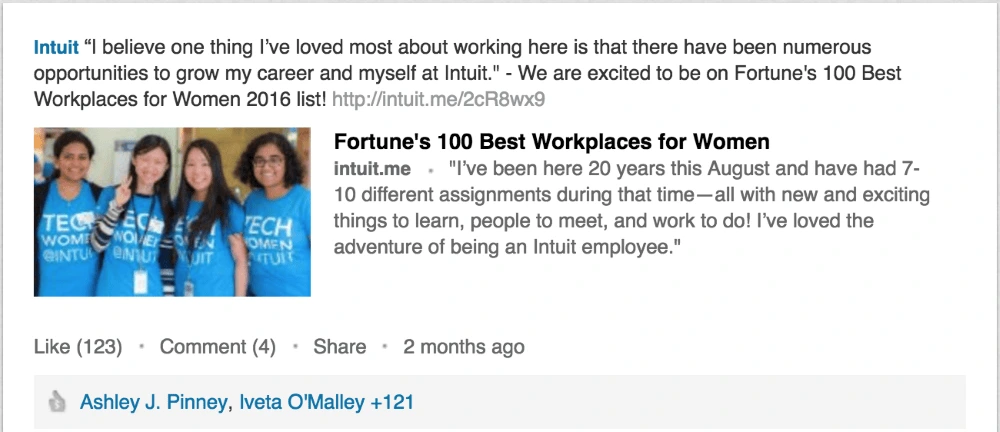
Got a company culture that you’re proud of? Share it! LinkedIn is the network of choice for business professionals, which means it’s the perfect place to share updates about awards, activities, and other exciting announcements pertaining to your company. As you can see in this update, the award shows that Intuit values a diverse culture that offers opportunities to women in tech.
Sharing what makes your company a great place to work offers dual benefits. First, it assures potential B2B clients and partners that you care about your people and will likely work hard to treat them fairly. Second, it attracts top talent who shares your values, which makes it easier to keep your culture strong. So don’t be shy—when it comes to culture, it’s okay to brag a little bit.
2. Give a peek behind the curtain: Sunnybrook Hospital on Twitter
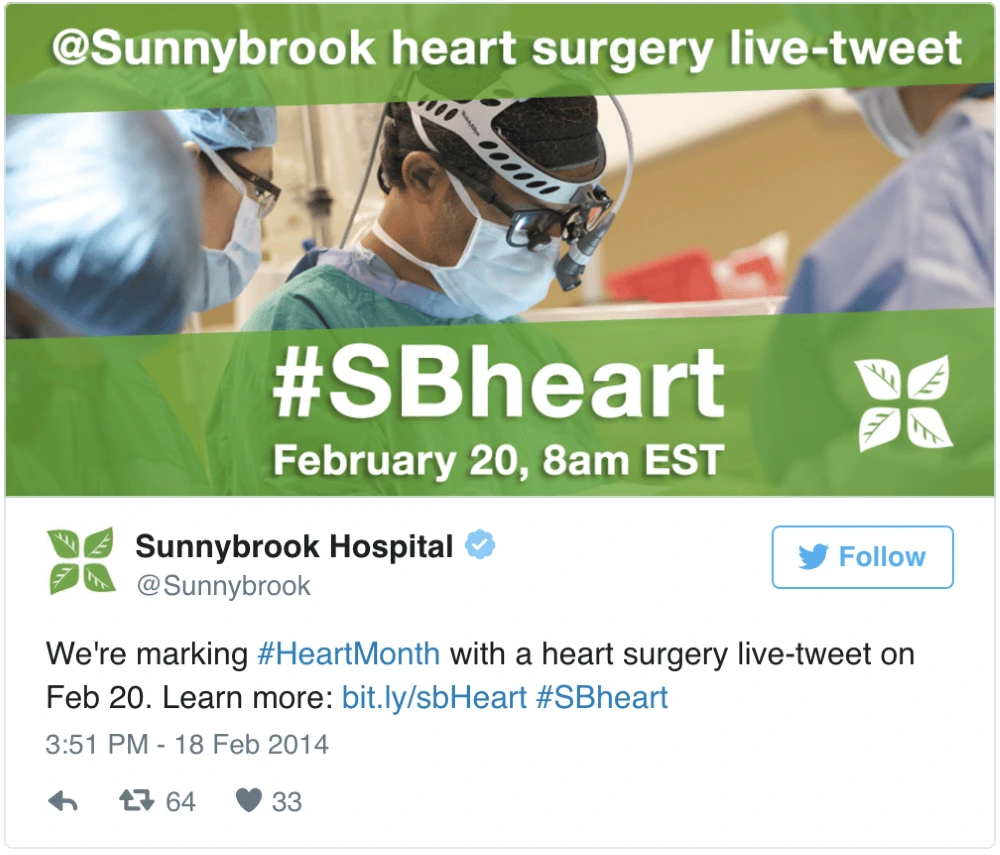
As you go about your daily work, consider that what might seem like regular routine to you could be fascinating and new for your audience. For example, take a look at the healthcare industry. Sunnybrook Hospital in Toronto, Ontario, came up with a fascinating way to give its followers a peak behind the curtain—by livetweeting a patient’s heart surgery.
As part of its efforts to raise awareness for Heart Month in February, the hospital livetweeted a coronary artery bypass graft over the course of nearly eight hours (with consent from the patient, of course). This unique use of social media attracted media coverage for their cause, which means the surgery and the strategy were both a great success.
To see the tweets, check out this Storify link (be advised: some tweets contain graphic medical content). Are there processes or procedures going on “behind the scenes” that you could share with your followers?
1. Don’t be afraid to try something new: General Electric on Instagram (Stories)
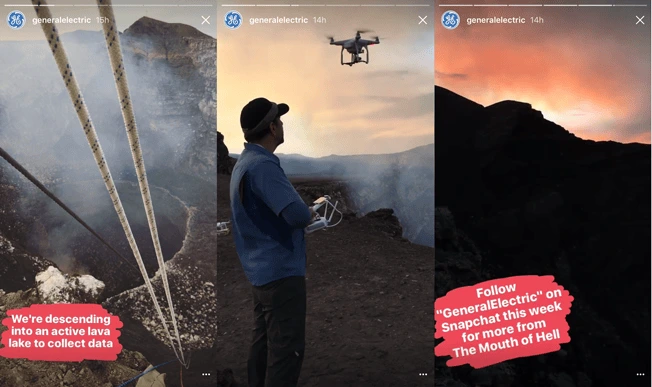
It’s almost impossible to talk about B2B social media without mentioning General Electric. The digital/industrial giant maintains a presence on all the major social networks and has earned praise for campaigns in the past like #ILookLikeAnEngineer, which highlighted women and minorities working in a white-male-dominated field. But what earns GE a spot on this list is not what they do on Facebook or Twitter.
It’s the willingness to experiment with new forms of social media, trying out innovative content and new platforms that might scare other brands away. GE was on Vine the day after it launched, it’s on Snapchat, and when Instagram launched Stories in August, GE was there with an exploration of the Masaya Volcano in Nicaragua.
While it might not keep or update every platform, GE strikes while the iron is hot and earns valuable views in the process.
It turns out that, with a little ingenuity, B2B brands can make just as big a splash on social media as any other brand. Next time you’re planning a social media campaign, try out some of these ideas.
How can you compete with the best social media campaigns? First of all, you need to know your customers well. To interact with them in a friendly way, you need to understand their desires and interests. Then it’s time to brainstorm and put your best social media campaign ideas into action. With hard work, you can run a clever, successful social media campaign that takes your brand to the next step, whether that’s getting it on the map or earning a million more customers.
Eager to adapt your brand to social media channels? Grab a copy of our free eBook: How to adapt your brand to social media
By now, we’ve all heard how social media can support a brand and make it easier to connect with customers. But not all of us have the benefit of being a consumer-facing brand like Pepsi, Domino’s, or Oreo. If you’re representing a B2B brand, can you still take advantage of social media? Absolutely!
Is your brand new to social media? Grab a copy of our free eBook: How to adapt your brand to social media
As a follow-up to one of our most popular posts, here are 10 of our favorite examples of B2B brands using social media to build their brands and make an impact online.
10. Build brand awareness: MailChimp on Instagram
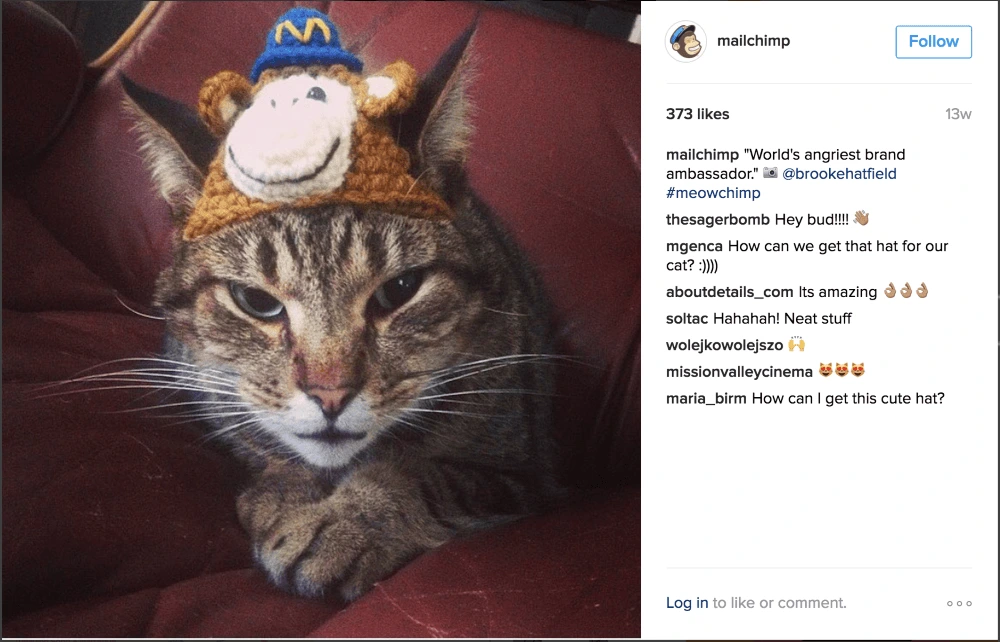
If you take a cursory glance at MailChimp’s Instagram account, one thing is immediately clear: That gosh-dang monkey is everywhere. (Forgive my crude Utah language.) But there’s a good reason for it. “Freddie” the monkey has been MailChimp’s loyal brand ambassador since the beginning, and while he’s gone through a few changes over the years, his fun personality still shines through.
As a visual platform, Instagram is specially suited to sharing Freddie’s shenanigans and encouraging MailChimp fans to do the same. From figurines to knitted caps, he is a constant reminder of the brand without being too ‘on the nose’, and he keeps MailChimp top-of-mind for its followers. (Bonus tip? On the internet, you can never go wrong with cats.)
9. Show off your expertise: Huawei on Twitter

Huawei is the largest manufacturer of telecommunications equipment in the world. Yet, if you asked the average American, it’s unlikely they’d know much about this giant company headquartered in China. That hasn’t stopped the brand from embracing social media in various countries and building up an appreciative audience for its content.
Huawei spotlights innovative technology trends and predictions for the future, inviting experts to weigh in on the tough questions (“Can AI ever function like a human?”) that make for rich conversations. Its Twitter timeline is chock-full of thought-provoking quotes from industry leaders.
By taking the time to create smart, dense content, Huawei sets itself apart from other social media accounts who find it easier to keep things fluffy.
8. Join relevant groups: Lucidpress on LinkedIn
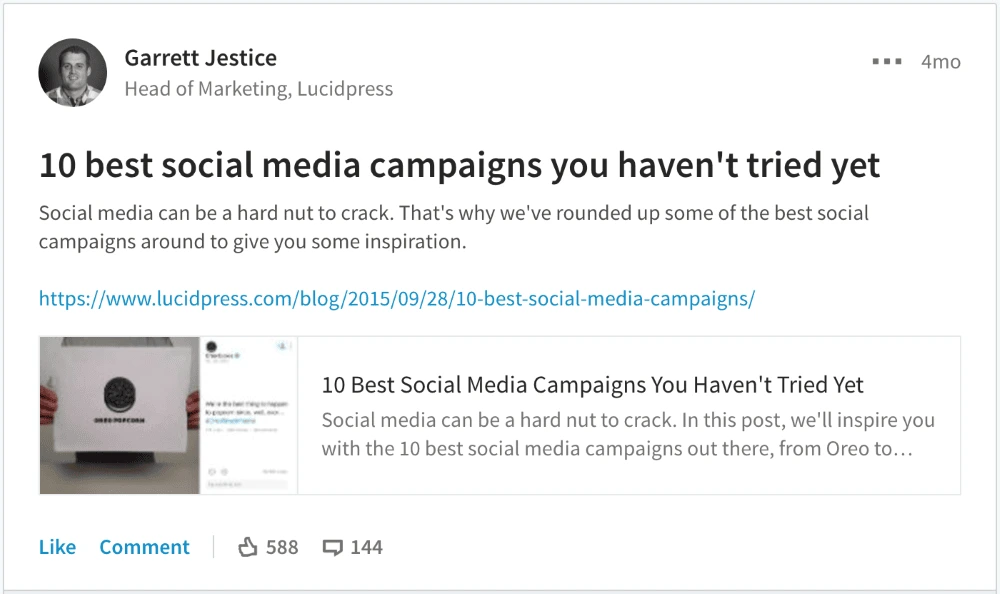
If we want to talk the talk, we’d better walk the walk.
Although Lucidpress isn’t strictly a B2B brand, we serve a large number of businesses who use Lucid’s software across various departments. To reach these businesses, we have found that it’s better to go where your audience is than to expect it to come to you. One way to do that is to join relevant LinkedIn groups and share your content with them. It’s this strategy that likely brought many of you here today, as a follow-up to one of our most successful LinkedIn conversations.
Due to the many comments and feedback in that conversation, we realized there was a content need we were not filling (that is, looking at social media from a B2B perspective), and it gave us the opportunity to serve our B2B users better.
7. Share your human side: Novartis on Facebook
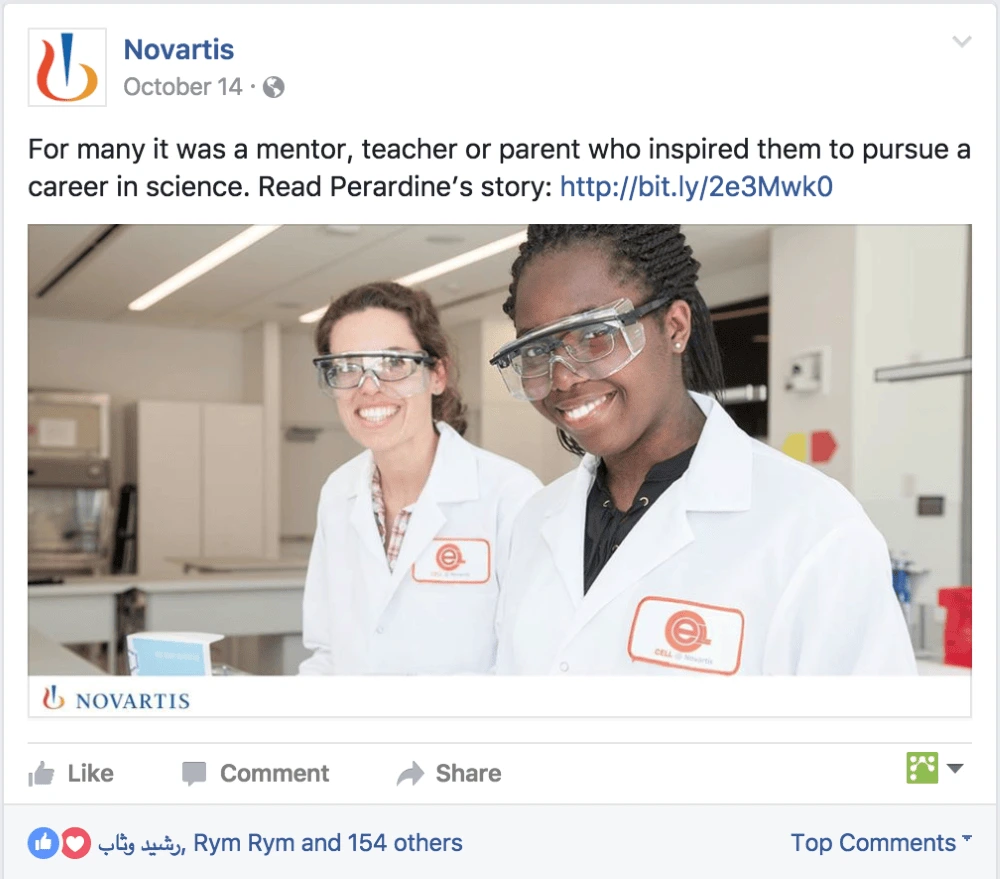
As a B2B brand, it can be difficult to express humanity online. What I mean by that is a corporation can start to feel like a faceless monolith (“We appreciate your business”) when compared to real, one-on-one connections with other people (“I’m so glad you called!”).
Novartis, the multinational pharmaceutical company, has found a wonderful way to remind us that organizations are made up of real people with unique stories and goals, by spotlighting individuals who work or intern there on its Facebook page.
The best part about this strategy is that any brand can use it, because every brand has fascinating people working behind the scenes. Take a look around your office and see who’s got a story to tell. We guarantee your users will relate and respond far better to that than to your next press release.
6. Create a community: American Express on Twitter
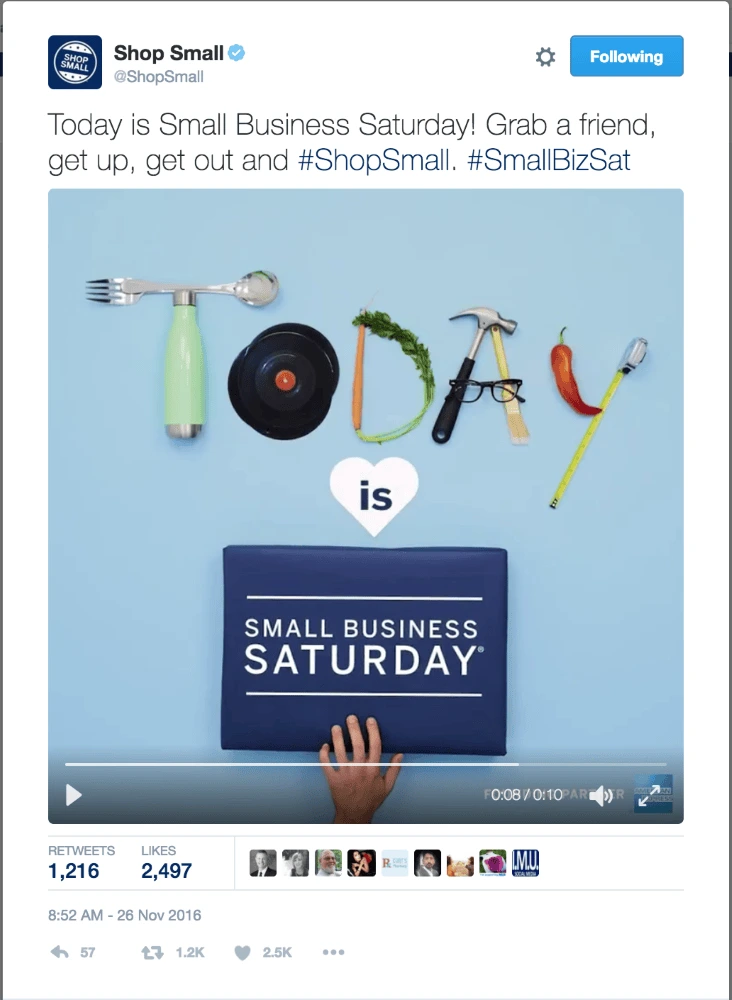
American Express has been recognized in the past for OPEN Forum, its small-business blog—and rightly so. But its dedication to serving SMBs crossed over into social media with the creation of the @ShopSmall Twitter account. @ShopSmall is active throughout the year, but things really ramp up in the fall in preparation for November’s #SmallBizSat.
If you haven’t heard, Small Business Saturday is a national holiday (first sponsored by American Express in 2010) that takes place between Black Friday and Cyber Monday. It encourages shoppers to support small and local businesses—just the kind of places American Express hopes to service.
@ShopSmall is a hyper-focused social media account that leverages the larger SMB community American Express has built over the years, and the community’s passion and enthusiasm are contagious.
5. Highlight user-created content: Maersk on Instagram

What do you get when you combine smartphone photography, shipping containers, and the open sea? For Maersk, the world’s largest container ship and supply vessel operator, you get one hell of an Instagram account. Thanks to pilots, sailors, and travel professionals around the world, Maersk has a deep well of user-generated photos to share with its 77.4k followers.
And the pictures are good. Like, really good. If you had told me that one of the best business Instagram accounts out there specialized in photos of shipping containers, I’m not sure you could’ve convinced me. But after scrolling past sun-lit ocean horizons, grand heavy ships that miraculously still float, and even the occasional double rainbow… I’m a believer.
(And, like Maersk, if you decide to use this tactic for your social media, don’t forget to credit the awesome folks who create branded content for you.)
4. Feature your customers: Square on Facebook
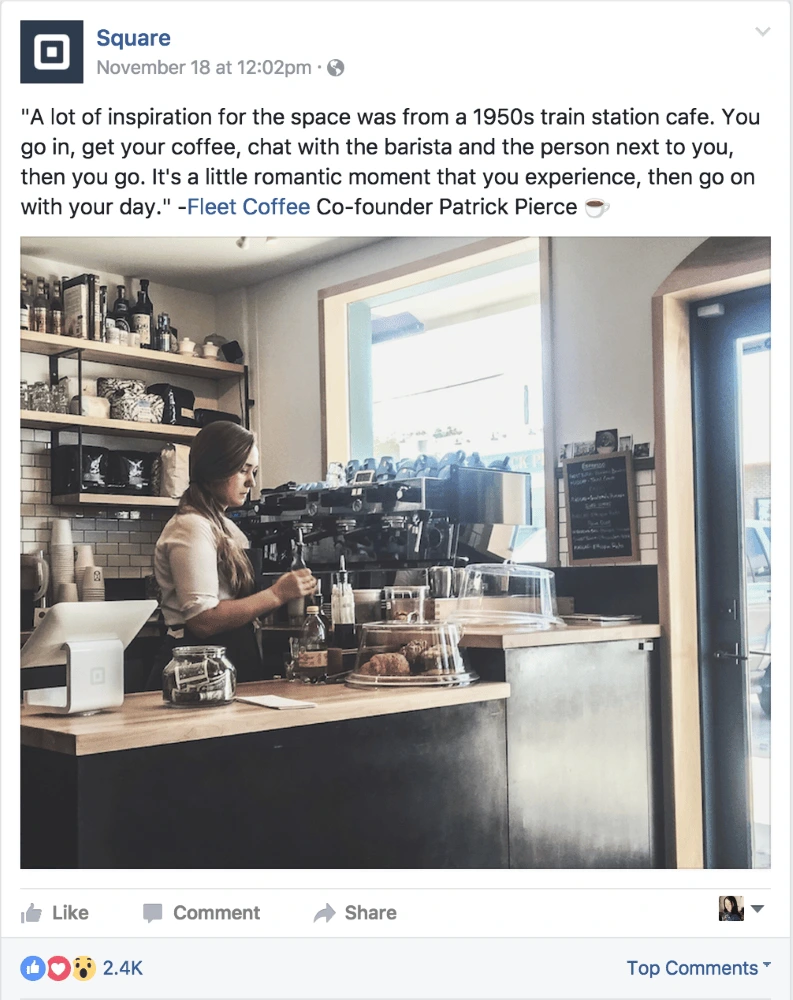
Like we learned from the Novartis example, stories about real people are compelling. But rather than turning its focus within, Square looks out towards its customers for social media inspiration.
Its Facebook page features slice-of-life photos of small businesses and the people who own them, people who depend on Square for payment processing. Next to the photo is a quote handpicked from a longer interview, where you get a glimpse into the daily lives of SMB owners around the country.
In this example, Fleet Coffee in Austin, Texas, is tagged so readers can easily visit their page. It’s not hard to imagine that this feature brought Fleet Coffee a few new followers—which is a nice way for Square to give a little bit back to the folks who keep them in business.
3. Display your culture: Intuit on LinkedIn
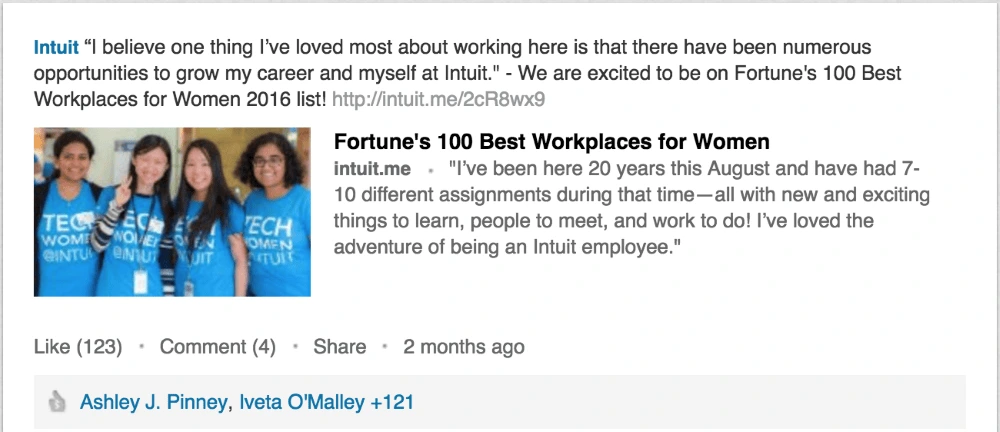
Got a company culture that you’re proud of? Share it! LinkedIn is the network of choice for business professionals, which means it’s the perfect place to share updates about awards, activities, and other exciting announcements pertaining to your company. As you can see in this update, the award shows that Intuit values a diverse culture that offers opportunities to women in tech.
Sharing what makes your company a great place to work offers dual benefits. First, it assures potential B2B clients and partners that you care about your people and will likely work hard to treat them fairly. Second, it attracts top talent who shares your values, which makes it easier to keep your culture strong. So don’t be shy—when it comes to culture, it’s okay to brag a little bit.
2. Give a peak behind the curtain: Sunnybrook Hospital on Twitter
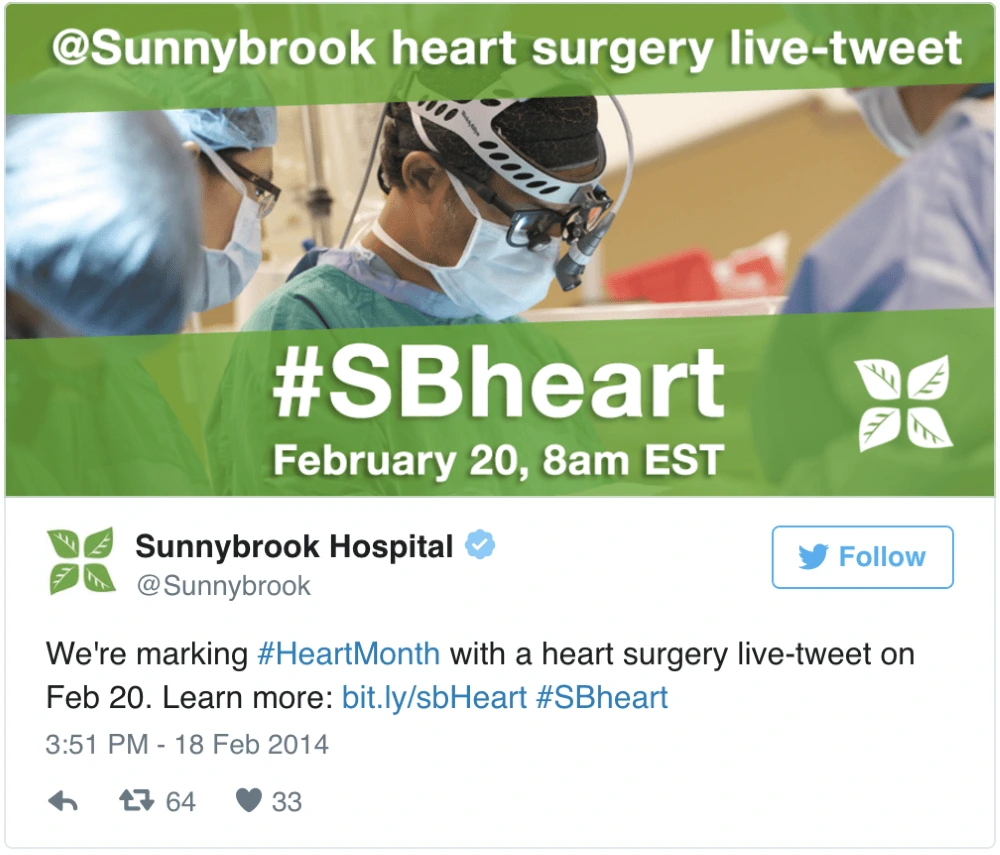
As you go about your daily work, consider that what might seem like regular routine to you could be fascinating and new for your audience. For example, take a look at the healthcare industry. Sunnybrook Hospital in Toronto, Ontario, came up with a fascinating way to give its followers a peak behind the curtain—by livetweeting a patient’s heart surgery.
As part of its efforts to raise awareness for Heart Month in February, the hospital livetweeted a coronary artery bypass graft over the course of nearly eight hours (with consent from the patient, of course). This unique use of social media attracted media coverage for their cause, which means the surgery and the strategy were both a great success.
To see the tweets, check out this Storify link (be advised: some tweets contain graphic medical content). Are there processes or procedures going on “behind the scenes” that you could share with your followers?
1. Don’t be afraid to try something new: General Electric on Instagram (Stories)
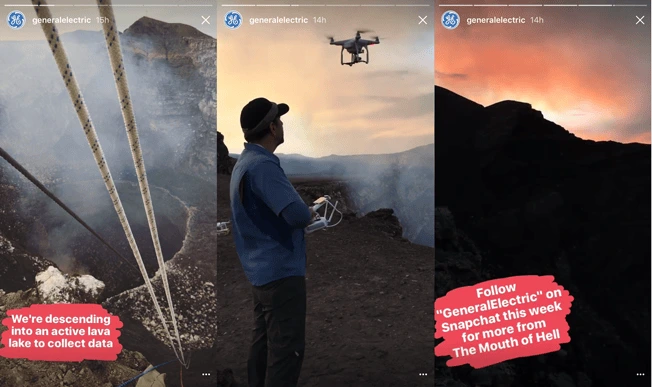
It’s almost impossible to talk about B2B social media without mentioning General Electric. The digital/industrial giant maintains a presence on all the major social networks and has earned praise for campaigns in the past like #ILookLikeAnEngineer, which highlighted women and minorities working in a white-male-dominated field. But what earns GE a spot on this list is not what they do on Facebook or Twitter.
It’s the willingness to experiment with new forms of social media, trying out innovative content and new platforms that might scare other brands away. GE was on Vine the day after it launched, it’s on Snapchat, and when Instagram launched Stories in August, GE was there with an exploration of the Masaya Volcano in Nicaragua.
While it might not keep or update every platform, GE strikes while the iron is hot and earns valuable views in the process.
It turns out that, with a little ingenuity, B2B brands can make just as big a splash on social media as any other brand. Next time you’re planning a social media campaign, try out some of these ideas. Did we miss any of your favorites? Share them in the comments below!
Is your brand new to social media? Grab a copy of our free eBook: How to adapt your brand to social media
If you’re serious about upping your social media game, then brand consistency is key.
Many new businesses underestimate the amount of time and effort that goes into creating a social media presence that counts, and social media marketing is often seen as a cheap and cheerful way to spread the word about your business. While social media can be a fun and cost-effective marketing tool, it does eat up a lot of time. If you’re keen to invest that time in developing social feeds that make a difference to your business, you’ll need to have social media guidelines for keeping your brand consistent.
Related: How to drive traffic with social media
5 benefits to brand consistency on social media
Accomplishing brand consistency on social media isn’t easy, but it is achievable. Before we tackle how you can achieve it, let’s first consider why it matters.
It makes you memorable.
There are 500 million tweets sent every day, with 6,000 going out every second. When users see online content from a brand they can easily recognize, they’re more likely to remember them in the future, both online and offline.
It increases customer engagement and loyalty.
If customers remember and recognize a brand, they’ll feel much more comfortable interacting with them. Likewise, customers are more likely to stay loyal to brands who deliver a consistent message.
It helps you stand out from the crowd.
Having a brand that is easily recognized will help to set you apart from your competitors. There are 6 Facebook profiles created every second, resulting in around 500,000 new users every day. If you’re not consistent in branding your business across the various platforms you use, it can be easy to get lost in the crowd.
It gives you authority.
Branding that’s done well looks professional. It builds trust because it tells your audience that you know what you’re doing and you care about the details.
It makes you relatable.
Using social media to show the unique personality of your brand is an effective way of helping customers relate to you.
Tips for branding your social profiles consistently
To achieve visual brand consistency when setting up your social profiles, there are a few key things you’ll need to remember.
Names & handles
If you want your customers to be able to find you easily as they move from one platform to another, it’s important that your name and handle is the same wherever you are.
Colors & logos
Even before they read your name or bio, visitors will register your logo and the colors you’ve used. Make sure that these two things represent your brand in the right way. They should match your website and any other communications that go out to your customers.
Taglines
If your business has a tagline, display it prominently on your social profiles. Taglines are memorable, and using yours consistently will help your customers recognize you.
Still working on your brand basics? Read more: The 7 key elements of brand identity design
3 questions to ask before you start posting
Next, we’ll look at keeping your brand consistent when you post on social media—but before we do, here are a few important questions you’ll need to have the answers to.
Who is your audience?
The internet has 3.77 billion users and 2.78 billion of those are active social media users. To ensure your social media content is directed at the right sort of people for your business, you’ll need to understand a few things about your target audience. How do they identify themselves? What are their interests? What motivates them?
Who is the audience on each network?
Not everyone is on every social network, and if they are on two or more, it’s likely for different reasons. Consider what your target audience expects when they visit each social platform and how you can provide the content they’re looking for.
Social media management platform Hootsuite predicts growth in the following themes for 5 top social platforms:
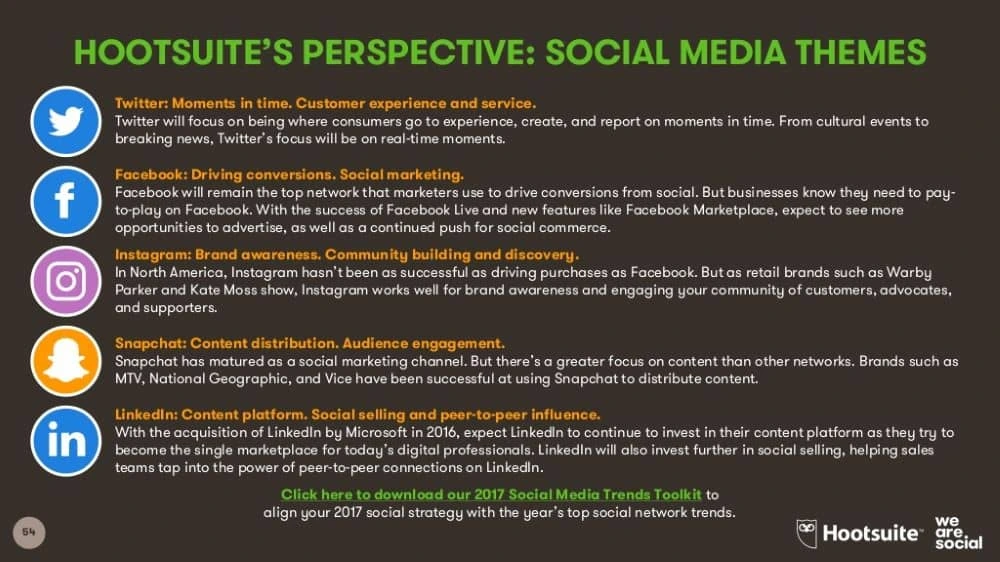
What language and tone will you use?
Deciding in advance whether you’ll use “we” or “I,” whether you’ll be funny or serious, and whether you’ll stick to perfect English or use slang and text-speak is an important move. There’s no wrong answer, it’s just about deciding what’s right for your audience. Once you know, make sure everyone in your business who posts is consistent.
Tips for social media posts with brand consistency
Once you’ve got answers to the questions above, you can start to think about when and how you’ll post and what you’ll share where.
Don’t just advertise.
The most successful brand accounts have a following because they offer something that their followers value. If you’re using social media just to promote and advertise, your audience will unfollow. What else will you offer: Promotions? Behind the scenes insight? Helpful information? Technical support? If you’re not sure where to start, check out the competition and see what works for them.
Post regularly and consistently.
Creating a social media account that stands unused can be harmful to your business. If a customer searches for you and sees that you haven’t posted for a while, they may assume that your business has closed.
Posting consistently can also help you develop a relationship with your audience and increase engagement. If they know when to expect a certain type of post from you that they appreciate, they’ll look out for it and may even begin to interact with you.
Consider your posting frequency per platform.
Posting regularly doesn’t have to mean posting all the time. It’s about quality over quantity. The frequency of your posts should depend on both the relevancy of your content and the platform you’re using. Do some research to find optimal times for posting based on platform and then set a schedule. There are free tools available online that will help you stick to it.
Curate content that fits.
Creating quality content for multiple social media platforms is a full-time job and, if your business is small, you simply might not have the resources. But you shouldn’t let that stop you from posting regularly. Sharing content from other people and businesses that echo your brand’s message is an effective way to keep the ball rolling while you’re working on other things.
Repurpose old content.
Likewise, there’s no reason why you shouldn’t repurpose old content. Share old posts that recent followers may have missed, or transform the content into something new. You could create an infographic from a long blog post, for example, or try breaking it up into smaller pieces and expanding on each one.
Don’t be repetitive.
While it’s important to post regularly, you should be aware of sounding repetitive. Don’t bombard your followers with the same message again and again, and be careful not to publish the exact same post across all your channels at the same time. Active social media users tend to jump from platform to platform within the space of minutes—if they’re seeing the exact same post from you wherever they go, they’ll start to feel overwhelmed by your content.
With that being said, if you’re running a big promotion or have an important announcement, you should certainly feature it across all of your social platforms. Instead of sending it out across multiple channels at one time, consider when the best times for posting on each channel are and stagger your message accordingly.
Link & cross-reference.
Don’t forget to link and cross-reference your social accounts. If you’re running a special promotion on Facebook, let your Twitter followers know. Likewise, if you have some content on Snapchat that you’re proud of, mention it on Instagram. Try only to do this when you have something your followers will appreciate—do it too much and you risk being repetitive.
Document your brand guidelines
There’s a lot to understand and remember, isn’t there?
If you’re committed to developing a social media presence that is both beneficial to and consistent with your brand, it’s worth considering documenting your brand guidelines.
Learn more about brand guidelines: 10 examples of great brand guidelines
Key takeaways
To achieve brand consistency on social media:
- Take care to ensure your profiles look similar and that they match your overall brand identity, including your website, newsletters and any other communications that go out to your customers.
- Make sure you know exactly who your posts are directed at and how you’ll communicate consistently with those people.
- Develop a social media content plan that outlines when and where you’ll post and how often. Work on ideas in advance and don’t be afraid to repurpose and curate, as long as you’re sticking with your overall brand message.
Ready to drive more brand awareness with social media? Grab a copy of our free eBook: How to adapt your brand to social media
You don’t need rocket science to see how social media has changed the dynamics of business. It’s almost impossible for a new brand to establish itself without a prominent presence on social media channels. Companies these days use popular platforms like Twitter, Facebook, Instagram, Pinterest and others to boost their online profiles.
Most of us already know how to use these channels, and we see how businesses use them to their advantage to build a strong social media following.
For example, check out this round-up of 10 highly effective social media campaigns.
But there are still effective tactics and strategies that not everyone is aware of, and even now, few brands apply them all to their own online presences. Let’s review a few tried-and-true ways to drive traffic (and leads) with social media marketing.
1. Informative content
We’ve all heard by now that content is the king. We know this in theory, but in practice, it’s more complicated than a simple maxim. Well-crafted content that speaks to a specific target market’s questions and pain points can bring amazing results. A regular cadence of posts will build a bond of trust between a brand and its followers. Interaction through social media also builds that trust, and those long-lasting relationships translate into loyal sales and strong word of mouth better than most mediums.
There are lots of ways to build informative content:
- Case studies
- Ebooks
- Infographics
- Webinars
- White papers
According to research, 78% of customers find custom content useful and believe that companies providing content are interested in building long-term relationships with them. To create amazing social content, search for trending keywords on platforms like BuzzSumo, Social Animal or Sprout Social—then create informative blogs & pages around your findings.
2. Visual appeal
Visitors to a website decide in a split second whether they want to check out the whole thing or leave it. Visual appeal is all about capturing their attention and curiosity, which in turn will improve their engagement and boost the number of pages they visit. These principles apply to social media, too.
There are many ways to add visual appeal to your social content:
- Custom photography
- Artistic designs
- Screenshots
- Infographics
- Data visualization
- Trending memes
As a savvy social brand, it’s up to you to decide how to use these visual assets across the social media channels that would be most effective for your audience. Make sure you understand the culture and purpose of each platform, so that the content type you choose fits the context.
3. Vibrant video
Depending on how a visitor feels in the moment, reading an 800-word blog post might be too much—so they skip it. Alternatively, a strong 20-second video is easily understood and highly effective. That’s why many brands use video to grab attention from social media followers. But know this: the idea, message and execution of the video must work well together, otherwise the effect will be lost.
To make a strong video, create 2 to 3 drafts of the content and ask your team to choose the best one. Then decide where to host the video, keeping in mind that many social platforms (like Facebook) prioritize native video over external links. But, also consider that video-sharing portals like YouTube, Vimeo or Dailymotion can extend your reach.
If you strike gold, your video might even go viral. Just imagine what that could do for your brand!
4. Brand personality
In today’s brand-driven marketplace, it’s all about image and perception. No one stays loyal to a brand simply for the sake of buying a product—the brand’s reputation, the company’s philosophy, and the lifetime value it gives to the customer are all taken into consideration. For a small or medium-sized business, it can be difficult to compete with big, established brands. That’s where the power of social media can make a huge difference.
Quality products and services are vitally important, of course—but the way a company builds its community and nurtures its relationships really does matter. The marketing team must think deeply about the brand’s personality and purpose to achieve brand consistency on social media, which in turn will empower the company to have more meaningful, authentic interactions with its customers.
5. Communication tips
There are a lot of social principles to remember when building a strong online presence. Some can be used across various social channels, and they can be the catalyst a company needs to get the brand up and running.
Here are a few communication tips that can be applied across the board:
- Reply to all comments, quickly if possible.
- If someone shares a complaint, apologize and follow up when the issue is resolved. Visitors can grow angry if their grievances are not addressed in time.
- If someone reports an error or bug, thank them for reporting and investigate the error to resolve it as quickly as possible.
- Approve invitations and friend requests to grow your list of followers (and potential customers).
- Maintain a healthy balance between posting original content and sharing content curated from others. Both serve a valuable purpose in building your brand and attracting followers.
By following these strategies and tactics, you should be well on your way to building a strong, active brand presence on social media—and driving traffic to your site. Give these a try and let us know what’s worked best for you!
Eager to adapt your brand to social media channels? Grab a copy of our free eBook: How to adapt your brand to social media
Social media marketing has immense potential for helping you attract brand awareness, website traffic, and even new customers. Even so, many brands remain skeptical of marketing on social media, because they’ve been unable to achieve their goals with it.
Is your brand present on social media? Grab a copy of our free eBook: How to adapt your brand to social media
The underlying issue could lie with any one of a host of decisions responsible for social media success, such as content, timing or campaign implementation. To give your brand the best chance at success, here are 7 social media mistakes to avoid.
1. Paying for poor shortcuts
Many marketers fall prey to the game of vanity numbers—a game that’s hard to recover from once it’s started. Remember: the size of your following doesn’t matter as much as the number of real engagements on your social media pages.
The focus of any social campaign should be to engage and delight your target audience. If an agency promises to quickly increase your page’s likes or follows, it’s likely to rely on underhanded strategies.
Unfortunately, likes purchased in bulk are worthless, because they won’t be from authentic fans and followers who buy from you or positively contribute to your online presence.
Instead: Invest in creating great content and organically engaging your audience instead of trying to buy their interest. One great way to do this is to reach out to the experts in your niche, share content created by them, and build a rapport in the community.

You could use a content curation app to source fresh, organic content that’s related to your niche, and then drive engagement with it. (Full disclosure: I work with DrumUp.)
2. Outsourcing without context
Brands who outsource their social media marketing usually do so because they believe it’s less expensive and time-consuming than building an in-house team. But is it?
You must totally, fully, completely trust the agency you choose to represent you online. Because if you don’t, and your decision backfires, it could be a disastrous mistake.
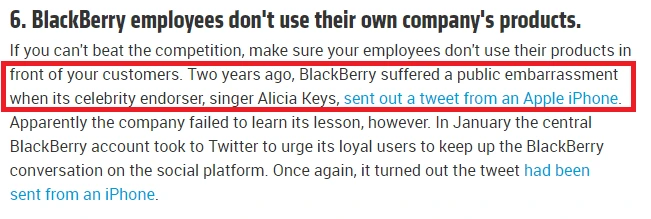
Even when you’re working with a reputable agency that isn’t likely to make such a mistake, there’s always a risk of being misrepresented, failing to capture your brand’s essence, or misunderstanding your expectations.
Instead:
- Communicate your brand’s vision, feel and personality.
- Set firm, clear goals and guidelines.
- Establish an approval system.
- Keep the line open for communication.
3. Being overly self-promotional
Being openly commercial has nearly become a faux pas in today’s online marketplace. Your audience is tired of ads—as the spike in ad-blocking clearly demonstrates. Nobody wants to be sold at anymore. They want to be befriended, entertained and wooed.
Instead, you should curate content and use your social media pages to establish your brand as a source of useful information and entertainment.
For example, Moz both creates and curates SEO-related content, which has made them the ultimate go-to for SEO on Twitter.

Takeaway: Curate entertaining or informational content that your audience will like. It doesn’t always have to be created by you. Find the balance, and don’t over-share your promotional content.
4. Spamming fans’ feeds
There’s no universal posting frequency that everyone should follow. Actually, it depends on your posts’ reach and impressions. Based on those statistics, you can select your frequency and time intervals for posting.
You can and should share a good blog post more than once. But avoid spamming your fans’ feeds with the same content over and over in a short period of time.
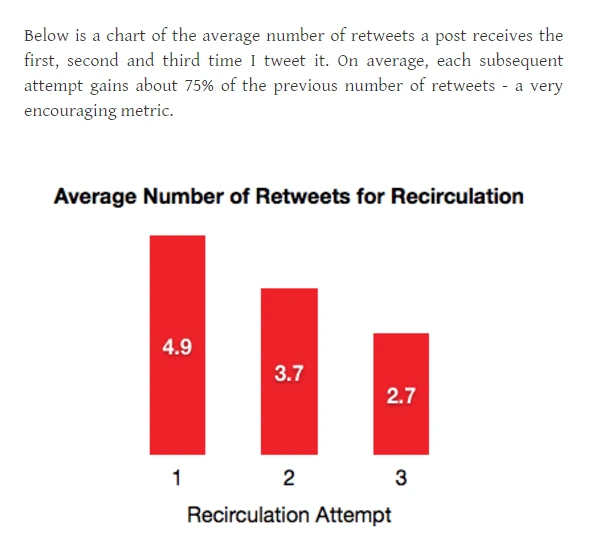
Instead:
- Create variations of a post with different lead-ins, featured images, and points of focus.
- Consider ways to re-purpose your content and share it in different formats.
- Share at different time intervals on different days, so your content reaches a wider audience and has a lower risk of showing up in the same fan’s feed.
5. Ignoring fan feedback
Studies show that 72% of customers expect a response within an hour when they post complaints on brand pages. When they don’t get one, they’re likely to think negatively about the brand.
How you handle negative feedback and the time you take to respond both matter.
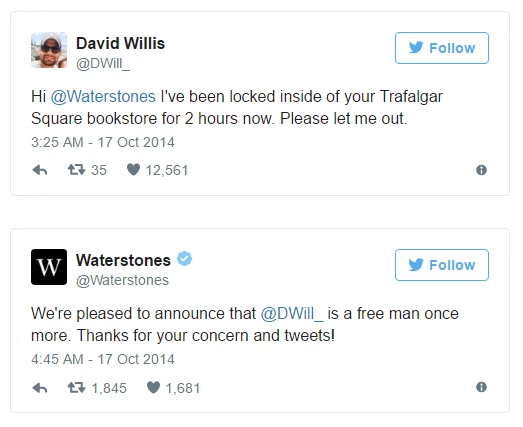
People are very likely to head to social media to post feedback, ask questions and complain, because it’s accessible and easy to do. That’s why many brands invest in full-time social media listeners and monitoring tools to help them maintain their brand’s reputation.
Takeaway: Never ignore fans on social. Acknowledge how they feel, and do your best to diffuse negative situations quickly. There are several social features like emoticons, GIFs and live video streaming that you can use to make followers feel like they’re being heard by other human beings.
6. Operating sans-analytics
Operating without analytics is like speaking without listening. [![]() ] Without analytics, there’s no way to know how your content is being received and whether it’s helping you move toward any goals.
] Without analytics, there’s no way to know how your content is being received and whether it’s helping you move toward any goals.
Every interaction on social media is feedback that you should consider when reviewing and refining your social media strategy. It’s also wise to track the flow of traffic, so you can learn which social platform is best for your brand.
Instead of flying blind:
- Measure important metrics like referrals, reach, impressions, engagement, leads, conversions, follower growth rate and mentions.
- Review your performance regularly, and take remedial measures to increase traction.
- A/B test your most important posts to optimize conversions.
7. Not being human
Humans are irrational and emotional beings, and this affects our decisions and how we feel about other people, situations, and even brands.
If you aren’t displaying your human side on social, you’re throwing away the ability to build lasting connections with your target audience.
Many brands invest in experienced marketing managers who specialize in building brand personalities and ensuring that they’re expressed through various channels.
Takeaway: Assign your brand a human personality that you can ‘be’ on social media. For instance, Old Spice sounds like a confident man with sophisticated, slightly dry humor.
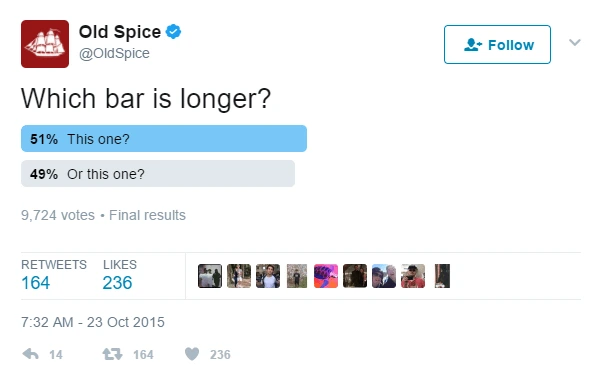
Another great idea is to put the spotlight on team members and customers who make your brand special.
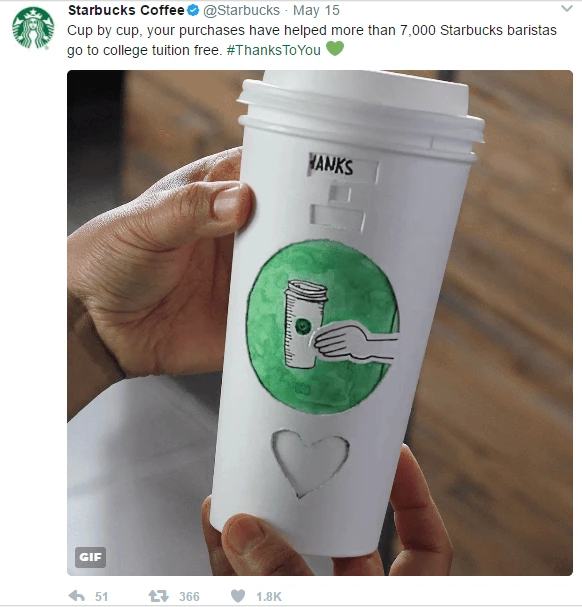
By taking care to avoid these mistakes, you’ll give your brand a leg up in the social media scene. Take a look at your social channels today and seize new opportunities to make an impact.
Ready to drive more leads and engagement with social media? Grab a copy of our free eBook: How to adapt your brand to social media
Instagram is the second-most popular social media platform, following Facebook. Currently, this photo-sharing platform has more than 700 million users and gets more than 4.2 million likes on its posts every day.
And since Instagram has opened its floodgates for businesses to advertise on the platform, marketers are jumping at the opportunity to appear in the news feeds of their target customers. And why wouldn’t they? A study conducted at the end of 2016 claimed that Instagram has 20x more engagement than Twitter and 15x more than Facebook.
Related: Free Instagram post templates
However, it’s also true that many businesses are failing to convince Instagram’s proactive and highly engaged user base to tap their advertisements. And it’s not just small brands—big names like Coca-Cola, Victoria’s Secret and McDonald’s also fail to capture Instagram’s full potential.
What mistakes are these brands (and yours) making which prevent them from mastering one of the fastest-growing social media platforms?
Let’s review the common missteps brands make while advertising on Instagram so that you have a checklist of what not to do.
1. You’re not being unique enough
Remember, there are lots of brands on Instagram vying for attention, some of which have similar products and target audiences as yours. Just as you compete with so many brands on the market, you compete for space and share of mind online. So how are you differentiating your brand from other brands with the content you create and share?
2. You have bad timing
When you post on any social media platform, the timing matters a lot. Though Instagram’s algorithm is relevance-based rather than time-based (that is, it generates users’ feeds based on their interests and activity rather than showing all items chronologically), you should still post at times when people check their social media apps the most. This will make it more likely that your content is seen, liked and shared—and the algorithm will amplify its exposure.
3. Your content is not focused enough
Instagram is not the place for crowded infographics or random pictures. Be thoughtful about the ongoing theme and presentation of your posts. Every user scrolling through their feed only stops to look at a post carefully if it catches their eye and speaks to their values. The better your content is focused around a relevant niche, the more chance a user will stop and absorb your post.
4. Your pictures are low-quality
Instagram is a visual platform, and people who use it regularly expect a certain level of aesthetic quality. Make sure your original photos are shot with proper lightning and in high resolution. If you use stock images, make sure they feel authentic. Keep the editing to a minimum so your images don’t look fake.
5. You don’t post frequently enough
Most brands believe that posting once or twice a day should be sufficient. However, according to a Union Metric study, brands that post once an hour enjoy higher engagement rates on all of their content—both posts and advertisements. Turns out that, in this case, more is more.
6. You’re misusing hashtags
It’s vital to understand the significant role that hashtags play on Instagram. Using too many, too few or simply the wrong ones—all of these can prove disadvantageous for your brand. Before using a hashtag, do some research to see what it’s primarily being used for. Aim for a few short hashtags that don’t distract from your message, so new people can find you but your current followers aren’t annoyed.
7. Your business account is private
Yes, it really does happen. There’s no good reason to keep your business account private, because the entire idea is to reach new audiences and gain followers. If you’re worried about privacy, make sure your business account is separate from your personal account. Rather than approving each new follower, open the gates and welcome the masses. You can always block troublemakers when and if they arise.
Summing it all up
With Instagram’s increasing popularity, it’s only going to continue to grow. As a social media platform, it’s intriguingly unique. It’s visual, it grabs undivided attention from its users, and it keeps users hooked with fun new features.
Yes, it requires some investment—but with focused creative campaigns designed specially for the platform, Instagram can bring you more conversions than any other social channel. More Instagram users prefer to shop online than Facebook users, so it’s a potentially lucrative channel to master. And by following these tips, you’ll be well on your way.
When used correctly, Facebook advertising can be an incredibly effective tool to boost sales. But before you can expect people to whip out their credit cards and buy out your inventory, you need to establish brand affinity. In this post, we’ll go over just a few of the best ways you can maintain your current following and attract new customers.
Related: 5 ways to grow your email marketing list with Facebook
1. Create captivating, on-brand creative
One of the most important tasks of a successful Facebook advertising campaign is to create ads that will catch the eye of target consumers—which can be difficult to achieve since there’s so much competition on the platform. Using alluring images and bright colors in your ads is a good start, but be careful. If you have 20 advertisements that all use different styles and colors, it’s unlikely that new customers will gain any familiarity with your brand. Instead, stick with brand colors whenever possible and always include your logo in the ad. You should also use the same principal font that’s on your site, and never use more than two fonts in one ad.
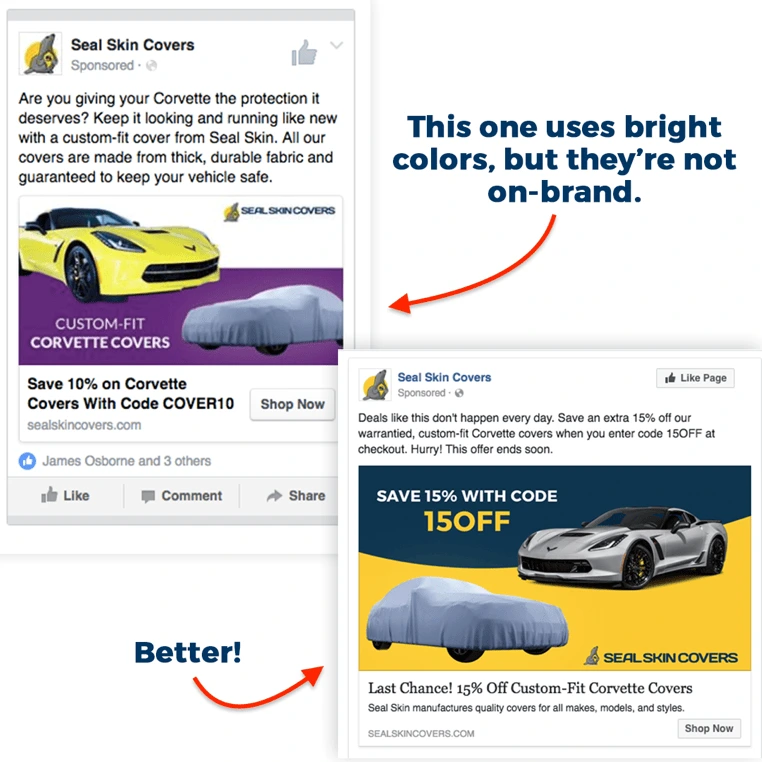
2. Use targeting filters and “Lookalike audiences” to find new fans
While remarketing campaigns are like shooting a fish in a barrel, finding new consumers who will have a genuine interest in your brand is a far more challenging task. Luckily, Facebook has a variety of unique targeting features that can help you refine your audience. Consider the demographics, behaviors and interests of your ideal customer and use that information to narrow your selection. For example, if you own a bridal shop and want to increase your wedding dress sales, you could target people who recently became engaged.
Facebook also has a unique feature called Lookalike audiences. With this tool, you can import a list of existing customers, and the platform’s algorithm will automatically identify new consumers who are likely to have an interest in your products or services. This can be an incredibly valuable tool for new brands looking to grow their fan base.
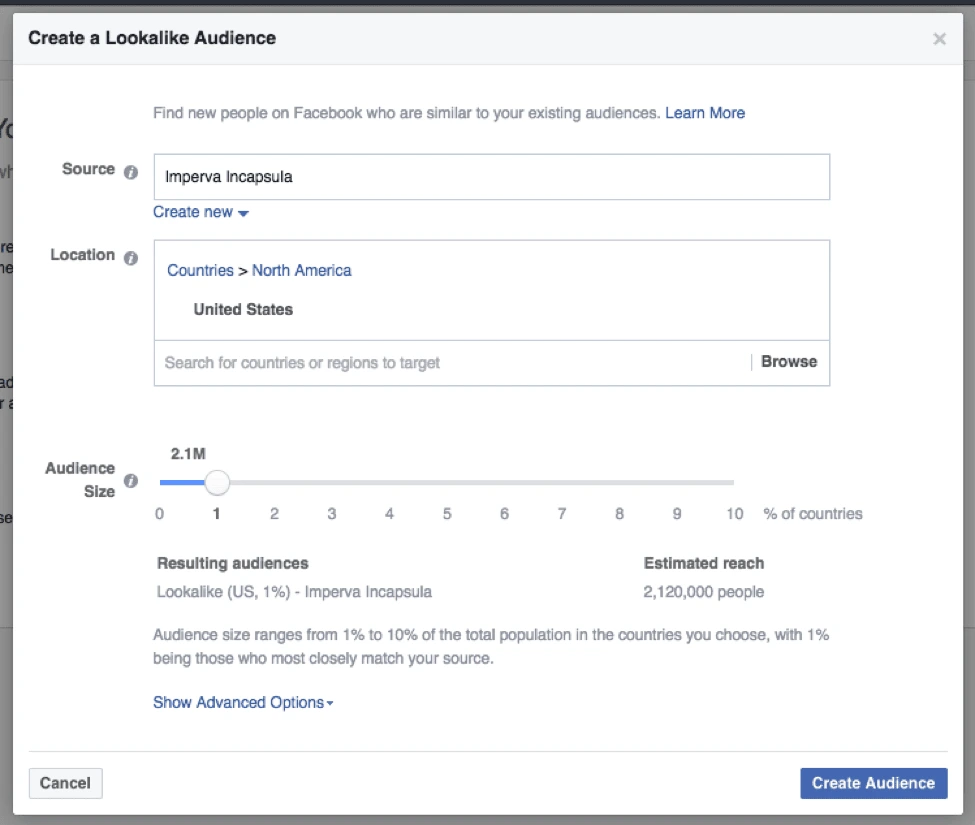
3. Establish a brand voice—and stick with it
To build strong brand affinity on Facebook, use ad copy that aligns with your unique brand voice. For example, if you own a mortgage firm and your brand voice is authoritative and professorial, then you don’t want to run ads that are filled with over-the-top puns and jokes. It’s also important to be consistent with your terminology. If your e-commerce company refers to buy-one-get-one-free sales as “BOGO,” this should be a consistent term in all your ads. If you have more than one person writing copy for your Facebook ads, create a style guide with tips and rules to follow.
When crafting your brand-consistent copy, be sure to write in a way that appeals to your target audience. Alongside the ad’s image or video, copy and headlines are important deciding factors in whether the consumer clicks your ad.
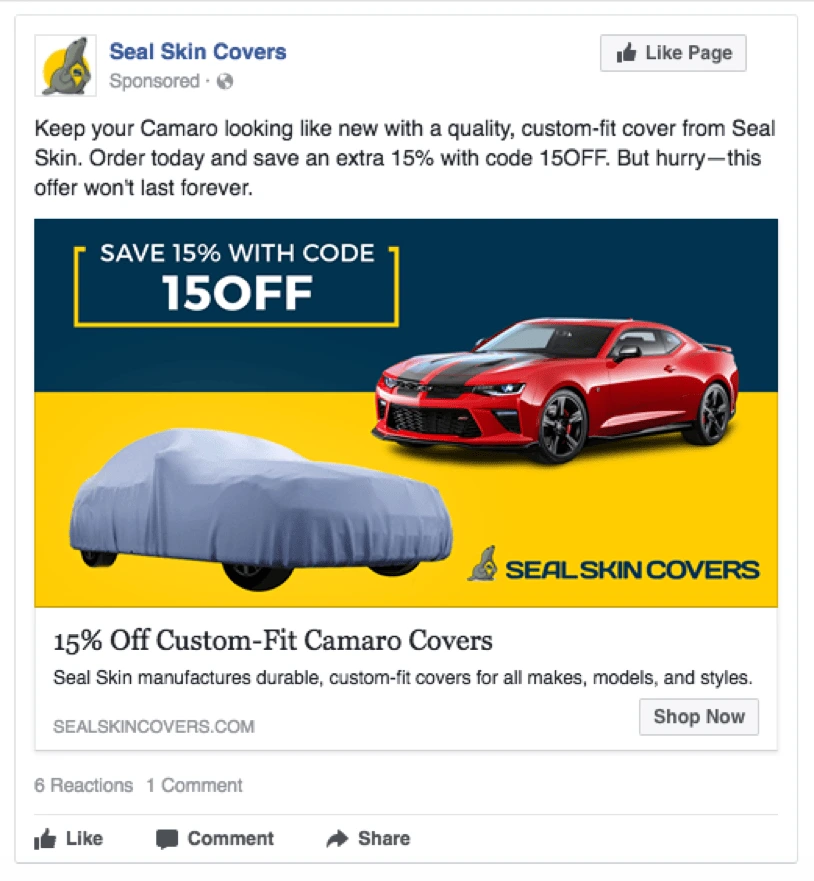
4. Advertise free content, too
Instead of focusing exclusively on advertisements that sell your products and services, promote free content that will spark an interest in your brand and help consumers see you as an industry authority. This is particularly wise when you’re marketing to new leads who’ve never heard of your company before. You want to offer some informative content that will warm up your leads—such as a free guide, video, blog post or infographic. Once the consumer has clicked through to your site, you can move them further down your marketing funnel by entering them into retargeting ads for other content offers or products.
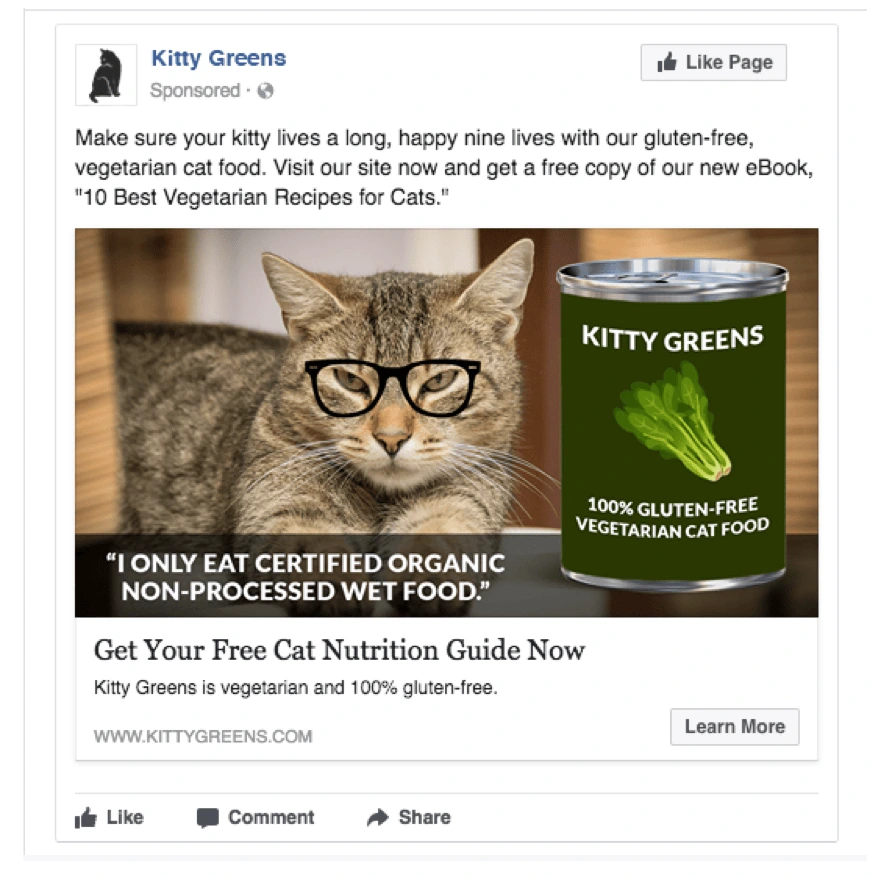
Ready to make a social splash? Create an updated Facebook cover.
Many marketers want to step into millennials’ shoes, find out their preferences & dislikes, and speak to them in the best way possible. Despite being skeptical of advertising, millennials are fiercely loyal to brands, which gives you a unique opportunity to reach them. Content marketing, one of the newer tools in a brand’s arsenal, is leading the way.
Related: 5 myths that devalue your content marketing strategy
The connection between content and brand loyalty was established by MBC Research. The results of its study revealed that 62% of millennials feel that content drives their loyalty to a brand.
Millennials are among the biggest consumers of content online. Take Nielsen’s Q1 2016 Total Audience Report which shows that, in the U.S., content consumption by millennials can shoot up to 18 hours per day. Yet, that doesn’t make it any easier for marketers who want to target this demographic that can be split into as many as six distinct types.
So, how do you encourage this demographic to engage with your brand? Here are 5 top content tactics to help you get started.
1. Rev up the nostalgia
Nostalgia works wonders for the millennial generation, as we’ve seen in the case of Pokémon Go and its phenomenal success. Another example: Disney resonates intimately with millennials because it runs high on emotion. They feel connected with the brand because it was a crucial part of their years spent growing up. It was nostalgia, too, that generated 14 million views for Netflix’s reboot of the 90s sitcom Full House.
You can infuse nostalgia to amplify your own content by:
- Using your audio & visuals to tell a story that establishes a strong connection to common memories.
- Creating interactive content that brings back fond feelings of the past. Remember all those quizzes on Buzzfeed?
- Use retro charm to deliver a message in the latest content formats.
2. Forget text, embrace multimedia
A study from August 2016 shows that the leading social media platforms for millennials were Facebook, Instagram and YouTube. All three of these thrive on images, videos and multimedia content. Yet another survey showed that millennials communicate better via GIFs, emoji & stickers than via text. [![]() ]
]
Brands like Starbucks and Nike are forerunners in creating multimedia content that engages millennials. They use trending formats like Instagram Stories to build brand affinity using micro-content that disappears after 24 hours.
3. Personalize, personalize, personalize
Personalization works for everyone, and millennials are no different. Start with curating your content.
“Personalized and timely content recommendations are one of the most powerful ways to make your leads stay longer on your website and recall your brand at crucial times. Bloggers and large content publishers vouch by predictive recommendations for awareness, reach and engagement (as opposed to ads).”
Jeff Bullas
Personalization requires in-depth research and careful coordination between content creators, technical marketers, automation specialists, customer service and more. While personalization is subjective, the core of your brand messaging and values should remain uniform across the board. A project collaboration tool like Workzone or Trello can keep everyone on the same page. If team-oriented tasks are disorganized, personalization can quickly turn into a mess.
4. Let influencers do the talking
According to Nielsen’s Millennials on Millennials report, this group is distracted. They’ll easily find ways to avoid advertising when given the chance. In fact, they’re more likely to depend on word-of-mouth and social media. Enter influencers.
Social media influencers can help you spread the word about your brand. This tactic can give you an edge over traditional advertising, because millennials trust influencers more than they trust ads. Also, influencers can come up with interesting content that you might not have thought of—as demonstrated by the Clorox brand Brita. Teaming NBA superstar Steph Curry with King Bach, a social media influencer, Brita generated an ad for YouTube that earned 2 million views and led to a 2,000% mobile search lift.
5. Encourage user-generated content
In contrast to baby boomers, millennials are more likely to trust user-generated content. Be it a status update, review or blog post, they take everything into consideration to form an opinion. For example, if someone’s considering a particular shade of lipstick, they’ll likely look at swatches and reviews posted by their peers and other users, rather than trusting the experts.
One way to generate user content is experimenting with branded hashtags. From KFC’s #NationalFriedChickenDay to Oreo’s #OreoHorrorStories, good hashtags can work wonders for brand awareness. It might take some innovation, but finding a winner is well worth your time.
Key takeaway
Millennials are going to remain a favorite demographic of marketers for the near future. Keep up on the latest tools, techniques and channels emerging on the market, and use them to propel your content and brand engagement.
Learn how Lucidpress can streamline your brand’s content marketing and keep your whole team on the same page.
Engaging followers on social media to boost your brand’s popularity is a fine art. Undoubtedly, your audience is spending a sizable chunk of their time on social, but there are way too many things competing for their attention there.
Related: 10 best social media campaigns you haven’t tried yet
If you don’t want to simply get scrolled past in the news feed, you need a better social media strategy. And to build one, you need to experiment with different techniques. Today, we’re going to take notes from the pros. Here are 5 social media hacks to get the right people to notice your brand, engage with your content, and share your posts.
1. Starbucks—Involve your audience in your campaign
A picture is worth a thousand words, right? Well, what if you could share your product’s best pictures on Instagram… by getting your followers to do it for you? That’s exactly what Starbucks has done with a host of seasonal hashtags.
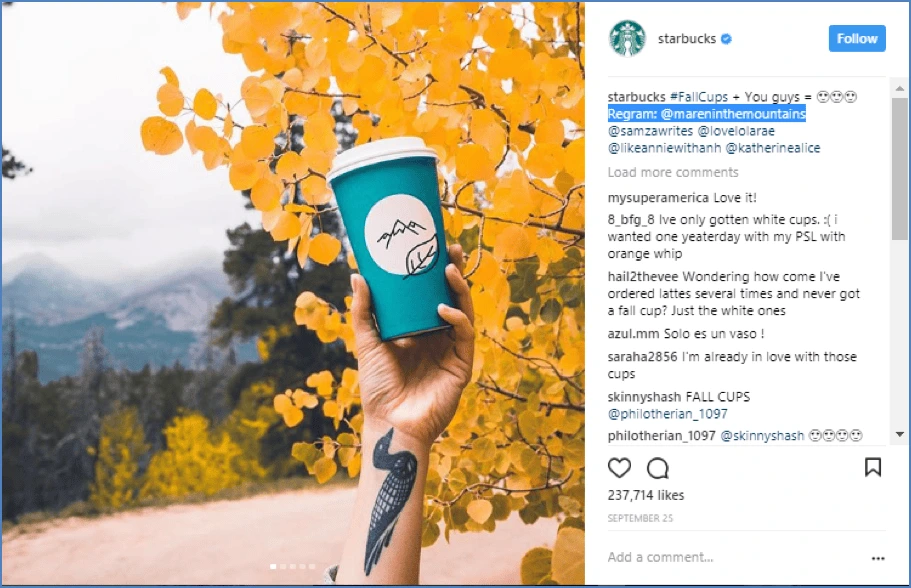
Source: Instagram
Starbucks constantly encourages followers to share their photos and, over time, has built a very active community of coffee lovers. They post their photos, and Starbucks shares the ones they like best.
As a result, the photo-taker gets attention and accolades, reinforcing the positive affinity they have for the brand. And Starbucks gets to spread beautiful pictures of their product that drive more engagement with their content.
You too can explore this option, starting by building a small community of users who love your product. Invite them to share pictures of themselves using your product, and watch how a win-win game can score points both for you and for your audience.
2. Just Eat—Hashtag your giveaways
Giving away freebies isn’t exactly a groundbreaker in business strategy, but there’s a better way to gain maximum impact. The food delivery app Just Eat nails this practice. It’s constantly running themed contests and food giveaways that ask users to tag their friends, send in entries, and generally join in the fun. As a result, for every item given away, Just Eat earns a great deal of traction and puts people in just the right mood for ordering food. #FindYourFlavor, #JustEatUK and #StrangerThings2 are just a few examples.
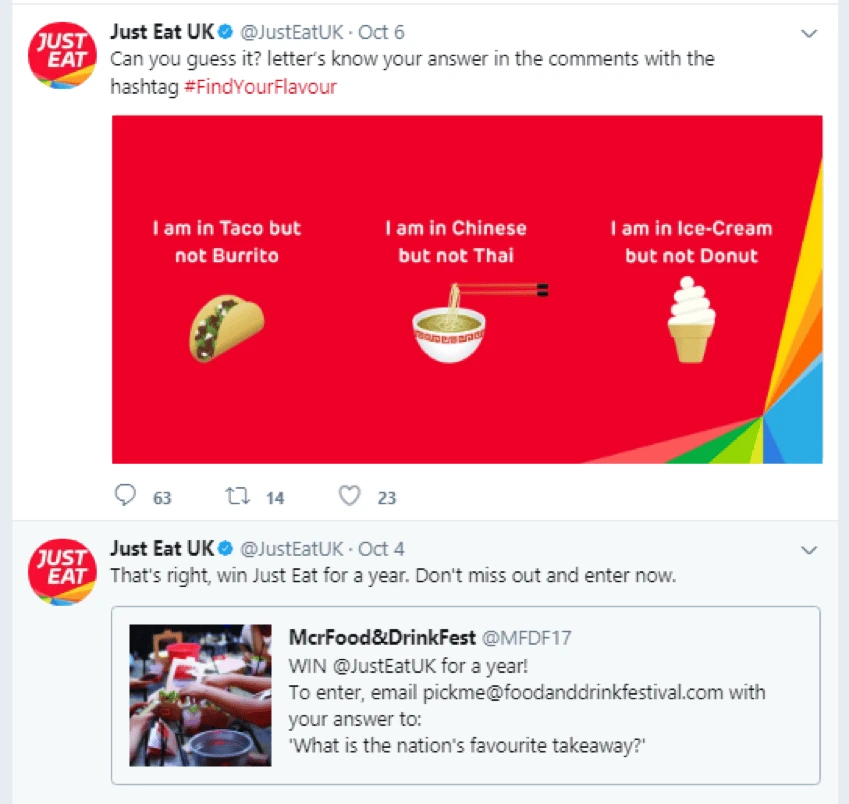
Source: Twitter
3. Lyft—Start a conversation
“While rival Uber is an efficient delivery service, Lyft is seeking to differentiate itself by offering a combination of ‘humanity and technology.”
Kira Wampler, Lyft CMO
Lyft crafts its social media strategy in that same vein by posting customer reviews, messages and conversations on their Twitter page. It aims to establish an identity as a warm, friendly taxi experience that nurtures relationships and cares about every single passenger. In fact, fantastic customer service has been Lyft’s calling card from the start, so playing it up on social media is a smart, brand-consistent move.
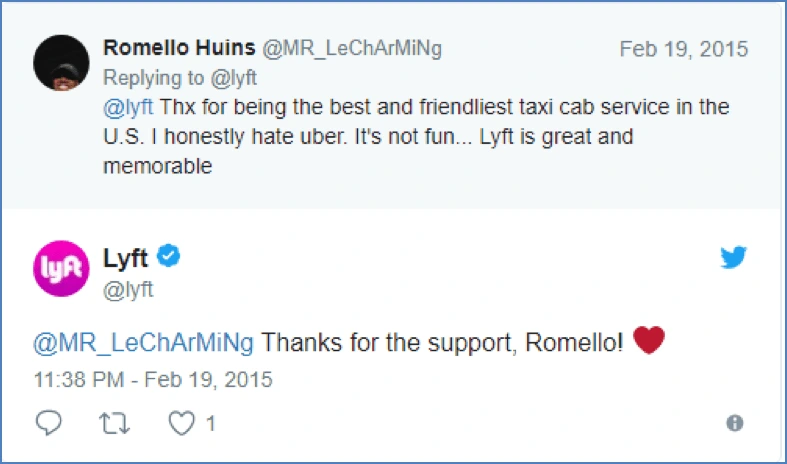
Source: Twitter
We all want to do business with brands that make us feel special. [![]() ] Forming personal relationships through conversation is basic human nature. You too can try exhibiting your warm, personal side by sharing users’ comments and conversations on your profile.
] Forming personal relationships through conversation is basic human nature. You too can try exhibiting your warm, personal side by sharing users’ comments and conversations on your profile.
4. Pokémon Go—Roll out teasers before major updates
Pokémon Go brought augmented reality gaming to the masses and attracted a huge fanbase in very little time. However, with shrinking attention spans, the initial excitement could’ve fizzled out quickly if they didn’t find ways to keep the buzz going.
Fans of Pokémon Go are treated to small doses of upcoming excitement through a regular cadence of trailers and teasers. The anticipation for new levels, more items, and higher scores is enough to make fans look forward to playing every update, making it one of the highest grossing games ever.
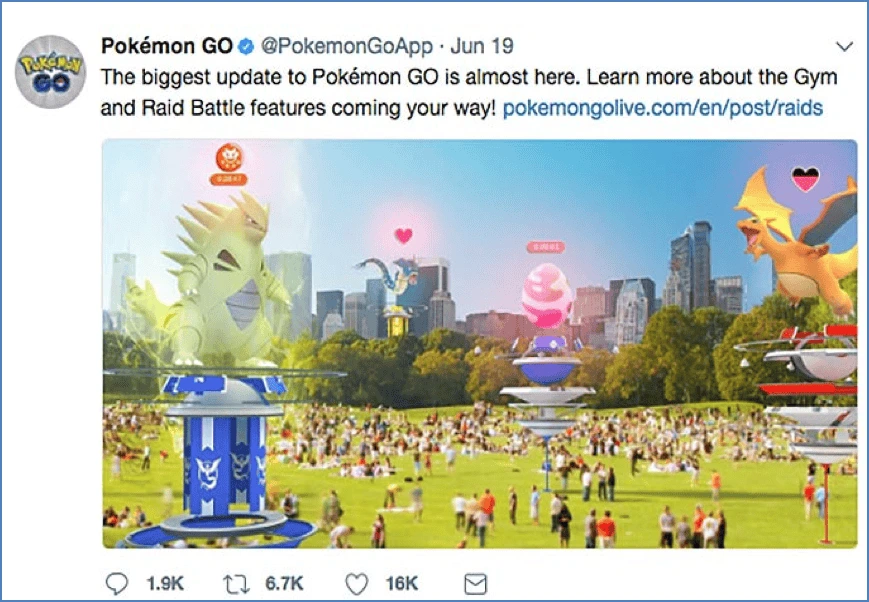
Source: Facebook
If you have a major update coming out, tease your followers with alluring clues, images and videos. This will keep the excitement alive until the update is finally out.
5. Angry Birds—Have a little fun with games
Angry Birds has been on social media since 2009, and from the start, their team has infused their brand’s personality with the fun of gaming. They are constantly running fun contests, posting fan artwork, giving away extra lives, and adding a light touch of humor to everything they post.
Plus, it’s not just your typical “share to win” giveaways. Contests come with clues and incentives to lure people into downloading the app. Riddles, puzzles, cryptic images and poems, it’s all there to keep users tuned in. Sometimes all it takes is a little fun and games to keep your audience engaged.
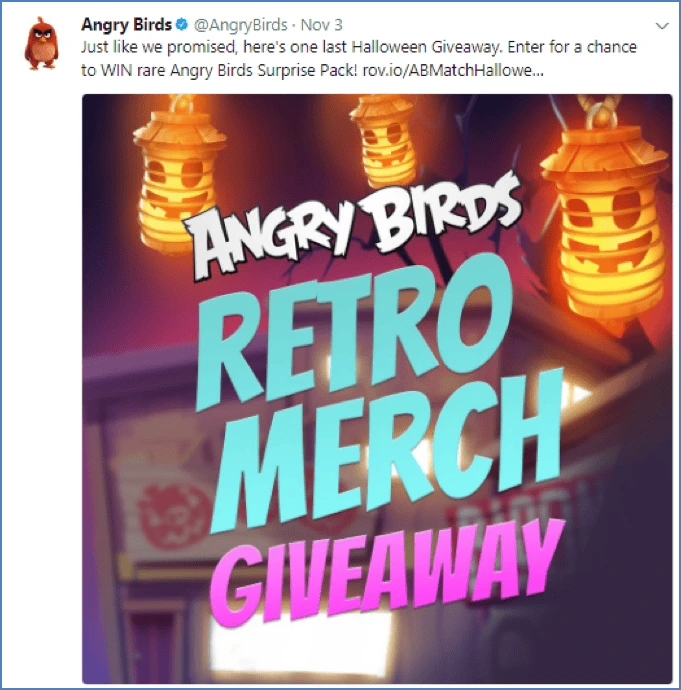
Source: Twitter
Wrapping up
Now you have 5 tried-and-tested strategies straight from the pros. These techniques can be adjusted and applied to nearly any brand willing to experiment with creative flair. The idea is to build connections and foster relationships with your users so you become part of their social lives. Try one (or more!) of the above tips and see how your audience responds—you might be surprised at your success.
Ready to drive more engagement and leads with social media? Grab a copy of our free eBook: How to adapt your brand to social media
Brand management is one of the most important parts of marketing. It can take a long time and a lot of work to create a brand image that people like and trust, but in an instant, all that work can be completely undone. There are certain situations businesses have to deal with that, if not handled properly, can severely damage the brand’s image. Here are a few common situations and how you should respond.
Related: Why brand equity is important & how to measure it
Problem #1: Having poor customer support
If you look up any public polls or surveys that list companies with the worst ratings, one of the biggest reasons is due to poor customer support. If someone calls you with a problem they’re having with your brand’s products or service, you will make a bad situation worse by making it difficult for them to get help from you. [![]() ]
]
Bad support is a good way of burning a bridge not just with that customer, but with their friends and family, too. After that, there’s more damage to worry about if they vocalize their discontent on social media.
To respond to this situation, you need to overhaul and clean up every line of communication between you and your customers:
- Make it easy for your customers to find your phone numbers and/or email addresses for support.
- Create a functional process flow to handle customers through your support channels.
- Make sure your customer support team adheres to that process.
The longer customers wait to get the help they want, the more annoyed they’ll be. They should be able to contact you quickly and easily. Most importantly, they should receive a useful response that resolves their problem. Auto-response emails and phone messages are simply not good enough in situations where your real customers are involved.
Problem #2: Failing to live up to your brand image
If you build your brand image around certain promises or guarantees for your customers, you had darn well better deliver on those promises and guarantees every single time. If you say you have the cheapest products, you’d better have the cheapest products. If you offer the quickest service, your service had better be very quick. If you have a satisfaction, money-back guarantee, then you need to take your customers’ dissatisfaction seriously and mitigate their concerns or issue a refund. Nothing can ruin a brand’s image like being inconsistent in living up to its own standards and promises.
If your company’s brand is starting to take a hit due to this, you need to take immediate steps. Get all hands on deck and start generating as much positive brand awareness as you can. The best way to do this is by delivering on the promises you make.
In the short term, that means doing what you can to raise your brand’s reputation, and in the long term, it might be shifting your brand’s image to something more realistic. For instance, if your business is not able to offer the cheapest products, change your marketing to start offering the friendliest service instead.
Problem #3: Getting negative attention from an employee
It is an unfortunate reality that how your employees behave, even when they’re off the clock, can reflect back on your brand. If they’re caught on the news, in a newspaper, or online behaving in an unethical manner—or even just in poor taste—your brand can get negative publicity from it. That’s why so many businesses include clauses in the employment contract regarding “off-duty conduct.”
From a brand image perspective, what should you do in this situation? First, be open and transparent to the public so they don’t think you’re covering anything up. Apologize to anyone affected by your employee’s actions, both publicly and in private. Second, look into how you are legally allowed to handle the employee based on that specific situation.
Finally, you need to be seen responding against the negative behavior in question. For example, if the employee went on a racist rant online, you can donate or form a partnership with an anti-racism organization and/or hold special seminars and training to improve tolerance in your company.
Problem #4: Offering a poor website experience
In today’s world, you cannot afford to have a bad website. The design can’t look old and dated; the navigation can’t be poorly structured so customers can’t find what they’re looking for; and the functionality can’t be compromised so they’re unable to perform important actions, such as completing a lead form on your site, completing an online purchase, or simply entering the buying cycle.
Even if your business is running smoothly otherwise, having a bad website that creates a poor user experience can really hurt your brand’s image. It can set a bad first impression if your users’ first interaction with your business is through a dysfunctional website.
The first thing you need to do is fix your website, of course. Upgrade the design or fix your theme and template, rearrange the navigation (site architecture) so it makes sense for your end-user, and fix any bugs or broken pages so that your visitors don’t get any site errors telling them your website pages cannot be found (404).
The next thing is investing in search engine optimization (SEO), then promoting the heck out of it. Create special promotions for the re-launch, start digital paid ad campaigns intended to drive new traffic to the new website, and retarget traffic from your old site back to the new site so they can see the difference.
Problem #5: Receiving a bad customer review
All of the above situations often lead to a customer leaving a bad review for your business online—on Yelp, Google, TripAdvisor, and other websites where customers review businesses. The worst thing you can do is ignore a bad review.
If reviews pile up and you don’t respond properly, your customers will assume you don’t care about them or their business, causing other people who look up your reviews to form a bad impression of your brand.
Make sure your business has an account on every major review website that your business gets reviewed on, and monitor them regularly.
When you see a bad review, take the information in the review and find out what happened before responding to it. Sometimes, the customer could be lying or omitting the truth, and you can point that out to tell your side of the story. Other times, your business legitimately failed the customer, but you can respond in a way that offers an apology and makes the situation right for them.
Want to know more about how to build your brand? Download our free ebook on how to build a brand in 2020.
Higher ed is getting social. With such a large audience, from students, prospective students and faculty to alumni and sports fans, the potential for social media in higher education is huge.
Benefits of social media in higher education
Student recruitment
It’s a well-known fact that younger generations use their phones more than older ones. This is where they conduct research on products, services and organizations. Universities can (and should) take advantage of this for recruiting. If universities want to attract students, then they need to have an engaging brand presence online.
Related: How to take charge of your university’s branding
Build your brand
Social media can be a powerful tool for building brand awareness. From highlighting new research to showcasing student projects and achievements, higher ed social teams can play a powerful role in attracting potential students, faculty and donors to the university.
Boost student engagement
Engaged students are more likely to stay enrolled and graduate. They are also more likely to become brand advocates encouraging their friends, family and children to participate with your university in the future. Taking a fun or lighthearted approach with content on Instagram or Tik Tok will resonate with students in a way that official announcements won’t.
Higher ed social media strategies
Establish your brand
Whether your higher ed team has been using social media for a while or is completely new to it, you should make sure that your brand is well-represented on your social media accounts. You never want potential students to come across your profile and wonder if it’s the university’s actual account. It should be obvious. Some things that will help establish your brand on social media are:
- Username/handle: Keep usernames the same across all platforms. This way, students can easily find you on Twitter, Facebook, Instagram and any other platforms you’re on. If you’re concerned about being able to register the same username across all platforms (and don’t want your handle to end up like @Lucid_press0018), here’s a tip. You can create accounts on new social media platforms, even if you don’t want to use them yet. Later on, if you find that your audience is using that platform, you’ll already have the username.
- Images: Just as usernames should be the same across platforms, your profile pictures should be easily identifiable. Along with your profile picture, using similar colors (such as school colors) in your images will further affirm your identity. A tip regarding the images you post: choose one or two photo filters that fit your brand, then only use those filters on any images you post. This creates a uniform look for your content that will be recognizable to your audience.
A great example for establishing your brand on social media is Coca-Cola. All of the Coke accounts feel familiar. Each picture uses a similar filter that’s cohesive with their branding, and you can see red in all of their images.
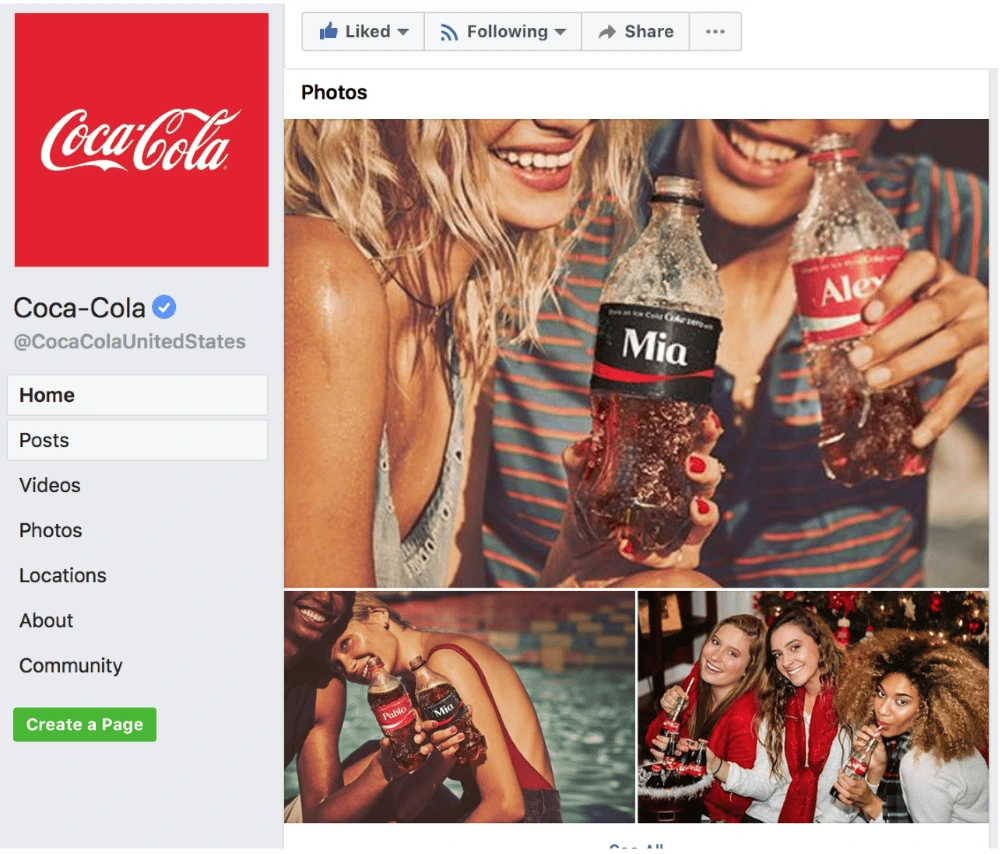
- Bio: Most social media platforms offer a place to include a bio for your university. Don’t waste this space. Bios are an excellent opportunity to show students what’s important to the school. You can even include a link to a page where interested students can learn more about the university (for example, by signing up for a newsletter).

- Tone & voice: Before you start posting, decide what your brand voice will sound like online. Will you be dry and professional? Will you use slang? The same goes for finding the right tone to use in your posts. Will you be happy, neutral, silly, snarky or witty? These decisions will shape your brand as people come to associate that voice with your university.
Speak to your audience
When it comes to social media, go where your audience is. Post content that’s designed for the platform and meaningful to them.
- Use the right networks: Are prospective students using Instagram, Snapchat or Facebook? Find out where your audience is, and start building a presence and community there. Some platforms might seem difficult to use as a university, like Snapchat. This is where you get to be creative and connect with students in innovative ways that no other universities are using.
- Create content specifically for your audience: What do potential students want to know? Share successes your school has experienced, student activities on campus, tips for prepping for college, what to bring to a new dorm room, what research is happening at your university, etc. Find out what your students are curious about, and create content that’ll be interesting and useful to them.
Harvard University’s social media often posts student-related stories that are relatable to other students. By focusing on the students, it shows that they come first at Harvard. Here’s an example of a personal story that was shared on the Harvard Facebook page:
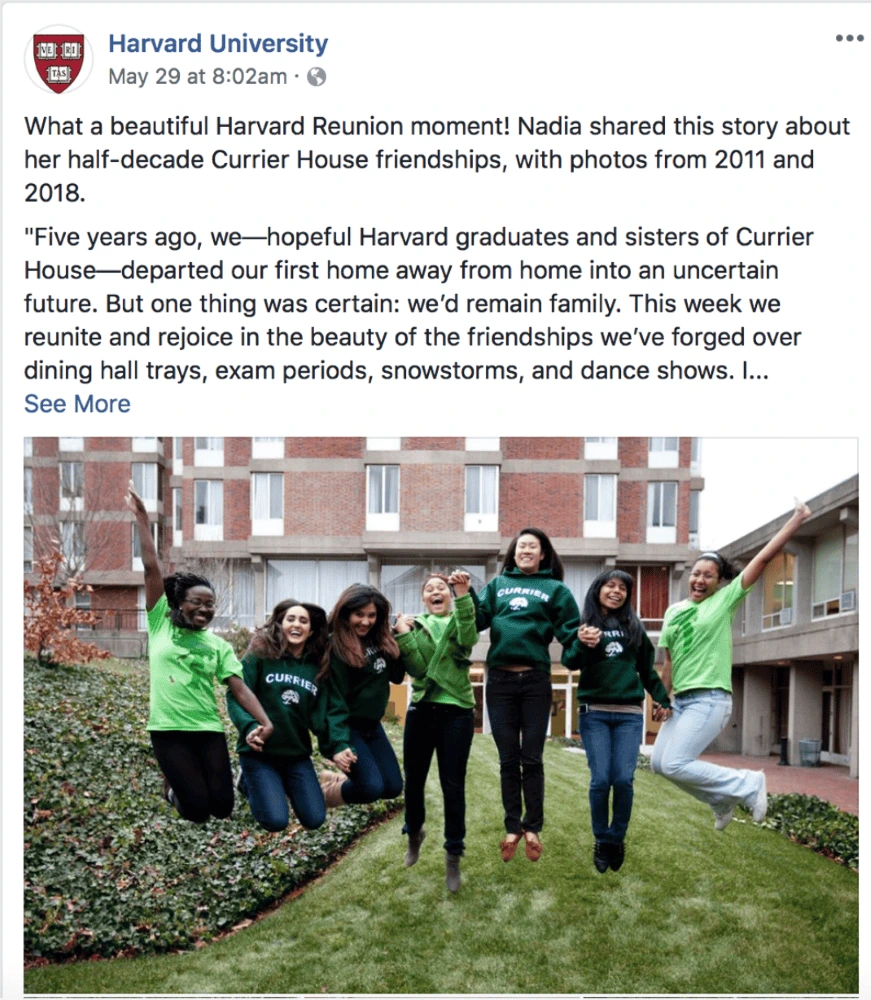
Key takeaways
Social media is no longer a “nice touch” for your higher ed marketing plans; it’s essential to establishing your brand online. Build your profiles with consistent usernames and imagery. Create a guide for staff members that includes the colors, photo filters, logos, tone and voice to use in university-branded social media to maintain consistency.
Finally, make sure that you’re on the right platforms, sharing content that’s engaging for your audience. Use the same voice in comments, personal messages and public posts. Be where your future students are, and give them a reason to notice your university.
Memes are one of the most popular forms of expression online, and for good reason. First of all, they go hand-in-hand with just about any social media platform, which helps them spread like wildfire. Second, people have fairly short attention spans online, so the concise nature of memes makes them a perfect medium for quick consumption.
Related: How to create social media posts that get noticed
Memes are like an inside joke everyone wants to be in on. They’re a fun way to reflect on current events, clichés and trends. Memes are popular among brands because they engage audiences and drive traffic. If you’re thinking about using memes in your social media marketing, this guide will help you get up to speed.
What’s a meme?
The term itself was coined several decades ago by the evolutionary biologist Richard Dawkins. In his book The Selfish Gene, it refers to the way an idea spreads from person to person within a culture. Like genes, they replicate and change as they spread. Some of his examples include catchphrases, melodies, fashion, and even the technology of building arches.
Today, we understand the concept a little differently, thanks to the internet. Memes are still representations of ideas, and they still spread from person to person, but they involve an element of human creativity.
Simply put, a typical meme is an image or photograph accompanied by a caption that’s funny, ironic or entertaining. Although memes have many different permutations, effective memes are instantly recognizable.
Early internet memes
Before the days of social media, memes were shared via email, blogs and forums. One of the first memes was the Dancing baby, which was so popular in the 90s, it made a cameo on the TV show Ally McBeal. Another popular early meme was the Hampster dance, a webpage born as the result of a competition between two sisters to generate the most web traffic.
Memes can grow and evolve, and they don’t necessarily have a short shelf life. For instance, the LOLcats meme is still around—ancient by internet standards. Rickrolling was huge a decade ago and has mostly been put to bed, but Westworld’s creators recently decided to post a video containing spoilers for its next season… which turned out to be fake. Another enduring meme is a video clip from the movie Downfall, which chronicles Hitler’s last days and has inspired numerous parodies—usually by pairing the serious scene with a frivolous topic.
Other types of memes
- Rage comics. These memes use a library of pre-made cartoon faces (or “rage faces”) to express a particular emotion. Usually, they humorize a relatable experience. Because they use facial expressions, they’re easy to identify and understand. Examples include the Trollface, Like a Boss, Cereal Guy, and Forever Alone Guy.

The iconic Tootsie Pop ad reimagined as a rage comic
- Image macros. Probably the most recognizable type of meme, these are images that feature a witty caption or catchphrase. Thanks to meme generator sites like I Can Has Cheezburger, most of these memes use a bold, white Impact font with a black border (like the header image of this post).
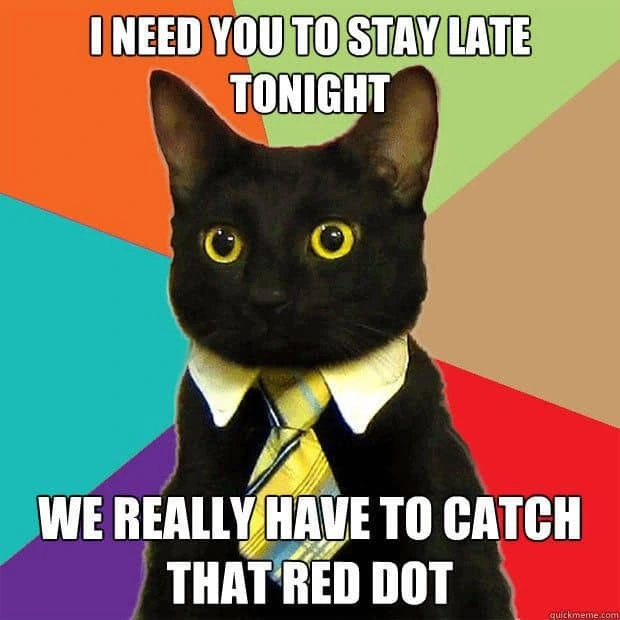
The internet is powered by humorous pictures of cats.
- Trending memes. This type of meme bursts onto the scene, feels ubiquitous for a few weeks or months, then disappears and nobody ever mentions it again. They’re often tied to current events, news, popular culture and trends.
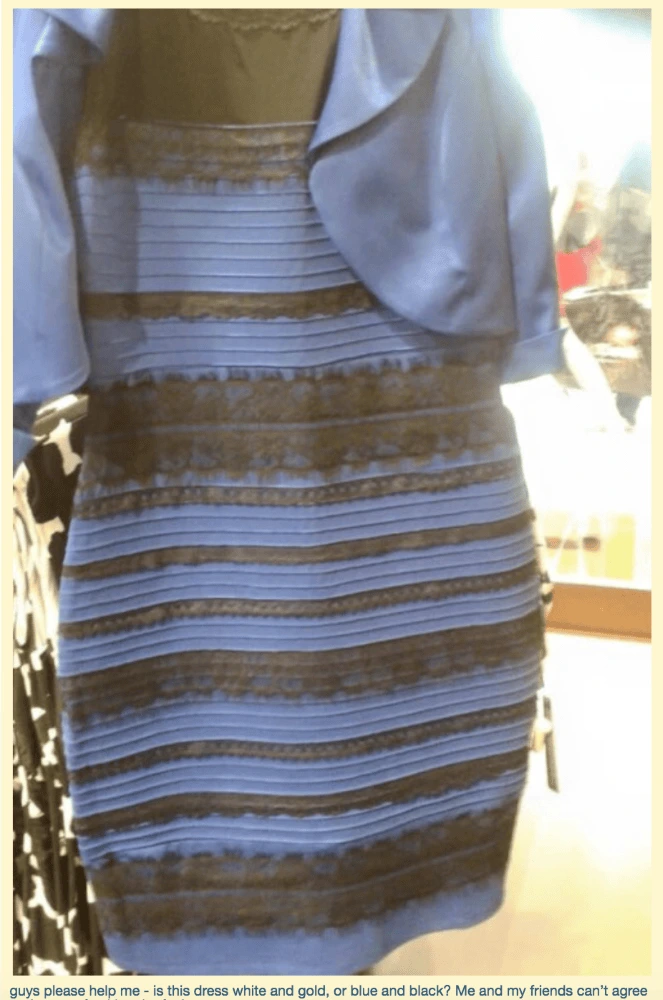
Ahh, yes, the “Yanny vs. Laurel” of its generation. (2015, that is.)
- Exploitables. Exploitables come in various forms, including single-pane or multi-pane comics, but the central idea remains the same: a template that’s easy to modify into new permutations of a joke. Four-pane comics are an especially popular exploitable format.

About 802 now, if you’re still counting.
- Copypasta. Unlike many memes, copypasta isn’t visual. Rather, it’s usually a section of text that gets copied and shared over and over. It’s most commonly used as a response in forum discussions and social media comment threads.

Since most recent examples are wildly inappropriate for this blog,here’s an oldie but a goodie.
The rules of using memes as a marketer
Like any type of humor, using memes as a brand poses a certain amount of risk. You don’t want a poorly constructed or offensive joke to confuse or drive away your audience. So, before you start spamming your social media feeds, review these simple guidelines.
- Decide whether memes are appropriate for your brand. Memes are predominantly created and shared by younger audiences. To get the joke, you have be clued into the broader online discussion. If your marketing campaign is aimed at an older audience, they might not follow memes or get the reference. Thus, your attempts at humor could fall flat.
Also, consider brand voice. If your brand uses a serious tone, memes probably won’t help you establish credibility or authority. Research your audience and review your brand guidelines before introducing memes into your strategy. - Don’t overdo it. In a way, memes function like a good jump scare in a horror movie. They can be incredibly effective 1) when used sparingly and 2) when the timing is right. Using them all the time will diminish their impact and bore your audience.
- Memes can’t replace original content. Memes can be a great addition to your content, but you can’t rely on them all the time. They’re there to amplify your message to a broader audience. All memes and no content is like eating dessert but never actually having lunch—fun at first, but eventually, you’ll want something more substantial to chew on.
- Be thoughtful. Memes can easily backfire if you’re not careful about the tone you use to get your point across. Sarcasm and irony don’t always translate well via text, which can cause confusion or backlash among your audience, despite having the best intentions.
Additionally, make sure you research and understand the origins of a meme before you use it. It might have problematic connotations (like racism, sexism or ableism) that you don’t want associated with your brand. Know Your Meme (potentially NSFW) is a great resource if you want to learn more about a particular meme.
3 examples of brands using memes on social media
There’s a veritable boatload of brands using memes effectively out there, but here are a few of our favorites.
- Seamless. A few years ago, food delivery service Seamless introduced a meme to join the buzz surrounding the Oscars. This one took the form of a hashtag; you can still find them by searching #OscarNomNoms. The idea was to use puns and wordplay to parody popular movie titles. We especially loved made-up titles like “Gravitea,” “American Mussels” and “The Wolf of Waffle Street.”
* Nickelodeon. Nickelodeon uses clips from its own cartoons to create memes, then posts them to Twitter and Instagram. Usually, they focus on issues younger viewers can relate to—such as going to school, having an annoying sibling, or enjoying time alone when parents aren’t around.
* Hipchat. In a move that seems like it never should have worked, Hipchat brought an existing meme into the real world by putting it up on billboards. Even though it’s a clear example of offline marketing, the digital search for HipChat rose 300%! In this case, being bold definitely paid off.
Key takeaway
Although individual ones come and go, memes are here to stay. They’re easy to create and even easier to share. From a marketer’s point of view, they’re inexpensive and have the potential to go viral. Still, they require you to research their content, your audience, and your brand. When all these elements align, memes can spread your brand message to a broader audience than ever before. To the moon! ???
Before the rise of social media platforms, marketers relied on evergreen content. Evergreen content is content that’s always interesting, valuable or relevant to readers.
In contrast, ephemeral content is content that’s designed to last for only 24 hours. Snapchat, Instagram Stories and Facebook Live are all examples of places to post ephemeral content.
Related: How to use memes for social media marketing
The psychological concept of FOMO (the fear of missing out) makes ephemeral content great at increasing customer engagement.
Here, we’ll discuss how you can take advantage of FOMO to build your brand with ephemeral content.
Why should brands create ephemeral content?
When Snapchat came to smartphones, many people didn’t get it. What was the point in making a video or a photo that would disappear?
At that time, content creators focused on creating evergreen content to capture the interest of readers and stand the test of time.
Although evergreen content lasts, ephemeral content offers a sense of exclusivity. If you miss it, you miss it for good.
By making content ephemeral, you can keep your audience on its toes. They don’t want to miss out, so they pay attention. And on the internet, attention is king.
Large brands are already taking advantage of FOMO with their content. In 2016, an estimated 21% of BuzzFeed’s total traffic came from Snapchat views. As of 2018, Instagram Stories has an estimated 400 million users.
If you don’t get in on this trend soon, you’ll be the one who ends up with a bad case of FOMO.
How to use ephemeral content effectively
Ephemeral content offers unique ways to engage an audience. There are several different strategies you can use, depending on your preferred platform. Here are a few of them.
Reach out to your users and make them feel special
First, you have to reach out to your users. There are two good ways to do this: remarketing and influencer marketing.
If you’ve already established contact with your users, you can try remarketing. Use remarketing to announce new products, sales or discounts on products or services they’ve bought before to keep your audience engaged.
If you haven’t reached your audience yet, you can tap influencers to attend expos or invite-only events. Provide opportunities for them to take great pictures and try out your product. These influencers can then share their experiences with your brand via their social media accounts.
Keep in mind that not all fans have the clout or money to go to these events. Instead, you can give your regular users a “sneak peek” that not only makes them feel special, but also makes your brand feel real and authentic.
Be authentic and humanize your brand
Speaking of authenticity, one of the things that makes ephemeral content attractive is that it feels more real. However, to do this, you first have to know who you are and what you want to do as a brand.
According to Shopify, putting to paper the intangible facets of your brand (e.g. principles, philosophies, etc.) “should provide an ample introduction of why you’re in business, why you’re different, what you have going for you, and why you’re a good bet if you’re asking for an investment.” These will give you a guide for how to appear more authentic in your social media posts.
But, it’s not enough to know who you are and why. You also have to run your brand in line with your identity. When you have an identity and stick to it, it’s reflected in your content. Users like seeing employees at work behind the scenes—or real people using products in their own way. Take advantage of this and show users the unpolished side of your brand.
Keep your audience on its toes with live video
Live video is one way to show your audience that you’re authentic. But aside from that, it hooks them immediately.
When you use live video, your users are the seeing it at the same time as everyone else. According to Facebook, users spend up to three times more of their time watching live videos than non-live videos.
Here are a few ways to use live video:
- Show what goes on behind-the-scenes. You can show snippets of processes in your business, or company culture by showing staff in their element.
- Training videos. These videos are great for technical or creative brands. You don’t have to do full training sessions. Instead, you can treat users to related tips & tricks, Q&As or how-to guides.
- Contests or giveaways. These would not only reward loyal customers, but they can bring in new customers, too.
- Share live events. Not everyone has the chance to attend exclusive events. Live video lets you share memorable event moments with all your users.
Facebook Live is a popular platform for live video streaming. If you plan on using Facebook for your live videos, make sure you know when the best times are to go live so you can get the most engagement.
Get your users involved with a call-to-action
In the end, you want your users to do something. That’s why you include a call-to-action.
With ephemeral content, the call-to-action is usually a link to a landing page. Because ephemeral content doesn’t last forever, you need to make your CTA clear and concise.
Make sure you tell your audience exactly what you want them to do. “Click this link!” and “Swipe up!” are good examples of clear calls-to-action.
Best platforms for ephemeral content
Now that you have an idea of how to maximize ephemeral content, it’s time to decide which platform to use. Each platform has its own features and user base. Here’s a short breakdown of three popular platforms.
Snapchat
Snapchat is popular with younger users, so you should consider Snapchat if they’re your target market. Snapchat uses Snapcodes, which are QR codes users can scan to follow brand profiles. Snapchat also has geo-filters, which can be used for time- and location-sensitive events or promotions.
Facebook has a huge user base that’s varied in demographics. If you plan on integrating ephemeral content with a brand page, Facebook is the way to go. Facebook Stories gives users a way to enjoy ephemeral content without clogging up their newsfeed. It also allows you to supplement your ephemeral content with posts on your main page.
Instagram has a huge user base. In 2017, Instagram Stories had more than 200 million daily active users, a number that’s doubled since then. If your brand is visual in its marketing style, Instagram is worth a look. You’ll be able to supplement your photo feed with Stories. Instagram also allows in-story links, making calls-to-action easier for users to follow.
Key takeaway
Ephemeral content is a trend that isn’t going away soon, even though these posts only last for 24 hours.
If you’re looking for a new way to engage your users and keep them interested, ephemeral content is something you should think about. Are you already using ephemeral content? How is it working for your brand? Show us your favorite examples on Twitter by mentioning @lucidpress.
Today, over half of the world (4.89 billion people) use social media. A pretty staggering number, right? What’s more, a typical social media user spends an average of 151 minutes per day scrolling through their feeds. Given all of this, it’s easy to understand why most brands are active on social media today. There’s a huge opportunity to grow your brand awareness here, especially if you follow the right strategy.
So how can you cut through the noise and make sure your brand stands out to the right audience? Let’s go over a few tips that will help you get the most brand awareness out of our social media efforts.
Choosing the right platforms
Right now, there are over 120 social media platforms out there. Thankfully, your brand doesn’t need to be on all of them to have an impact. Remember the phrase, “more isn’t always better”? That’s a good mantra to keep in mind when you’re choosing the platforms you want to be active on.
With so many options, it’s okay to be picky here. To help you get started, consider the strengths and weaknesses of each platform, along with the demographics of its user base and how easy (or difficult) it will be to get your content in their feeds.
Of course, just because one platform is popular doesn’t mean it will necessarily be a good fit for your brand. For instance, if you’re an HR consulting firm targeting c-suite teams, your content might be more suited to LinkedIn than TikTok – despite it being the fastest growing platform out there right now.
One last note here: While we think it’s important to be somewhat picky here, try not to put all of your social media eggs into one basket. As platforms grow and change, they may no longer be suitable for your brand. For example, you don’t have to look very far to see plenty of brands that either paused advertising or left X a.k.a Twitter entirely after controversial changes to the app and its leadership.
Creating a brand persona
Brand recognition = brand awareness. There’s nothing that builds brand recognition faster than a unique, memorable brand persona. Think of this as the voice and POV of your brand. What – or who – does your brand sound like?
Nailing your brand’s personality is one of the most important parts of building a rock solid social media strategy. Knowing your target audience inside and out can help – after all, it’s much easier to develop a brand persona that will resonate if you know the kind of people you’re looking to reach.
But what if you have multiple audiences? No need to fret. You’ll just want to develop a more flexible brand voice that can speak to your different audience segments. For example, you may showcase more of your brand’s fun, humorous side on TikTok, while your LinkedIn presence may be more focused on product updates, internal news, and informative content.
Publishing authentic, consistent content
If you want to thrive in today’s over-saturated market, your brand needs to be consistently producing high-quality, engaging content.
You can start by focusing on topics closely related to your particular niche. For example, if you own a plant shop, you can share information on various plant species, as well as helpful tips and tricks on how to take care of them.
Pre-measured templates are an easy way to start building on-brand content at scale. At Marq, we’ve got a library full of social media templates to get you started.
Lastly, a note on consistency. You can post the most amazing content, but if you’re only posting a few times a year, you’re not going to be able to build the kind of brand awareness that a more active account can. If you’re irregular or inconsistent with your social media branding efforts, your audience might forget about you. (Plus, your absence and lack of posts might even make them think you’ve forgotten about them, too!)
If you can’t post consistently on a regular basis, try using scheduling tools. Schedule your posts at peak times when your followers are most active. This will give your content the best chance to gain visibility and momentum.
Building brand awareness through audience engagement
If you look at successful brands on social media, the vast majority of them interact regularly with their audience. They start conversations, ask questions, and interact with their fans in many of the same ways you might interact with a friend.
Intentionally engaging with your audience can have an incredible impact – not only driving brand awareness but helping people build an emotional connection with your brand.
Here are just a few methods for drumming up engagement on your socials:
- Host giveaways or promotions with branded hashtags
- Sprinkle in user generated content into your social calendar – and encourage your followers to tag you in their own photos for a chance to be featured
- Partner with local or micro-influencers to build a sense of community around your brand
- Respond to audience comments, questions, and concerns to create trust
Key takeaway
It’s not enough to simply have a social media presence anymore. Any brand can publish content, but those that truly go above and beyond have the chance to cultivate a level of brand awareness that rivals the world’s leading companies.
Want to streamline your social media content creation? Check out our template library and start designing on-brand today!
Attracting a steady stream of new customers is one thing, but building customer loyalty is integral to a brand’s long-term success. And it begins with making a good first impression.
Think about it: when looking up a brand online, what do you remember about the ones that stand out? More than likely, it’s their logo or their overall style—like meeting a person wearing a great suit. When you run across that brand again, that image can stick with you—more so if you keep on seeing it in different places. This is a brand’s visual identity, and it’s what you want potential customers to remember.
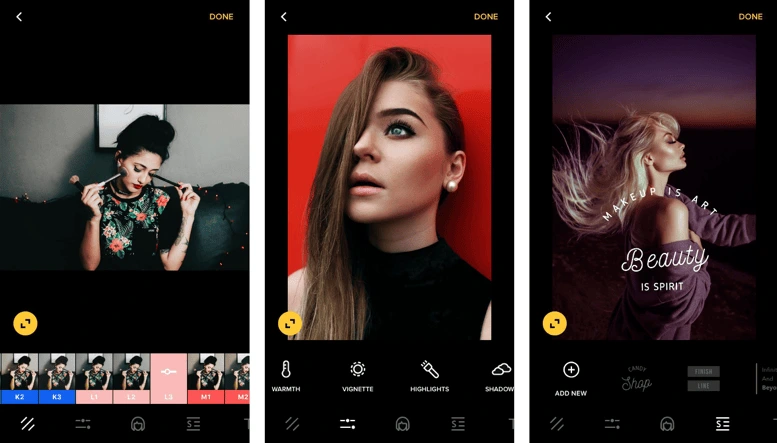
Related: 6 Instagram post ideas to boost sales
Having a memorable visual identity is important for social media, now a standard tool in the digital marketer’s arsenal. Instagram in particular is a powerhouse for using visual content to promote products and services, with Instagram stats showing 71% of U.S. businesses have an Instagram profile (25 million business profiles total). Standing out and earning engagement and followers depends on how well-defined your visual identity is. Here’s how to do it.
1. Know your brand inside and out
Before you create a visual identity, you need an actual identity first. Know the key aspects of your brand you want to communicate to your audience, then translate them into a visual medium. [![]() ]
]
Essentials for this step are copies (in writing!) of your brand’s mission, vision and values. These should be easily accessible on both your official website and any internal marketing documents. When you have them, answer the following questions to figure out what you’ll need to base your visuals on.
- Why was my brand made?
- What does my brand value the most?
- What words would I use to describe my brand?
- What does my brand offer in terms of products, service and experience that others do not?
- What kind of people do I want my customers to be?
Using your answers to the questions above, you can isolate a set of keywords closely associated with your brand.
2. Create a set of branding guidelines for social media
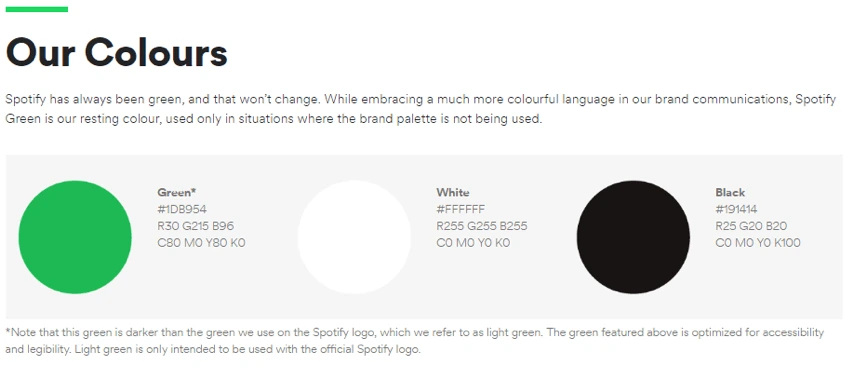
Source: Spotify
Do not underestimate the logistical power of good documentation. Brand guidelines enforce consistency in your branding, graphic design and marketing—keeping everything together so that everyone is on the same page when it comes to how to visually present your brand.
While it does take time and effort to create, having all these details in one place saves more time in the long run. It’s also a mark of professionalism: no having to go back and forth, emailing each other files and instructions every time you design something new.
Looking at some great branding examples, here’s what to include in your brand guidelines:
- The theme of your brand
- The feel and philosophy of your company
- Relevant taglines
- Font styles & typefaces to use
- Acceptable ways to use your brand logo, including its size & placement
- Color palette to use when associating with the brand
- Guidelines on composing imagery
3. Make social media post templates
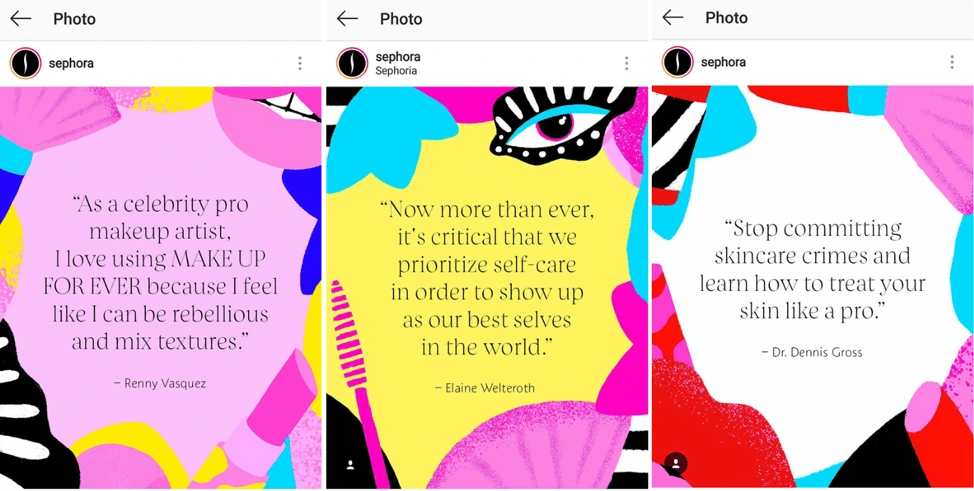
Source: Sephora
If you want to be remembered for a certain color or type of imagery, or if you want your logo to be visible on the feed and not just in your profile photo, turn to Instagram post templates. Some examples are backgrounds for text posts or borders to place around photos. They might include your logo, brand name or slogan and should be used when appropriate—not all the time, but just enough to be noticed.
You can use these templates when you share some of your favorite quotes to Instagram, which can make an otherwise plain text post look interesting. You can also place template borders on user-generated content that you’d like to share on your profile—especially useful if you’re running an Instagram giveaway or photo contest using a particular hashtag that can be incorporated into the template.
Remember to mix it up once in a while as well. While you want it to be memorable through retention, you don’t want it becoming stale. Try mixing it up every month or two and changing it according to season or campaign.
4. Have a consistent photo-editing style
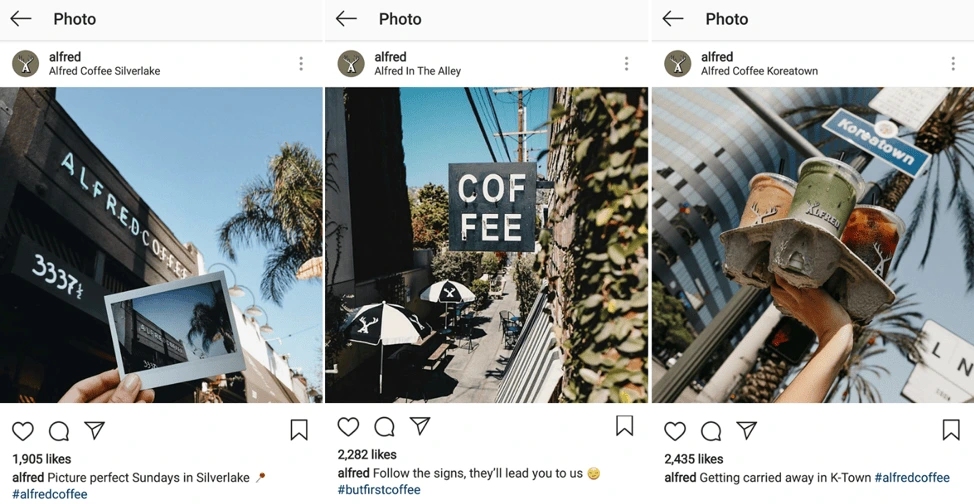
Source: Alfred
Once you’ve identified the feel of your brand and the colors you associate it with, fold that into the way you edit photos. Color has long been known to be a powerful force in marketing, and by post-processing images before you post them online, you can influence what they convey.
Use a similar editing style with your pictures so they all communicate your message—and slowly, users will connect that feeling to your brand. Away from your computer and need something quick? For extensive editing on the go, download a reliable photo application like Instasize to your mobile phone.
5. Do social media right
Last but definitely not least, make the effort to use Instagram right.
What does this mean? No matter the amount of content you share, and no matter how elaborate your photo editing is for each image, your efforts won’t matter if you don’t make use of the rest of the platform. Instagram has boomed—and so has its features.
One of the biggest don’ts of Instagram right now is to post strictly to the feed only. Instagram also has Stories and IGTV, the former of which can be an informal way to connect with your customers, while the latter gives space for long-form videos that followers would otherwise miss.
Of course, don’t let all your efforts towards keeping your visual identity end with social media. After all, using Instagram is just one step in the marketing funnel. Creative consistency builds trust, showcases reliability and improves customer perception—especially in visual branding. Keep your branding consistent across touchpoints before, during and after purchase, and you’ll be crafting a brand story customers won’t forget any time soon.
Want to know more about the power of brand consistency? Download our free 32-page report, chock full of stats & great insights.
Social media has changed a lot over the last decade—and the way marketers manage social media channels has changed, too. Few marketers have the bandwidth to stay on social media all day, curating and sharing content as they go. Many of us have additional job responsibilities, and we have to be structured and deliberate about the time we dedicate to social.
Related: 6 effective social media strategies to increase brand awareness
Fortunately for us, there are lots of tools out there designed to make social media management easier and more efficient. From finding sharable content to scheduling posts, the 30 tools listed below can help you streamline and automate the tasks you can—so you have more time to spend on the ones you can’t.
What is social media automation?
Before jumping into the list and trying out the tools, let’s quickly clarify what we mean by automation. Social media automation is using software or tools to accomplish specific tasks on social media platforms without human intervention. Put simply, it means using a program to automate things like posting and sharing content on Facebook, Twitter, and other platforms.
30 best social media automation tools
Without further ado, let’s get to our list. You’ll find big players and small players here, with a variety of specialties and capabilities, so there’s something for everyone. The descriptions are short, just to give you a general idea of each tool’s primary strengths. If you want more info, give one a click and check out their website.
Our picks for the 30 best social media automation tools out there today are…
1. Buffer
One of the market leaders, this popular tool lets you schedule & publish upcoming posts across all of your social media accounts. It also offers excellent analytics on your campaigns.
2. Hootsuite
Hootsuite is another popular choice. You can use it to schedule your posts and monitor the competition. Using search streams, you can more easily build a community of followers.
3. Workflow
With Workflow, you can craft the ideal workflows (hence the name) so that the right content is always shared at the right time.
4. SocialPilot
The tool automates the process of scheduling content across various social media accounts. You can also learn more about your followers, so you can determine the right content to post.
5. IFTTT
An acronym that stands for “If this, then that,” this free tool lets you set up rules for how different tools, apps and social media platforms trigger one another. It’s a simple concept that’s hard to explain, so pop over to their website for details and examples.
6. Sendible
The tool is designed to help you schedule updates, reply to followers, create reports, and collaborate with others.
7. Later
Later is a powerful tool for Instagram scheduling that boasts over 600k customers. Unlike many social media tools, you can use this one to manage comments.
8. Tailwind
Tailwind is an automated scheduling and analytics tool that’s great for Pinterest. It will recommend the best times for you to post to reach your audience.
9. CoSchedule
This application helps you to schedule all your posts. In fact, you can schedule over 60 posts at once! You can also use it to lay out your social media calendar.
10. Post Planner
This simple tool helps you to find content and schedule posts for your social media accounts.
11. Iconosquare
Iconosquare arms you with personalized information about your social media accounts that will help you manage activities more efficiently.
12. Agorapulse
You can easily plan and schedule posts across your social networks with this tool, but it’s also useful for tracking performance.
13. Crowdfire
This automation tool helps you root out inactive Twitter followers. It’s also worth using if you want to discover the right cadence and content to share with your audience.
14. Socialert
Social media listening is made much easier when you use this tool. Again, it’s all about finding the best content for your audience and being part of conversations as they happen.
15. BuzzSumo
BuzzSumo is popular with content marketers because it’s great at finding trending topics. Results can be filtered based on location and domain. You can also find influencers here and start building relationships with them.
16. Scoop.it
With this tool, you can easily curate content from other sources and share in a way that reflects your brand’s personality and values. You can also use it to set up a smart social calendar.
17. Pocket
This “read later” tool lets you save content you find around the internet. The service is free, and you can access it anywhere, so you’ll never lose track of that one awesome article you found again.
18. Sprout Social
Designed to help small businesses use social media more effectively, this tool automates posting. It can also help you engage with an audience and monitor the competition.
19. Mention
You’ll never miss a conversation your brand is mentioned in when you use this tool. It’s also great for identifying influencers and monitoring keywords in real time.
20. TweetDeck
TweetDeck is an awesome free service for social media listening on Twitter. You can set up custom timelines to track brand names, usernames, hashtags, keywords and more.
21. SocialOomph
SocialOomph makes it really easy to manage your Twitter accounts. Effortlessly schedule tweets, track keywords, and more.
22. MeetEdgar
MeetEdgar is a fascinating take on social media automation. You can build a library of content you’d like to share across different platforms, and Meet Edgar will automatically schedule it for you—including repeat posts. It can even write variations of your posts to keep things fresh.
23. Everypost
Everypost is perfect for brands who want to schedule and share visual content on social media.
24. Facebook Pages Manager
No surprise here, this app helps you manage your Facebook pages effectively. You can get insights on traffic, clicks and views from its main menu.
25. Zoho Social
With Zoho Social, you can schedule as many posts as you like and monitor keywords & trends. It’s great for teams who collaborate on social media.
26. SocialFlow
This is one of the best tools for publishers, because it replaces arbitrary scheduling with data-driven scheduling, so your audience is engaging with you in real time.
27. Social Studio
Social Studio by Salesforce offers marketers a range of features such as publishing posts across various platforms, social media listening, and managing marketing commands.
28. Sprinklr
This tool helps you to achieve end-to-end social media marketing management. Data is unified across platforms, and publishing is automated.
29. DrumUp
DrumUp is an interesting tool that helps you discover and share meaningful content with your audience.
30. Kontentino
The last tool on our list provides you with easy, flexible workflow management. Content is easy to schedule, share and modify.
Bonus: Lucidpress
That’s right—it’s yours truly! If you’ve used Lucidpress before, you might be asking yourself: Why are we including ourselves in this list?
The answer: because Lucidpress has a host of new features that actually make it easier than ever to streamline social media for brands.
Everyone knows we offer some of the best free social media templates around—but have you ever considered creating your own branded templates with certain elements locked down?
Imagine if, instead of starting with a blank slate, you could always start with a perfectly sized template that uses your brand’s colors, fonts & logos. That would save a lot of time, right?
Don’t forget, you can share your Lucidpress designs straight to Facebook, Twitter and Buffer… without ever leaving the tool. That makes it a one-stop shop for creating beautifully branded social media posts and sharing them to your platforms of choice.
Key takeaway
Social media automation helps you discover and share the right content at the right time. Automation tools can also help you analyze audience behavior, monitor conversations, keep an eye on competitors, and more. For the best results, consider your business’s goals with social media (and your preferred budget) before selecting a tool.
Ready to drive more leads and engagement with social media? Grab a copy of our free ebook: How to adapt your brand to social media
Twitter began in 2006 as an online message board that was updated via text message. Since then, it’s grown into one of the largest social networks, boasting more than 300 million users who combine to produce 500 million tweets daily.
Related: How to drive traffic with social media
Marketers have been slow to catch on to Twitter, though. Recent reports estimate that only 65% of businesses use the platform for advertising, which gives you plenty of time to get ahead before the rest of the competition arrives and sets up shop.
In case you need more convincing, these 11 benefits of using Twitter for marketing can help you cross the divide.
1. Direct messaging creates genuine connections
Like its main competitors, Twitter has a direct messaging feature for private conversations between two users. However, the main difference is that the two accounts must mutually follow each other (unless one user has their inbox set to “open”) before they can contact one another.
This might seem like a hurdle for marketers who want to connect with influencers or other important industry players, but reserving direct messaging for mutuals ensures your conversations are worthwhile, engaging, personalized and authentic.
2. Tags encourage engagements
The @ symbol on Twitter goes a long way. It’s the key to sending other users a notification that almost guarantees your tweet, or the tweet you wanted the @ recipient to see, gets viewed. Also, it’s easy attribution for a quote or an article you share on the platform.
Twitter has branched into content discovery, so users now see occasional tweets from people they might not even follow. This is more likely if multiple users in a network like a tweet. The algorithm then guesses you might also want to see content similar to what’s already in your network. With this feature, your tweets with engagement can end up in front of new eyes, thus increasing reach and engagement.
3. Posting multiple times per day is expected, not annoying
According to data averaged from multiple studies, Twitter is the only social network where marketers are recommended to post up to 15 times per day. Unlike its main competitors, Facebook and Instagram, Twitter is still heavily chronological. Tweets have such a short lifespan in the ongoing feed of posts that regular updates are necessary to stay relevant.
Marketers should take this opportunity to integrate a varied mix of content that entertains and educates their Twitter following and keeps them engaged. The platform allows text, images, video, live video and polls that can all encourage conversation in different ways.
4. Twitter best showcases your brand voice
With a more robust posting schedule, Twitter is a network where a brand can develop its voice and public personality. Depending on the industry, tweets can have an authoritative voice or even a sassy tone.
Fast food companies have revolutionized branding with Twitter in an especially notable (and comedic) way, from the rap battle between Wendy’s and Wingstop to the clapbacks from Taco Bell. Even forgotten brands like MoonPie have been resurrected via Twitter; now MoonPie has a strong following of 279,000 that look forward to its self-deprecating humor on a daily basis.
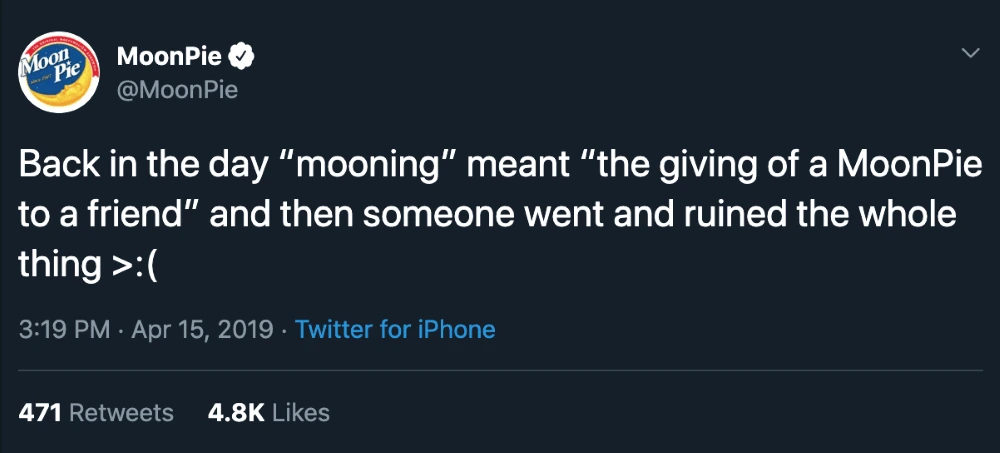
Source: Twitter
Your consistent brand voice is also archived for prospective customers who are using Twitter to research how you interact with your followers. Twitter’s open format leaves nothing to the imagination, and some have experienced the fallout when old, problematic tweets resurface at inopportune times.
5. TweetDeck lets your monitor Twitter for free
If you have a Twitter account, you also have access to TweetDeck. It’s a free tool that specializes in monitoring. Simply identify accounts, keywords or hashtags you want to follow, and watch as TweetDeck creates individual feeds for your selected parameters. This is an effective way to stay in the conversation, because you don’t have to use the main Twitter platform to search keywords one by one and possibly miss an important tweet.
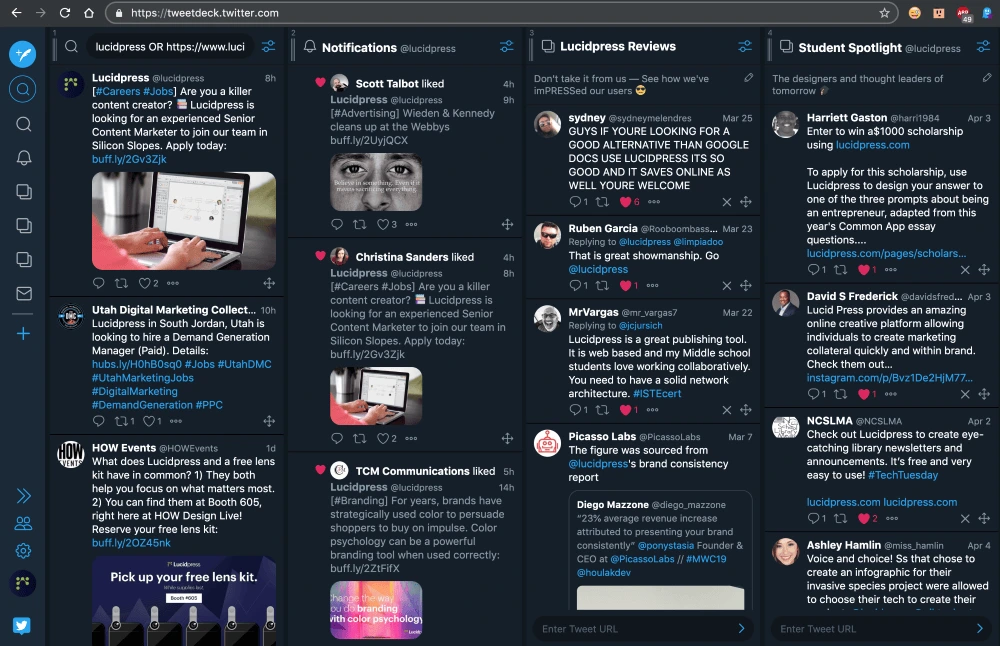
The Lucidpress TweetDeck
TweetDeck lets you watch your competitors’ activity and community all at once, which makes it an impactful tool for poaching customers. For example, if you see a user complain about a competing brand because you’re tracking their name as a keyword, you can reply and recommend your brand as a viable solution that addresses their pain points.
Keyword monitoring also keeps marketers in-tune with discussions about relevant industries, so future strategy can address industry topics. Rihanna’s company, Fenty Beauty, is popular for its vast array of makeup shades designed for all skin tones. By identifying a pain point—makeup is non-inclusive to people with darker skin tones—the company addressed it with real action and enjoys success because of it.
6. Influencers can boost your campaigns
In 2019, there’s no doubting the power of the influencer, a modern-day social media celebrity. Marketers have found that influencer campaigns yield an average return of around $7.65 for every $1 spent. However, Instagram is oversaturated with individuals pushing products, which makes influencer campaigns that much fresher on other social networking sites.
Twitter, in particular, has massive potential for marketers. That’s because there’s a 2x increase in purchase intent when consumers see tweets from both brands and influencers. Also, 49% of Twitter users responded that they rely on recommendations from influencers, and 40% have made a purchase solely based on a tweet from an influencer. The numbers don’t lie, and they show an opportunity marketers can’t find in many other places.
7. Your profile will drive traffic to your site
Social media profiles are the new homepage. [![]() ] As mentioned earlier, Twitter is the place to develop and showcase a brand voice, so users will often visit a brand’s Twitter profile to get a better feel for the brand. About half the time, that visit will inspire further research, namely due to the fact that 47% of the people who visit a Twitter profile also visit the website linked to that profile.
] As mentioned earlier, Twitter is the place to develop and showcase a brand voice, so users will often visit a brand’s Twitter profile to get a better feel for the brand. About half the time, that visit will inspire further research, namely due to the fact that 47% of the people who visit a Twitter profile also visit the website linked to that profile.
Marketers should keep in mind that brand voice should be consistent and seamless across channels, so a playful Twitter account shouldn’t lead to a landing page with overly serious language. Otherwise, consumers will end up confused and leave the page without converting.
8. Follower insights help you develop your follower persona
Twitter users are given native analytics within the platform, and they’re some of the best across social media sites. In particular, the Audiences tab helps marketers paint a picture of their average follower.
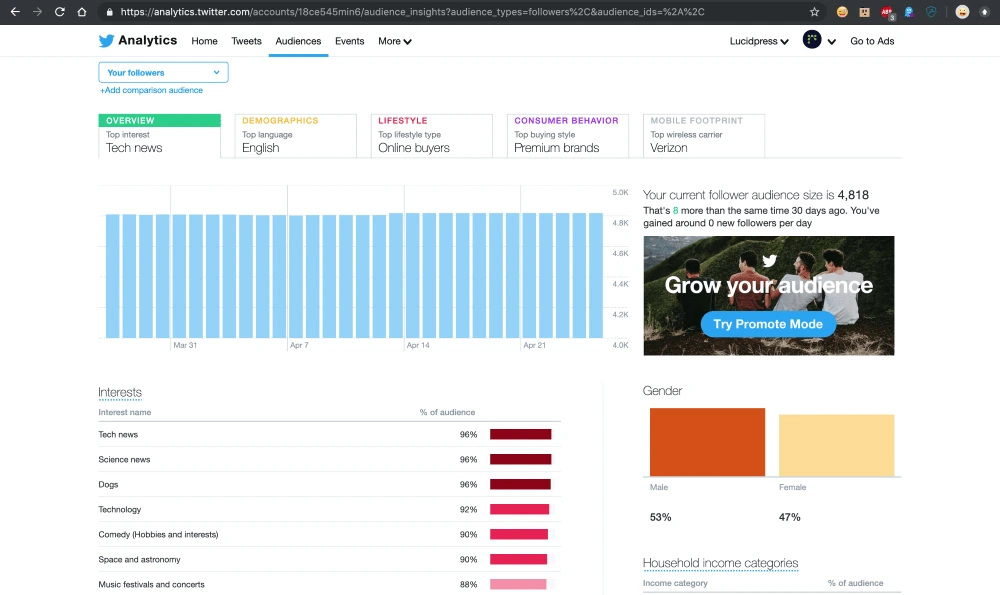
The Lucidpress Audiences tab
Audiences has four categories: Demographics, Lifestyle, Consumer Behavior and Mobile Footprint. The data delivers insight into your followers and their interests—as well as how they interact with brands, which is helpful to know before launching a campaign. With your follower persona in mind, you can aim directly for Twitter users who match the kind of people following you already.
9. Advertising spend is low & effective
Advertising on Twitter costs as little as one dollar per day, but its real strength is optimization. Twitter Ads guides marketers of all experience levels through the campaign creation process by suggesting parameters to maximize impact. Then, if the setting is selected, the platform will pace spending based on results to ensure marketers aren’t spending unnecessarily.
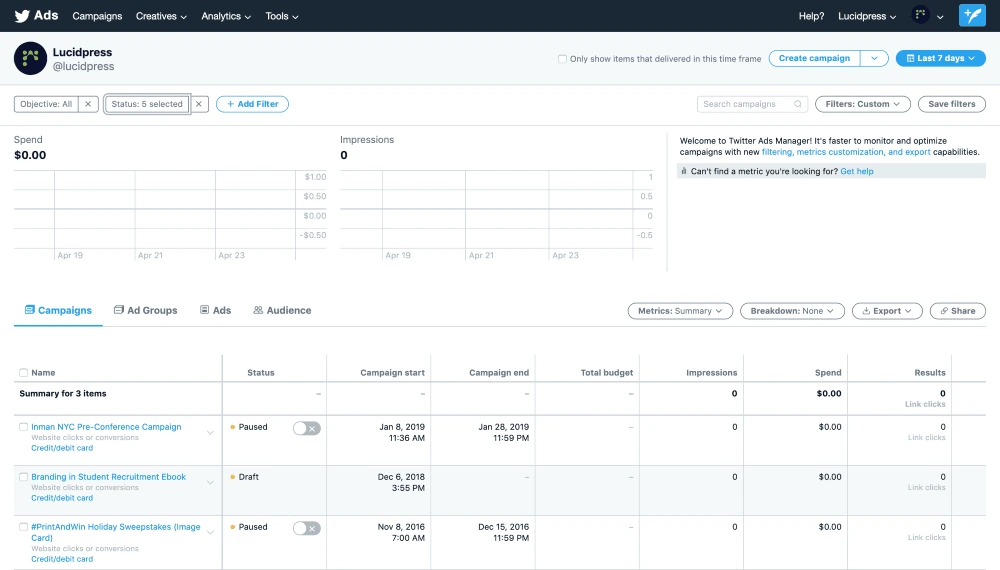
A heavily filtered version of Lucidpress Twitter ads (can’t give away all our secrets!)
As you gain experience, you can also experiment with A/B testing, using different campaign types or applying other settings. It’s customizable and incredibly user-friendly. The best part? Independent research shows that Twitter marketing campaigns can deliver 40% higher return on investment when compared to other media channels.
10. Community management is possible with branded hashtags
Hashtags are still the king of social media discovery tools, especially when marketers use branded hashtags. Created by brands to give consumers a way to share their experiences on social channels, branded hashtags comprise 70% of the total hashtag landscape.
Marketers can use these niche spaces to easily follow their brand communities online. Whether it’s to participate in a Twitter conversation or to find user-generated content for future tweets, there’s tremendous potential.
11. Anyone can go viral
One of the best parts of Twitter is its capability to spread a message like wildfire. Anyone who uses the platform regularly sees multiple tweets per day reach viral status because they’re funny, relatable or newsworthy. Those tweets can come from anyone, no matter how few followers they might have.
Brands can similarly go viral with a tweet, which immediately increases reach, traffic and conversions. All it takes is a well-timed post that resonates. The sky—or, should we say, the 280-character count—is the limit.
What are you waiting for?
Follow @lucidpress on Twitter today! Just kidding. …Mostly. Okay, here’s what we were actually going to say.
Twitter is a unique marketing channel with huge opportunities for brands looking for a new way to reach prospective customers. It’s not yet full of business accounts, and it has maintained the authenticity that’s lacking on other social media sites—which has resulted in a dedicated user base that’s tired of Instagram’s careful curation and Facebook’s fake news.
Marketers always need to have new tricks up their sleeve to adapt to the ever-changing landscape of digital advertising. They should not overlook Twitter if they want to make an impact. It’s perhaps one of the purest platforms left, and the possibilities are wide-open to incoming brands.
Ready to design your own branded Twitter content? Hop over to our free Twitter template gallery and get started!
Editor’s note: This post was updated July 24, 2020.
If you’ve landed on this blog post, I don’t need to tell you that striking visuals are critical for marketing your SMB. But just in case you need some convincing, consider that blogging and social media are now the most commonly used formats for content marketing.
It’s well established that blog articles and social media posts perform far better when paired with visuals, but content marketers suffer from small budgets and big expectations.
Is social media worth it?
No matter how you look at it, maintaining a positive presence on social media is an uphill battle, especially for small businesses who don’t have the resources to devote one or more full-time employees just to social media.
So, what’s the secret? Success comes from a combination of factors, including the quality of the content and graphic design itself, the underlying marketing strategies (think: giveaways and crowdsourcing), the product and timing.
When these factors do work together, social media can change the very fabric of a company’s marketing strategy. For instance, t-shirt maker Sevenly donates to charity for every shirt sold. The company teams up with multiple charities and causes and designs a unique t-shirt to match.
Their posts on social media tend to be well-shared, since individuals who can’t afford to donate can help the cause by simply sharing the post:
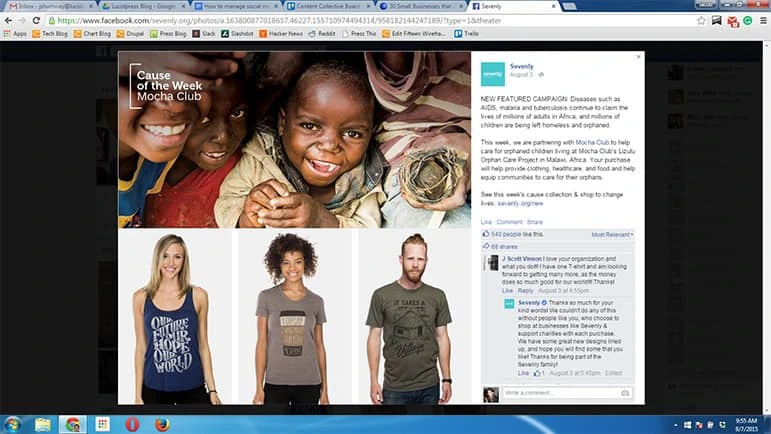
The point is that social media content will only be as effective as your business model and marketing strategy empower it to be. Once you have that strategy in place, supporting and implementing it on social media is actually the easy (and fun) part.
5 graphic design tips to get your started
1. Have a goal
Every social media account should have an overall goal, and every post should have an individual goal. Think of the account’s goal as an overall theme your followers can expect you to follow. For example, will your Instagram feed be used to showcase graphics of your latest products or to share informational content related to your brand? Or are you creating a community for your customers to interact with your brand and with each other? Define this theme along with your target audience. Each individual post should contribute to this overall theme and drive measurable metrics for your brand: engagement, clicks and purchases.
2. Be creative
Whether you’re an experienced designer or not, everyone can be creative when creating social media graphics. Incorporating storytelling techniques is a great way to do this. Think about who the main character is, what the problem or challenge is that they are facing and how they are solving it. Then tell that story visually.

Source: Pinterest
3. Remember design best practices
Social media graphic design follows a set of best practices that will make your designs pop. When selecting color, be sure the colors you choose contrast enough, so the content is easy to read. Experimenting with fonts is a great way to add some playfulness to the post’s design, but be sure it is still legible. Balance out fun fonts with a second, simple font. Overall, keep the design simple so your audience will understand the message you’re trying to get across.

This informational poster is a great example of font utilization.
4. Be consistent
Social media is a great way to build your brand, but only if the social media designs you create are consistent with that brand. Be sure to incorporate your brand’s colors and fonts into your social media designs and avoid any content -visual or otherwise- that doesn’t accurately reflect your brand. Learn more about social media branding.
5. Use the right tools
With the right tools, even non-designers can create stunning social media graphics. Here’s how you can create awesome graphic designs for your social media sites in just minutes.
Step 1: Pick a template
After logging in to Lucidpress, click the drop-down arrow next to +Document to view our free templates. Click Social media, then pick the template that corresponds with the social media site you’ll be posting to (this ensures that the image has the correct dimensions).
Alternatively, you can save time by creating a single document, then linking back to it in each of your posts.
I’ll be building my content from this Facebook post template:
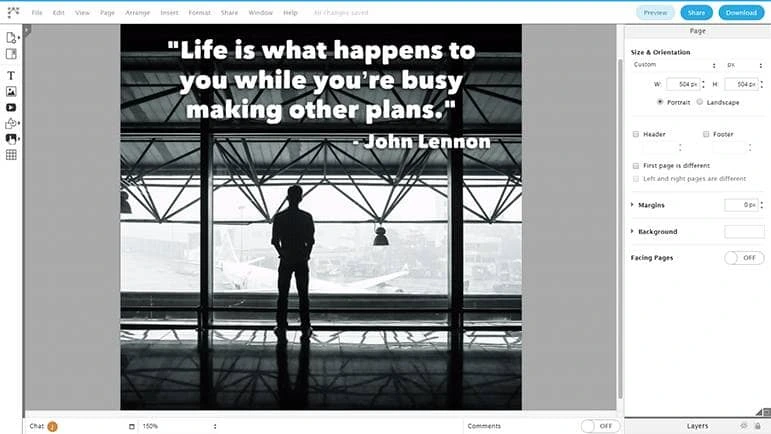
Step 2: Customize
In this step, switch out the template’s content with your own. Then, adjust effects, fonts & positioning to get the perfect layout.
Since I want to emphasize my product’s creative capacities, I’m going to make a meme about the power of imagination.
First, I double-click to replace the text with my own. I test out several fonts before selecting Hill House. Next, I delete the background photo. After dragging and dropping an image I found on Pixabay onto the canvas, I right-click it and select Send to back so it doesn’t cover my text.
Finally, I add a text box on the bottom right to include our brand. Now it’s ready:

Step 3: Publish & share
Before you can share your document on social media, you’ll need to publish it with a unique URL. Click Share in the top-right corner, then click Publish under the On the web tab. Finally, go to the On social media tab to share your brand-new content on Facebook, Twitter, Google+ or LinkedIn.
Type a short, custom description for each post you make. If you’re not sure how to adapt your post’s text for each site, consult this now-famous comparison of social media sites:
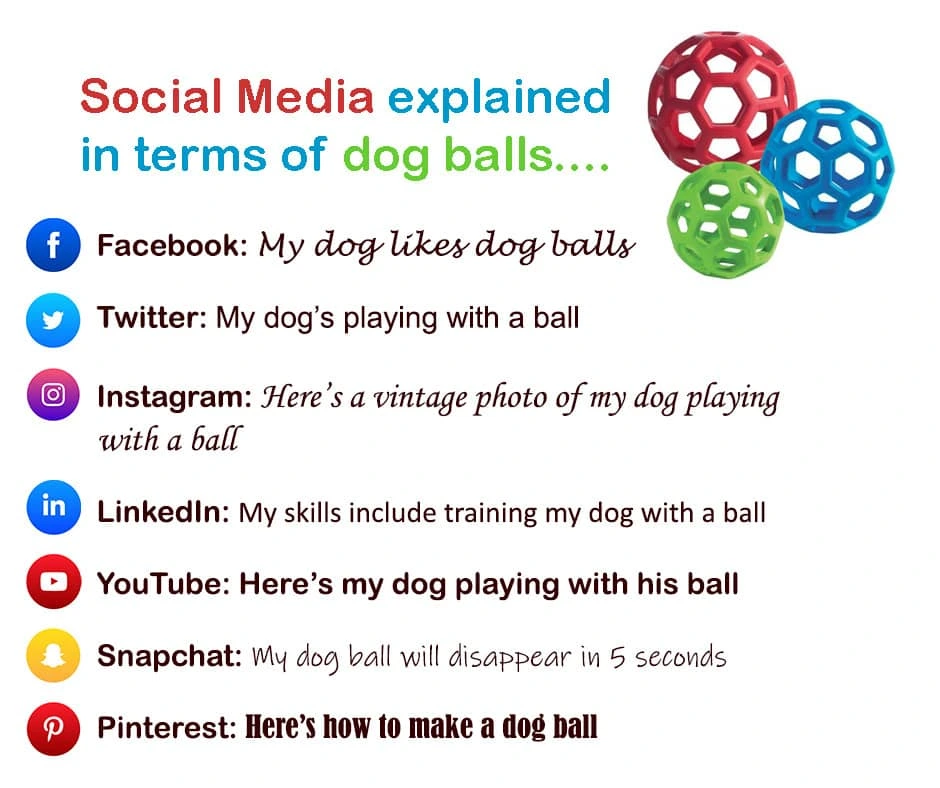
And that’s it! You’ll be creating and sharing social media posts like a pro—without spending hours in complicated design software.
Ready to make your own social media posts? These free templates are a great starting point.
Social media can help real estate agents find a wide audience, in the right area and at the right time.
In fact, according to the National Association of REALTORS 77% of real estate agents use social media. Facebook is by far the most popular platform in real estate, followed by LinkedIn and Instagram.
Related: Real estate marketing guide
Even with limited resources, savvy real estate agents can build meaningful relationships and earn more clients with social media.
How do you do it?
The sheer array of social media platforms and real estate marketing techniques seem overwhelming. Here are seven and a half practical tips to get you started in no time.
Social media for real estate tip #1: The basics
If you are already set up on social media, go ahead and skip ahead to the advanced tips below.
Facebook for real estate
To get started, set up a business page on Facebook. This is more professional than posting to a personal account and gives you access to useful business features such as page analytics and the ability to promote posts to your audience. Posts with images and video perform best on Facebook, so be sure to use compelling visuals with every post you create.
The Facebook algorithm favors posts that get a lot of engagement, so ask questions to drive comments or share content your followers will enjoy such as an upcoming local event, so they like and share it. If you’re just getting started and don’t have a large social media following yet, holding a contest to bring awareness of your real estate page is a great way to build up your follower count.
Instagram for real estate
Instagram is quickly becoming one of the most popular social media sites. As a visual platform, every post will need to be visually compelling. Use the caption that goes with the photo to provide additional details and include your contact information. A single Instagram post can be made up of a series of images, making it a great way to show photos of a new real estate listing.
LinkedIn for real estate
Update your personal profile and if you are running your own business, create a page for the business as well. LinkedIn provides a great opportunity to network with other real estate agents, connect with real estate brokerages and connect with current clients.
Social media for real estate tip #2: Start two-way conversations
A staggering 94% of millennial homebuyers are taking their search online. This creates incredible opportunities for real estate agents to connect with them there—but only if they truly understand their audience’s motivations.
It’s tempting for real estate agents to promote their business and new home listings relentlessly on social media. After all, isn’t that what those platforms are for?
Not exactly. For potential homebuyers, constant, in-your-face promotion has minimal appeal. If they wanted endless advertisements, they could just flip open a magazine or turn on the TV. Treating them this way shows a fundamental lack of understanding about your target audience.
The vast majority of potential homebuyers are searching for information. They have questions. If they’re considering buying for the first time, they’re probably intimidated, too.
Savvy real estate agents use social media to walk everyone through the process, creating stronger bonds than the constant sales pitch approach. Instead of just posting endless promotional content (a one-way broadcast), you open up two-way conversations. The audience becomes a key creator of the shared experience.
This takes on many forms. It might be searching Twitter hashtags and offering real estate advice to those in your local area. Tomorrow it might be hosting a Q&A session on Facebook Live. Next week it might be something as simple as asking a question in your newest listing photo caption on Instagram. Whenever you can, invite your audience to participate in the conversation.
Yes, you can still find opportunities to promote your real estate listings. But, a commitment to being relentlessly helpful builds trust and authentic relationships.
Social media for real estate tip #3: Choose your social media platforms wisely
Social media is fast-paced, chaotic, and changing constantly. It’s easy to get overwhelmed by the sheer number of platforms.
Real state agents new to social media might feel the pressure to “be everywhere.” Pressed for time already, they drive themselves crazy trying to maintain a presence on a dozen different accounts.
This approach actually leaves them worse off than before. Because they’ve spread themselves so thin, it’s impossible to get the traction needed to build an audience on any platform.
What could you do instead?
Start by taking a deep breath. Acknowledge there are tons of platforms out there—and a lot to learn. And accept that you’ll see the best results for your real estate business by focusing on just a few right now. Begin the journey with proven social networks like Facebook, Twitter and Instagram.
Which platforms deserve the majority of your focus? A lot depends on your audience. Beyond the overall popularity of the platform, consider where your target market spends their time online. You wouldn’t want to launch a Snapchat strategy when trying to sell retirement condos—the demographics there skew too young. If you’re selling commercial real estate, consider connecting with successful professionals and industry organizations on LinkedIn.
Do some preliminary research to pinpoint where your audience is most engaged. Other real estate agent’s and brokerages accounts can be a great place to start. Using those insights as a guide, narrow your focus to a few platforms as availability allows… which brings us to the next point.
Social media for real estate tip #4: Post consistently (and strategically)
A successful social media for real estate strategy is a lot like a successful relationship-building strategy in real life. You need consistent contact—and interactions that provide value and motivate people to keep coming back.
The goal: create enough interactions for your audience to get to know you as a real estate agent without overwhelming them to the point they tune you out.
This is a delicate balance to maintain, but the good news is it’s something you can always adjust as you go. Feedback from your networks (whether you’re gaining or losing followers, their engagement, etc.) will tell you if you’re headed in the right direction.
You can use social media software to schedule posts beforehand. This gives you the freedom to meet with clients, work open houses, and attend closings all while building your presence automatically. It’s easy to post multiple times a day this way.
Posting frequency is one thing, but you also have to consider the nature of the content itself. Most content breaks down into three different types:
- Time-sensitive/promotional. These posts advertise new properties on the market, open houses, or your brand in general. Think of listing photos, tweets urging prospects to give you a call, and virtual tours with Facebook livestreams or 360-degree photos.
- “Evergreen” how-to or informative. This content answers questions, shares tips, or finds alternative ways to provide value. It’s just as valuable a year from now as it is today. This could be decorating tips, a checklist to help you see how much house buyers could afford, or cool DIY renovation project ideas.
- Fun or entertaining. This content might not be directly related to real estate, but it’s a great way for you to showcase your personality. It might be a review of a new restaurant in town, a heads-up about traffic on the way home, or even those viral cat photos. Social media just gets prospects in the door. It’s your personality and expertise—real-life relationship skills—that will close the deal.
Understand the goal of each post you make, and mix things up to engage your audience and keep them coming back.
Finally, remember that there’s no need to create all this content yourself. Supplement your own efforts by sharing, retweeting or linking to other great content in the real estate industry. Your clients are a great content source—whether it’s sharing a quote from their testimonial or a photo of them toasting a new home.
Social media for real estate tip #5: Incorporate storytelling
Every great real estate agent knows how to tell a compelling story. Include that storytelling element in the social media content you create.
Some examples:
Talk about the neighborhood. When posting a new real estate listing, do more than talk about the price and features of the home. Create a compelling story by including details about the neighborhood. Help the potential buyer picture what it would be like to actually live in that home.

A post shared by Dusty Baker (@dustyjbaker) on Nov 14, 2017 at 10:46am PST
Include client testimonials. Ask happy customers if they’d be willing to create a video testimonial. Testimonials make compelling stories that help build trust with your audience.
Share milestones. On LinkedIn, share milestones of your real estate business. This could be anything from 10 years in business to updated branding or a new website.
Using storytelling in your social media campaigns will help drive greater engagement and build trust with your audience.
Social media for real estate tip #6: Use great, on-brand visuals
Social media has transformed the way realtors and agencies connect with potential buyers and clients. Because of the visual nature of house shopping, it’s easier than ever for people to go online and find examples of their dream homes.
Ideally, this should make real estate marketing faster and easier… but unfortunately, that’s not always the case. If you’re unfamiliar with Photoshop or other desktop publishing software, it can be difficult and time-consuming to create content specially for each social media site.
Instagram is a completely visual platform, which makes it perfect for marketing real estate. Photos are nice to have, but it can leave buyers confused as to what to do next—”Is this property for sale or just for show?” they might be wondering. By using this square photo collage, you can show off multiple views of the property and guide folks toward the next step: contacting you for a walkthrough or an offer.

Speaking of visual platforms, Pinterest is a haven of gorgeous home ideas, which makes real estate a natural fit. Pinterest users build boards to house (heh) their pins, all of which come from various sources. It’s easy for your name or website to get lost in the shuffle—unless your images themselves are clearly branded. That’s what makes this perfectly sized Pinterest template a cut above the rest. The majority of space is reserved for eye candy, but all the important property details are right there, too.

When you want to get a new listing out fast, no platform is better than Twitter. Not only can you keep your followers in the know, you can also target new audiences with paid promotion to get the most mileage. Because things move so quickly on Twitter, it’s important to design posts that are easy to digest. This template is oriented horizontally; it’s compact and looks great on both desktop and mobile.
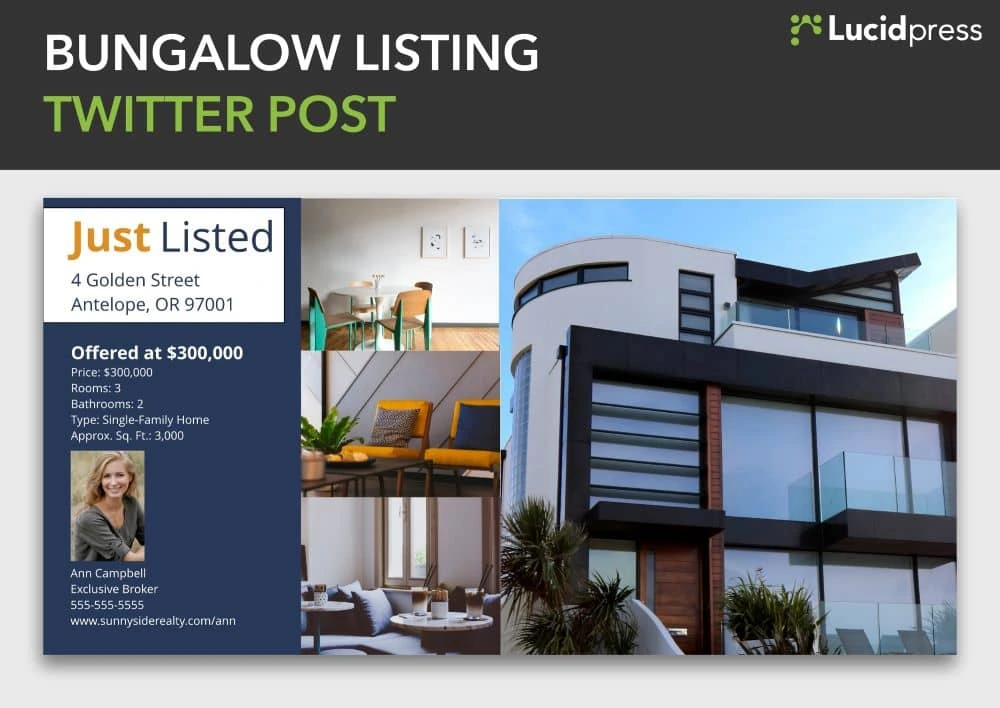
Social media for real estate tip #7: Remember your past clients
Social media is a great tool for realtors to build relationships and land clients. But, that’s only part of its appeal. It can also help maintain relationships you’ve already developed.
What happens when those closing papers are signed? Clients feel a rush of adrenaline, but after a few months, everyday life creeps back in. An incredible 70% of homeowners can’t even remember their real estate agent’s name one year after closing.
It’s a shame to have those relationships slip away after you’ve spent so much work building them. With a little social media love, it’s much easier to maintain them. That way, when clients are ready to move again or recommend a realtor to family or friends, you’ll be the first person who comes to mind.
How can you do this on social media?
Release a steady stream of that evergreen content we mentioned earlier. Brainstorm all the things you wish you knew when you moved into a home. Is it design inspiration? Checklists to get organized? Ways to prepare for the winter or save money on utility bills?
You can also broaden your content from real estate itself. Now that your client has moved, they’re living, working and integrating into the community. They might be interested in that new restaurant down the road. Or the best summer camps to send their kids. You can become their go-to source for all things local.
Social media for real estate tip #71/2: Measure and keep learning
You’re sending emails to clients, working open houses, and putting out yard signs. (Not to mention trying to keep up with your own personal life.)
You don’t have endless hours to pour into social media that isn’t paying off. How are your tweets performing compared with your Pinterest posts? Should you be posting on Facebook or focusing on Instagram?
These are the questions that can frustrate you to no end. Instincts might give you some indication, but measuring will let you know for sure.
Fortunately, it’s never been easier to collect data on social media performance. It’s easy to see which posts get the most engagement in terms of likes, retweets and comments. But, if you’re looking to see what’s really moving the needle in terms of sales, why not create unique landing pages for each platform?
A landing page simply directs visitors whenever they’re interested in contacting you, seeing a new listing, and so on. Tailoring them for each social media platform allows you to track where leads come from. You can also find out a lot more about each user’s interactions with your brand and their path to becoming a client.
Keep an eye out on which platforms, campaigns and topics perform best. As long as you keep tracking your analytics and tweaking your strategy, it will gradually get more effective. This optimization process never ends, but the payoff increases over time.
Over to you
Social media has become an essential piece in every realtor’s marketing toolkit. Thankfully, it doesn’t have to be overwhelming anymore. Apply the tips above while launching your real estate marketing strategy, and you’ll build an impressive audience, engage them, and bring in more business.
Kickstart your next social media campaign with our free templates for real estate.
If Instagram feels unavoidable these days, it’s because it is. The social media giant has over 1 billion monthly users and 90% of them follow at least one business. Needless to say, it’s smart to have an Instagram presence for your brand.
A business Instagram account can seem imperative, and they’re also a lot of work. To keep your followers engaged and maintain a consistent brand presence, you’ve got to post regularly — at least a few times a week. All that posting means you’re going to need a solid social media planner (maybe even a team!) to get your content ducks in a row.
Related: Free Instagram post templates
Coming up with content for Instagram can get old quick: You’ve got to strike the right balance of human-interest topics, brand promotion, aspirational content and customer engagement. Just posting high-quality images isn’t enough to drum up excitement for your brand. You also need to know how to drive engagement and which types of posts can boost sales. Here are 6 tried-and-true Instagram post ideas to help you get started.
What to post on Instagram
1. Endorsements
“Influencer” has quickly gone from being a kind-of-funny thing to becoming an actual profession. Influencing sells, period. People are genuinely interested in what other people are doing, and we love a recommendation.
And even if you’re not ready to hire a handful of socially adept personalities who shine in front of a camera, you can always lean on endorsements and product reviews from other people — whether that’s a well-known celebrity, industry expert or an average joe.
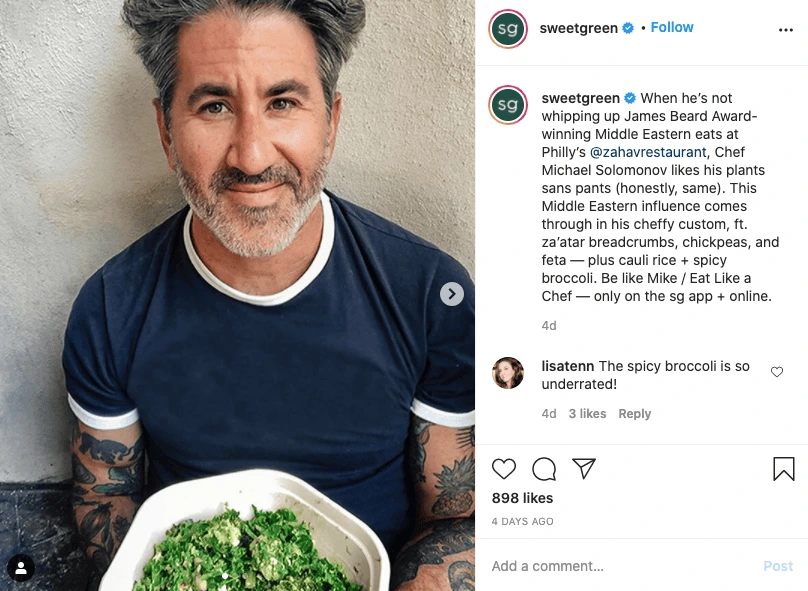
Source: Sweetgreen
Sweetgreen regularly posts content that features chef’s favorites from their restaurants. This does a few things:
- It offers social proof. It lets you know that experts in their field (chefs with highly refined taste buds!) frequent Sweetgreen, i.e. the food must be high quality and delicious.
- It satisfies curiosity. What are successful, talented people eating at Sweetgreen? Now you know.
- It’s far more interesting than a bland product-promotion post. Having someone else recommend your product and put their own spin on things helps spice up the content.
There are lots of different ways to feature endorsement-related content that will entice your followers. Brainstorm how you can use your current customer base to review, endorse or promote your products on Instagram.
2. Giveaways
Let’s be honest: Everyone loves free stuff.
It’s no secret that the word free is powerful, and many marketers use it in their copy to grab shoppers’ attention. That’s why samples and giveaways have become such a popular promotional tactic.
When you give away your product, you attract a larger audience of people willing to try your brand. It’s an opportunity to build brand awareness and encourage shoppers to try your product before buying it. Plus, it lowers the risk of trying something new.
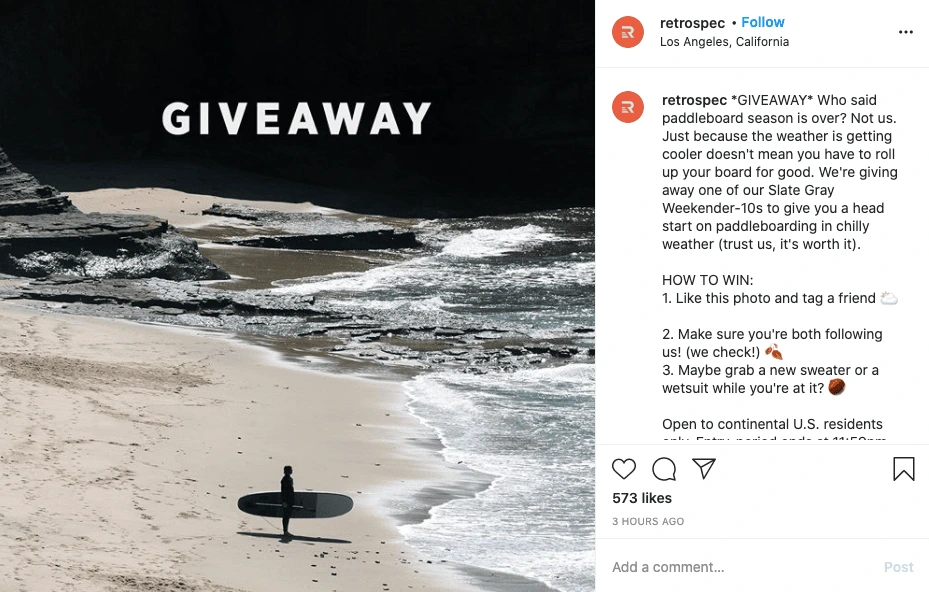
Source: Retrospec
Take Retrospec, for example, who gave away a much-sought-after paddleboard to keep their followers interested and engaged.
Since people love free stuff, this type of post often goes viral, attracting more followers who want a chance to win. If you want everyone to feel like a winner, you can even offer a discount to all entrants.
One point of caution: Not everyone who enters your giveaway will be interested in your brand. While the engagement may be impressive, you’ll likely notice a drop in followers once the promotion is over. That’s okay—those who leave probably aren’t a good fit for your target audience, and the ones who are will stick around.
3. Lifestyle photos
If you’re trying to sell a service rather than a product, give lifestyle content a try.
When you create an atmosphere that resonates with your followers’ lifestyle (or desired lifestyle), your brand feels more authentic. Don’t focus on your service; focus on your potential customer.
For instance, Sotheby’s International Realty uses lifestyle photography to hint at what clients can expect from their services. But it’s not about selling real estate, it’s about selling the lifestyle — sophisticated, comfortable and luxurious.

Source: Sotheby’s International Realty
Lifestyle photos can help people imagine how they might feel after engaging with your brand. If that lifestyle speaks to their desires and sensibilities, this Instagram post idea can easily contribute to future business.
4. Inspirational quotes
We all have moments when we need to motivate ourselves. When you’re looking for a quick pick-me-up, the right inspirational quote can really lift your mood.
Even though inspirational content doesn’t always contribute directly to sales, it helps to illustrate your brand’s values. Plus, it has more potential to go viral, as people like to share content that reflects their own values, too.
Below, SoulCycle offers a thought that would be sure to make you pause if you saw it while scrolling through your feed. Short, relevant quotes like this can inspire your community.
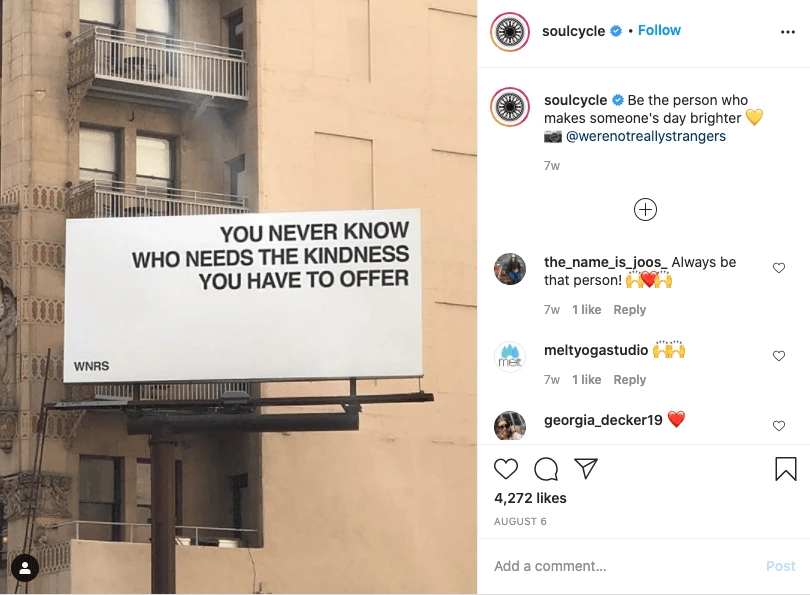
Source: SoulCycle
Sometimes less is more — and when it comes to Instagram, think first and foremost about fostering brand loyalty. If people draw inspiration from your brand, they won’t forget you.
5. Brand achievements
Your brand story matters to your customers, and so does your success.
When you share your brand’s achievements, you build trust and reinforce loyalty, which often leads to sales, support or donations. Reputation plays a big role when it comes to spending decisions, and your achievements prove that you’re a successful organization.
World Wildlife Fund often highlights its accomplishments on Instagram, showing its patrons and followers that their financial support is being put to good use. Content like this does double duty: It gives followers’ feeds a boost with good-news stories and it promotes the brand’s work.

Source: World Wildlife Fund
Achievement comes in many forms — brand development, product launches, customer growth, charitable initiatives — so keep your eyes open for opportunities to tell your story on Instagram. You might be surprised by how creatively you can visually represent your brand’s success.
Watch for ways to build trust and reinforce loyalty with your followers. Sharing your brand’s success will improve your reputation and impress potential customers.
6. Limited-time offers
As social creatures, it’s human nature to hate missing something important. Marketers should use FOMO (fear of missing out) to their advantage. One example is a limited-time sale, coupon or discount.
Take a look at Nékter. This franchise knows how to use sales to grab attention and encourage repeat purchases. How do they do it? Descriptive captions, a clear offer and bright, detailed photography all work together to deliver a compelling offer.
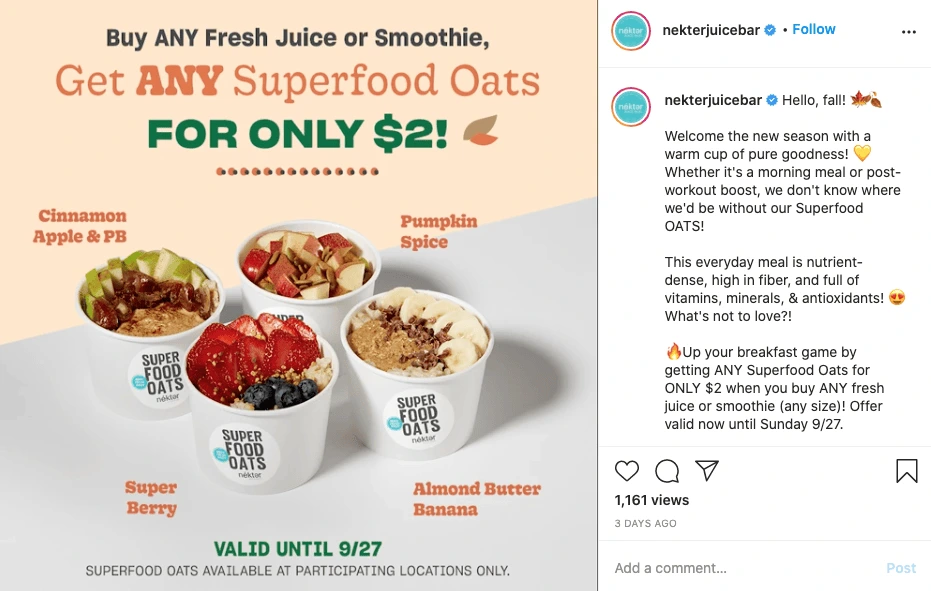
Source: Nékter Juice Bar
Nothing delays action more than uncertainty. Run your sales for a short period of time to give your followers a clear understanding of when and how they should act. If you run sales all the time, your audience will adjust and expect discounts continuously. Instead, make them feel like they’re getting a real deal by purchasing now.
Use compelling visuals to announce your offer, then provide followers with a clear deadline to increase urgency.
Key takeaway
Over the past few years, Instagram has evolved into a powerful marketing platform that gives brands new opportunities to boost sales. Investing in the right kinds of Instagram post ideas is a strategic way to influence the buying process.
Social media typically ranks among the top three sources of website referrals for most brands. And it’s affordable. Regardless of whether you have a budget of $0, $1,000 or $100,000, you can achieve your social media marketing goals with smart content and targeting.
Related: 7 serious social media mistakes that brands still make
The beauty of social media marketing is its umbrella of benefits. Its ROI isn’t restricted to the website conversions you see from social media referrals. It extends beyond that to include expanded brand awareness, mindshare, and the delayed effect of your social media campaigns on future purchase decisions. To create campaigns that deliver those benefits, you need to consider certain critical elements.
Things to consider before your next social media campaign.
1. Goals and outcomes
What does your brand want to achieve with social media? Defining this is necessary to set a sufficient budget, choose the right social media platforms, and create the right content.
Most businesses will track several different metrics from the table below to measure the success of their social media marketing strategy. While awareness and engagement metrics may be seen as “vanity metrics”, they can be a great way to gauge whether your content is resonating and will help drive conversions long-term.
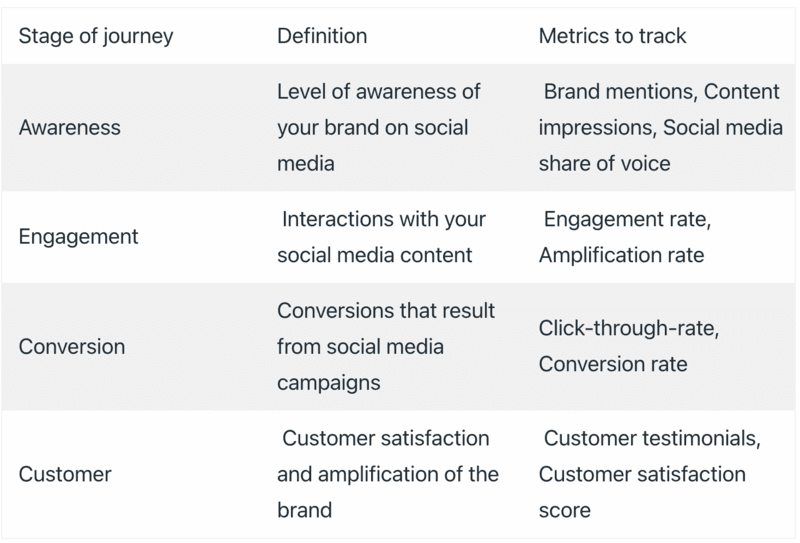
Once you have your goals, it’s important to focus on discovering what your customers’ goals are, so you can “figure out how your social media strategy connects both,” as Lee Odden, CEO of TopRank recommends. If you want people to pay attention to your content, the narrative should focus on them and not you—what value can you add to their lives? Which of their problems can you solve? To create such a narrative, you need clarity on your goals and your customers.
For instance, consider stem cell corporation LifeCell. Their goal was brand awareness among expectant mothers whose primary goal would be the safety and happiness of their children. So, they created posts that focused on the precious moments mothers share with their infants, like this one.
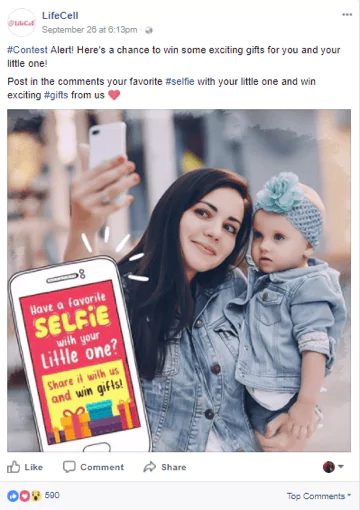
Target audience: Who is the ideal audience for this campaign? Most social media platforms provide options to filter your audience. Not all campaigns are designed to speak to your current customers—in fact, a good social media campaign should grow your audience and attract new followers. Think about the demographics and interests of your ideal audience, and target them accordingly.
Message: What is the main idea you’re trying to communicate with this campaign? Make sure your message is clear and focused. After all, attention spans are short on social media, so you’ve only got a few seconds to get your point across. Also, a word to the wise: Keep track of trending topics before delivering your message. A post that seemed like a great idea yesterday could be misinterpreted based on the news today.
2. Platforms and social networks
It’s never a good idea to spread yourself too thin by managing too many social media platforms. Especially if you’re a small business with limited budget and capacity, you’re better off choosing one primary social platform, so you can publish tailored content and fully participate in the responses you receive.
Facebook is a safe bet for most brands, since it’s become so ubiquitous. But for certain industries, such as fashion or food, image-sharing platforms like Instagram might provide a better rate of return.
Similarly, LinkedIn often works very well for B2B brands because it’s geared towards professionals. Research and choose a couple social media platforms that will best benefit your brand before starting a campaign.
To identify the best social media platform for your brand, you could simply survey your customer base or analyze your competitor’s social media presence. Choose the platform where most of your customers are active and where your competitors are receiving the best response. Alternatively, you could cross-post your social content to effortlessly create a multi-platform presence. Doing this manually is time-consuming, but an automation tool can simplify the process.
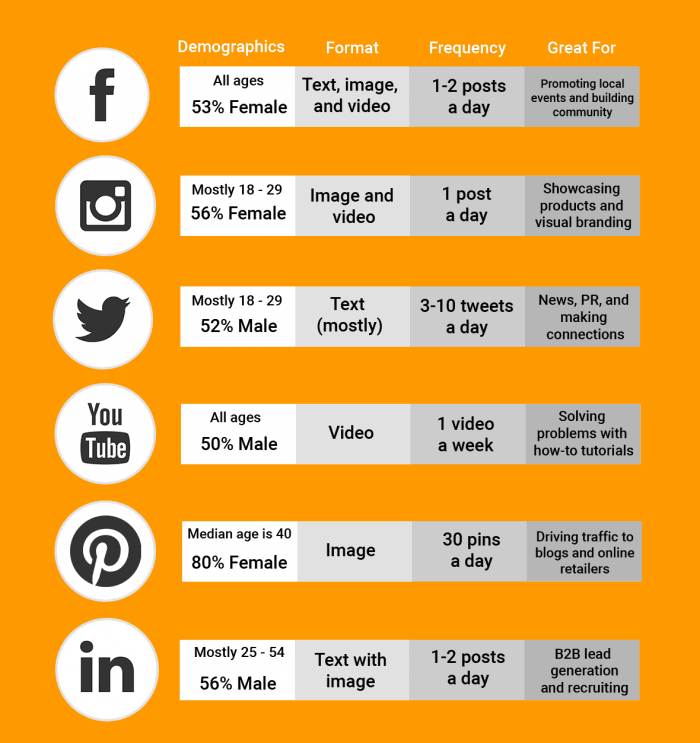
Source: Reaction.ca
3. Campaign timelines
Every social media campaign needs a definite timeline: a start date, an end date, and a publishing schedule. Without this, you won’t be able to connect your campaign to definitive results. Also, a timeline adds urgency and scarcity to whatever you offer during the campaign.
When creating a social media timeline, think about working in stages. Each stage can have its own content direction and outcomes. All of your plans can be documented on a campaign calendar. You can be more efficient by scheduling posts in advance, so you can review your content on a queued-up calendar and make any last-minute changes when needed.
4. Social media automation tools
Like a brand, running a consistent campaign is no joke. If you have time-sensitive plans, think about using a third-party tool for your publishing. There could be other features that matter to you, so it’s important to conduct some research before you decide to invest.
One example is DrumUp, a “set it and forget it” tool that can help with social media campaign management. If you decide to it, you can bulk-upload your social media posts from spreadsheets to libraries within the tool. Then, you can either custom-schedule your posts or queue up an automatic posting schedule. You can review upcoming posts in a calendar format and edit them any time before they’re published. Visit this post for a full list of social media automation tools.
5. Graphic design
Next, it’s time to create the actual content. For a coordinated campaign, you probably want to keep in mind the big picture when creating individual posts. You could begin by clarifying your core message. Once you have, you can create a “bucket of ideas” to work with for individual posts.
Keep in mind your ideal customer’s journey—how they move from awareness to conversion. You can then decide which format to create your posts in. Visuals work wonders when it comes to social media, where attention is sparse and distraction is plenty. If you aren’t sure what type of content you want to use, you could simply ask your audience, like IBM did.
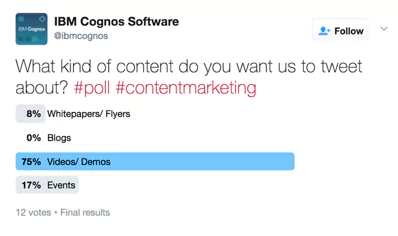
Worried about what your content will look like on different platforms? Use social media templates to make sure your graphics are on-point. Lucidpress has a whole gallery of social media templates sized to perfectly fit the platform of your choice, from Facebook and Twitter to Pinterest and Instagram. Upload your images and brand assets to your library, then edit the content with your brand colors and fonts. Creating social media graphics in Lucidpress is quick and easy, so you can have a full campaign designed in minutes.
Read more about designing social media graphics in Lucidpress here.
6. KPIs & tracking
Unless you continuously track the response to your content, you won’t have any points of reference to refine your social media marketing strategy. As people interact with your content, you can extract useful data based on their engagement. This data can prove useful in instances that aren’t related to social media marketing, such as product development and marketing on other channels.
Additionally, set KPIs alongside your goals, so you can measure your progress and assess the effectiveness of your efforts. Most social media platforms offer deep analytics, and there are third-party tools you can use to mine data. One of the tools I find useful is SimplyMeasured, because it offers several insights (in report format) for free. If you can’t log in to the tool on a regular basis, you could instruct the tool to send automated reports via email.
7. Social media management responsibility
Whether you’re a small brand with limited resources or a big brand with a large team, it pays to plan responsibilities in advance. Who will manage your social media campaign? Who will create the content, track the response, and interact with followers?
Some companies misjudge the amount of work involved in social media management. Content creation, community management, and analytics are demanding tasks that need people who can hustle, people who can stay on-point throughout the duration of the campaign. If you intend to outsource the work to an agency, you still need to track its progress. I recommend using Trello or Asana, so you can manage the review and approval process without having to waste time on calls and meetings.
8. Post schedule and cadence
The timing of your post matters a lot. It’s one of the most important factors in a particular post’s potential for engagement. To reach the highest number of people, content must be shared strategically to catch them while they’re online.
The peak times for various social media platforms are different. Conduct research to figure out the best times to post. There are tools like Facebook Insights and Followerwonk that can help you determine the right times to post.
9. Recycled content
You’ve likely noticed this: many popular pages will share the same content multiple times, continuing to earn engagement each time. Most followers will engage with the content without ever knowing that it was reposted.
It’s almost a given that your post will not reach your entire audience, so it’s not a bad idea to share the same content multiple times. However, do take time to review and make adjustments to the headline, description and image before sharing the content again.
10. Headlines and copy
People will read your headline before they decide whether to read the rest of your content. Your headline must be compelling enough to grab readers’ attention. It should contain a promise of value, information, or entertainment. Don’t forget, you’re competing with hundreds of posts from a variety of sources, so you’ve got to offer something exceptional.
Give yourself a leg up by testing your headlines. Don’t limit yourself to just one; instead, create multiple headlines and conduct A/B testing to see which one performs best. Then implement the winner across your campaign to boost your performance.
Not sure where to begin? Tools like Buzzsumo can help you research and discover high-performing social media posts.
11. Paid promotion
A little bit of advertising can go a long way. Most of the social media networks have a walled garden of advertising opportunities (as in they offer paid ad opportunities specific to that platform), which is great for anyone starting out with paid promotion. The key to ensuring a successful paid promotion initiative (and to refrain from wasting your budget) is to target specific audiences on specific platforms. So, place business ads for professionals on LinkedIn, or toss-up some self-serve ads on Instagram for Millennials. To dive a little deeper, we recommend checking out comprehensive article on social media advertising.
Ideas on developing your social media strategy
Want to kick butt and go viral on social media? Well you’ll need to establish a strategy. Here’s our recommendations as to how you can get started.
Research your competitors
Know thy enemy. Or something like it. Listen, you need to know who you’re up against (and why) — including what they’re doing well and what they’re totally dropping the ball on. So do some research. Create a shortlist, replete with similarities and differences. From there you’ll be able to plan how, where, when and why you’ll overthrow said competitor. Or you could just challenge them to a dance-off and see who wins.
Identify your content topics
Tempting as it might be to throw caution to the wind and just post whatever content comes to mind, we’d venture to say that you shouldn’t. Identifying content topics well ahead of time (and thus creating a content schedule) empowers you to use your time effectively and change gears should you discover that something’s not as effective as you’d like it to be. Plus, identifying content topics preemptively means you can bring more friends into the fold and ask for their assistance with visuals, copy and more. After all, no one likes being told “Hey I need your help but I’m not sure with what.”
Establish a visual identity and voice
Tragic as this might sound, recognition by association is what differentiates winners from losers. In other words, you want people to know who you are as it creates a winning environment. Therefore, by establishing a visual identity and voice, you create a foundation for recognition and success.
If you’ve been following Nest, you know they’re not your average home electronics company. Just check out the cool gadgets they make, and you’ll know what we mean, like:

Nest Learning Thermostat
Or this:
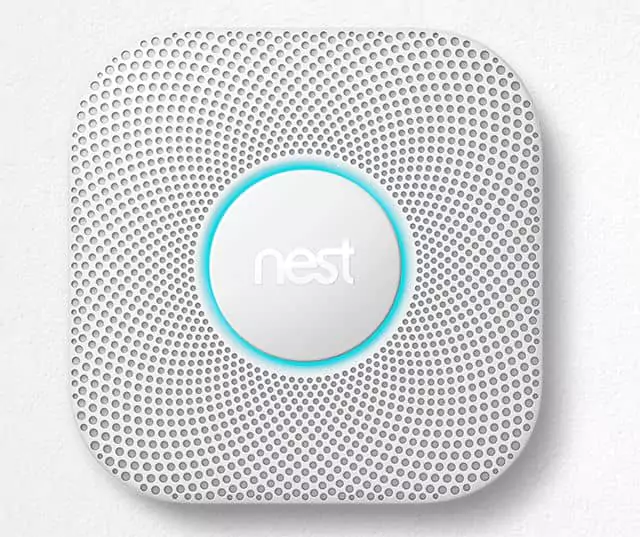
Nest Protect, a smoke & CO detector
But not only is Nest changing the home automation game, they’re also aces at marketing.
Recently, we had the chance to speak with the social media director at Nest to get the inside scoop on what makes for a successful social media marketing strategy.
Build a community
The first thing we learned is that Nest prioritizes community building. They do this by putting out a steady stream of social content that provides value for their customers. They’re also quick to retweet their customers’ content or respond to a comment by a customer who’s experiencing a problem.
Instead of thinking about what your business can gain from social media, think about what you can give. You could use social media to post helpful tips and friendly advice for your customers. This helps them get the most out of your product, and it builds the value of your brand. Here’s an example of this kind of post from Nest:
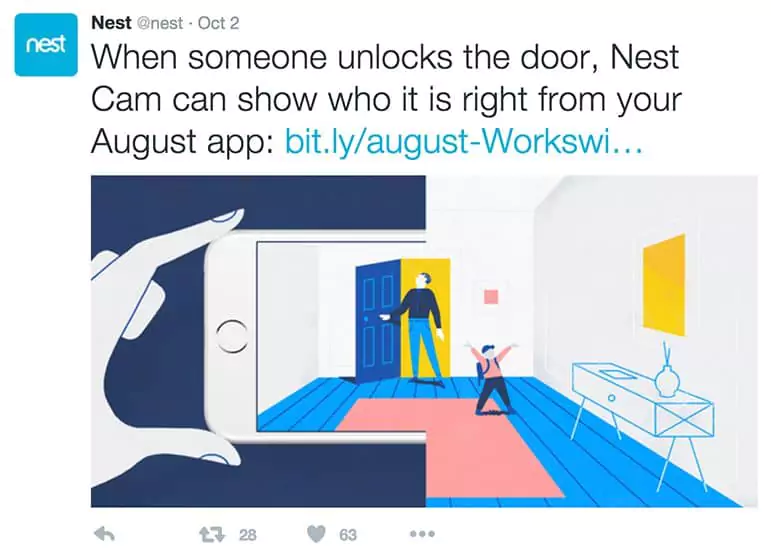
The more your approach to social media feels like a natural interaction between friends, the more success you’re likely to have. You want to build a community where customers share things they love with you, and you share things you love with your customers.
For example, Nest’s customers often mention them in tweets talking about how much they love using Nest’s products. Here’s one such tweet:
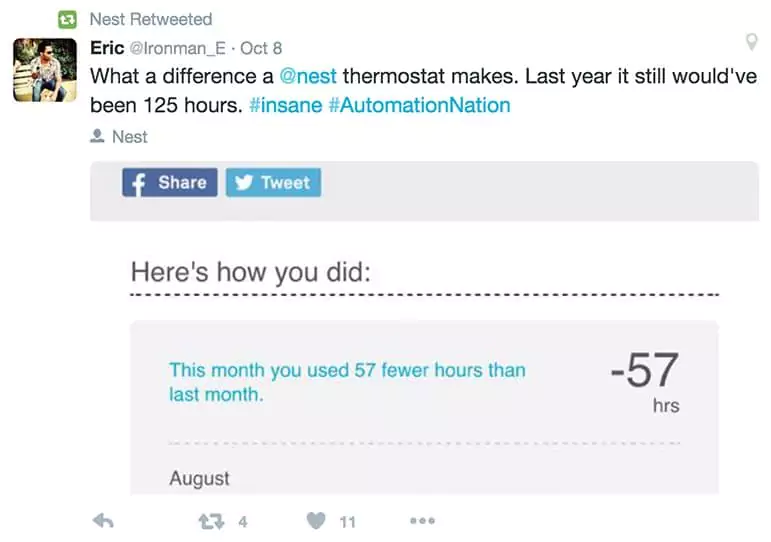
Happy customers give you free marketing and become your greatest assets.
Likewise, Nest is quick to share things they’re excited about, like this post that showcases a work of art a Nest user made to enhance their wall-mounted Nest thermostat:
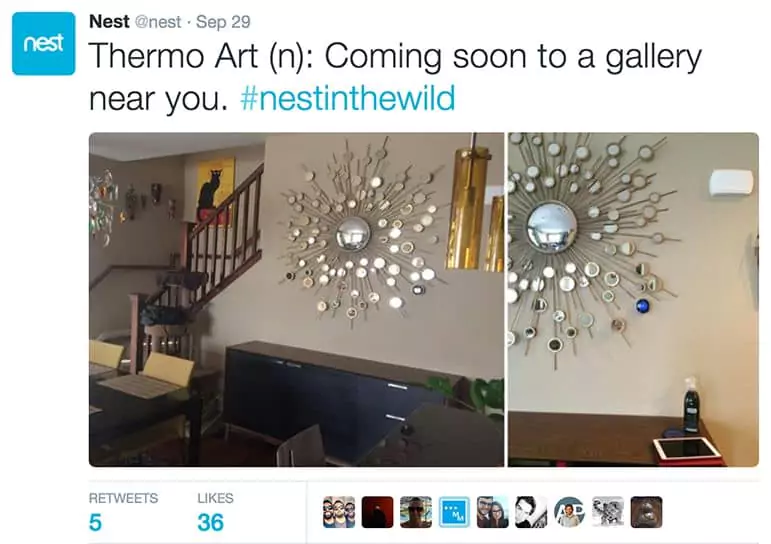
A marketer’s dream: customers seeing your product as a work of art.
This is the zone where you want to be with your social media efforts. But how can you get there? You need to start by becoming familiar with your customers. This leads us to the next lesson from Nest, which is…
Use customer insights to inform your social media strategy
This is a simple principle, but that doesn’t mean it comes easily. To be personal and relatable to its customers, Nest needs to know them really well, and they’ve clearly invested the time to do so. You can’t help someone see how your product will contribute to the things they care most about without knowing what those things are.
Your customers and community should be the main consideration in your social efforts.
Nest has mastered the strategy of observing how their community is interacting and engaging with their social channels, then producing content that speaks to those interests.
What does this look like in action? One of Nest’s principal products is a smoke & carbon monoxide detector called Nest Protect. They recognize that their customers care about safety, and in response to that, they promoted a campaign to nominate local fire departments for a grant.
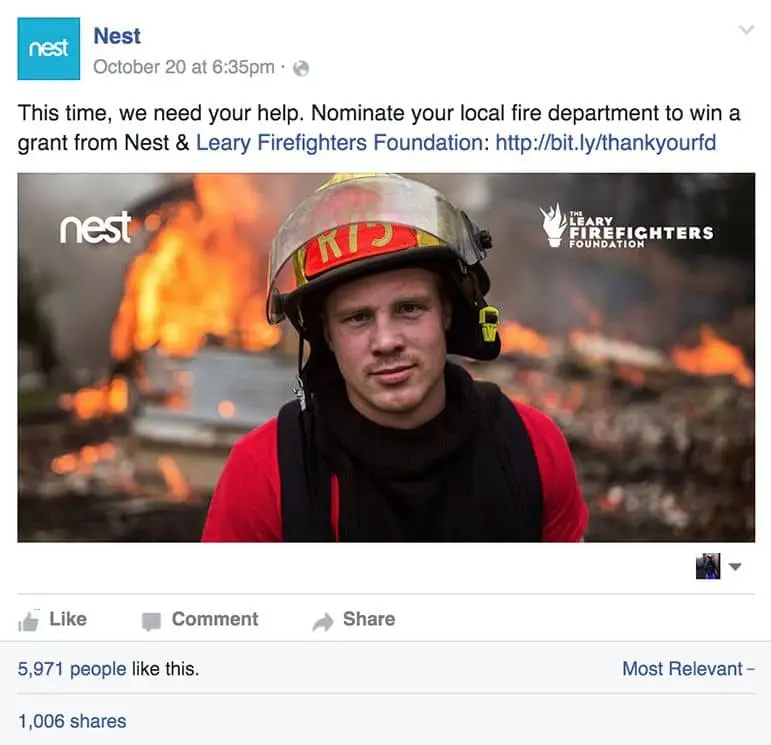
If you’re a local brand, consider looking for community causes you can get behind, then supporting them in a social campaign. It’s a great thing to do for your community, and it can help you gain some social media traction as well. Just make sure you’re sincere in whatever you do.
Additionally, all of Nest’s branding and content have a personal feel that gets to the core of what a good connection between the customer and company looks like. One of my favorite things that Nest does on social media is the Caught on Nest Cam video series, which consists of clips of funny or interesting moments captured by Nest Cams in the homes of actual customers. Here’s a good one:
With this social media effort and many others on Nest’s pages, they are using a technique perhaps best exemplified by one of my all-time favorite marketers: Apple. Though Apple is a huge company, they’ve managed to maintain a personal feel in their branding, and they often focus on the human element of their products.
Apple’s marketing shows their products integrating seamlessly into everyday life and enhancing the things that people care most about. Nest does the same thing by showing their products in people’s homes and providing the safety, peace of mind, and convenience that their customers crave. A recent ad by Nest did a great job of capturing the human element. It depicts a house as a speaking character talking about his experiences with the family.
Your business can do this, too. Think about the basic ideas behind why you started your business. What value does it add? How does it make people’s lives better? If you can answer these questions, then it’s just a matter of telling people about it.
If you own a sandwich shop and you think your food tastes the best and will make people happy, then post a photo of happy people eating at your shop, or your food bringing people together at a party. When you focus on your customers, your ideal strategy will become clear.
Customize the content for the platform
It’s not an easy task to customize your content for each social media platform, but if you’re serious about social media success, it’s a necessary investment. You should optimize the headlines, images, descriptions, and even your tone of voice to match the platform you’re posting on.
The same content that performs well on Facebook isn’t guaranteed to perform well on other networks. For instance, Twitter has a character limit. Instagram only supports certain image sizes. The tone you would use on LinkedIn is likely quite different from the one you’d use on Snapchat.
This is another good reason to limit how many social media platforms you choose. By focusing on the most important ones for your audience, you’ll have more time to craft content that feels native and authentic to the platform.
Embrace the visual
A recent study showed that visual content is 40% more likely to be shared than plain text content. And as you know, more shares lead to better reach and higher engagement.
Try to create attractive, eye-catching images not just for your brand’s profile but also for every single post. Try experimenting with different types of visual content such as infographics, memes, and so on.
In the case of image-sharing social media platforms such as Pinterest, Instagram and Snapchat, posts with poor visuals have no hope of attracting attention or engagement.
Ask questions
A great way to engage your followers is to ask questions relevant to them. Everyone wants to share their opinion, and the comment section is a good place for you to connect and interact with your fans. It helps your brand feel more human and build more personal connections.
There are plenty of creative ways to ask questions to your followers. Create a poll, a quiz, a would-you-rather, or a trivia question to stimulate conversation. Make sure someone is watching the discussion to keep it focused and productive—and to remove inappropriate comments if necessary.
Reach out to influencers
According to this study, an average return on investment for an influencer marketing campaign is $6.50 for every dollar spent. This speaks to the power of influencers and influencer marketing.
There are hundreds of influencers on social media platforms today, and each of them has curated a unique audience. Contrary to popular belief, you don’t have to find influencers with millions of followers to be effective. You’ll probably find that the best results come from partnering with influencers who share an audience similar to your own, so dig into your niche and make a shortlist.
Wrapping up
Finally, it’s important to consider roadblocks in advance. Social media is a constantly changing landscape, so be prepared to forecast and preempt potential disasters. Check whether the dates you’ve selected clash with any meaningful holidays, and consider whether your content has the potential to bump into sensitive issues. By considering this in advance, you can set yourself up for success.
Ready to make your own social media posts? These free social media templates are a great starting point.
When Instagram rolled out 24-hour Stories back in 2016, it became a sensation overnight. Almost eight years later, the feature is still going strong, and many marketing teams have made it a fun part of their social media strategy. But there’s an art to this seemingly simple feature – and simply posting and hoping for the best isn’t it. If you want to use Stories strategically, you’ll need to delve into your target audience and figure out your brand’s visual identity.
In this quick guide, we’ll walk you through how to use Instagram Stories strategically, with some great examples to give you a head start.
What are Instagram story filters?
Of Instagram’s more than 2 billion users, 500 million of them watch at least one Story per day. And while overall Story reach rate has declined over the past few years, they’re still an incredibly sticky feature, with a full half of Instagram users reporting that they’ve visited a brand’s website to check out or buy a product after seeing it on Stories.
By these stats alone, it’s abundantly clear just how powerful Instagram Stories are for brands large and small. But numbers aside, there are several strategic reasons to have a solid Instagram Stories plan in place, including:
- Instagram Stories humanize your brand: Unlike our highly curated feeds, Instagram Stories are meant to be ephemeral (they only last 24 hours), timely, and authentic. They’re the perfect medium to showcase the real people, stories, and values behind your brand.
- Stories are much harder to miss: While the IG algorithm used to show posts in your feed in the order they were posted, that’s no longer the case. That means that your shiny new posts might not actually be seen by some of your audience. But when you post a Story, your followers will see it above their feed, and might even get a notification about it.
- You can share links: One of the biggest complaints marketers have about Instagram is that you can’t share links in regular posts. Thankfully, if you have a business or creator account, you can share clickable links in your Stories, making it much easier for your followers to check out your website.
- More opportunities for engagement: Other than commenting or liking, there isn’t too much a person can do with a regular in-feed post. But with Stories, users can respond to polls, share direct messages, ask questions, and more.
Tips on how to use Instagram Stories
Want to make the most of your Instagram Stories strategy? Here are a few tried-and-true tips:
Create a consistent visual identity
If one of your followers randomly stumbled upon your Story without any context, would they know it was from your brand? If the answer is ‘no’, then it might be time to rethink how you’re approaching your brand’s visuals. Brand consistency is key to making your content recognizable, memorable, and most importantly, effective.
So what does this mean in practice? We’d recommend starting by using the same color palette, fonts, and imagery you use in other branded materials. For example, if your website uses a lot of plant and nature imagery, your Stories should as well.
Post often
Like with any social media strategy, it takes time to see the fruits of your efforts. Don’t get discouraged and quit cold-turkey if you don’t see a lot of results after just a few weeks or months. Posting great content on a consistent schedule is essential to building up a dedicated audience over time. Research shows that around 2 stories per day is the ideal, but feel free to experiment and see what works best for your brand.
Avoid too many frames
No one likes the person who spams posts on their IG feed, and the same goes for Stories. According to Rival IQ, the number of people who stick around to watch your Stories drops off below 75% after 7 frames.
Experiment with storytelling
Storytelling is one of the most powerful tools you can use as a brand. And when it comes to IG Stories, narrative-based content wins, with 35% of users preferring short narratives.
A few ideas here:
- Walking users through a how-to or tutorial
- Sharing your brand story
- Taking your audience on a ‘day-in-the-life’ of one of your employees
- Showcasing stories from your customers
Use CTAs
Just like with any other type of social media post, your Instagram Stories should point people in the direction you want them to go. A call-to-action, like a clickable link or interactive poll, incentivizes people to engage with your Story and account.
Some of our favorite Instagram Story examples
Outdoor product Instagram story template
Got a seasonal launch or sale coming up? This customizable Instagram Story template offers an eye-catching way to detail several different products at once.
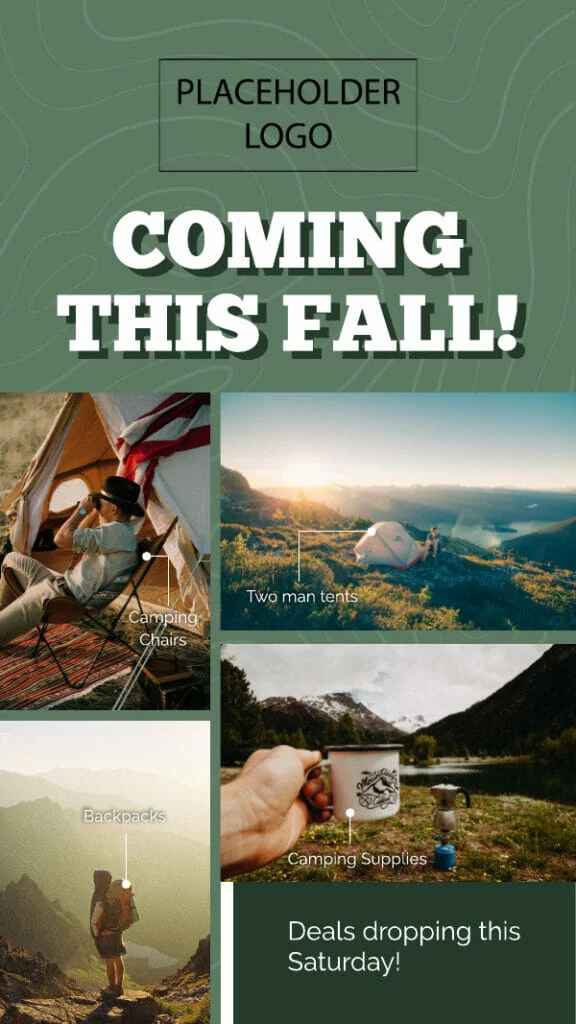
America’s Test Kitchen
If you want people to engage with your brand, ask them their opinion! This simple Instagram Story from America’s Test Kitchen is a great example of how to easily boost engagement, all while subtly driving people to your website for more.
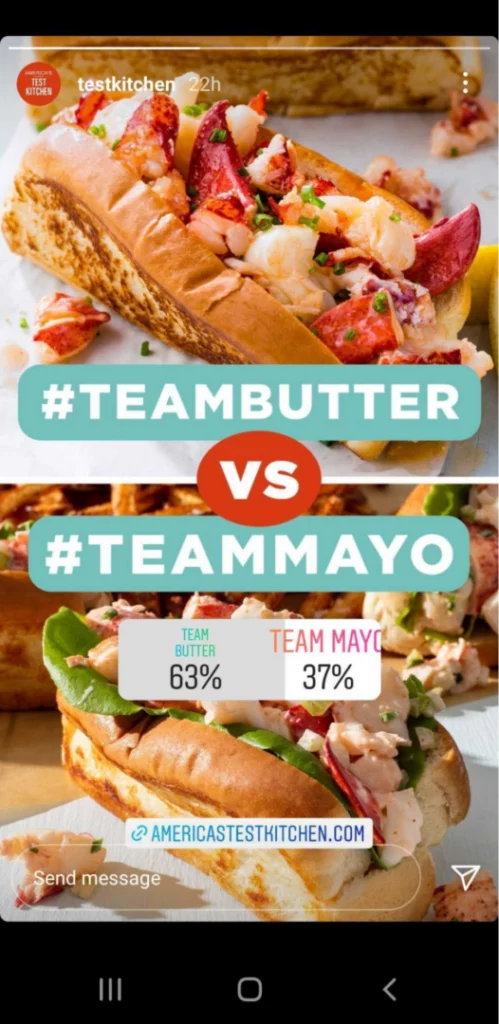
Work from home Instagram Story Template
Customizable bingo is another fun way to gamify your content and get people interacting with you. Choose an on-brand bingo theme and invite people to screenshot and tag you in their own Story. If someone gets bingo, repost it back to your Stories!
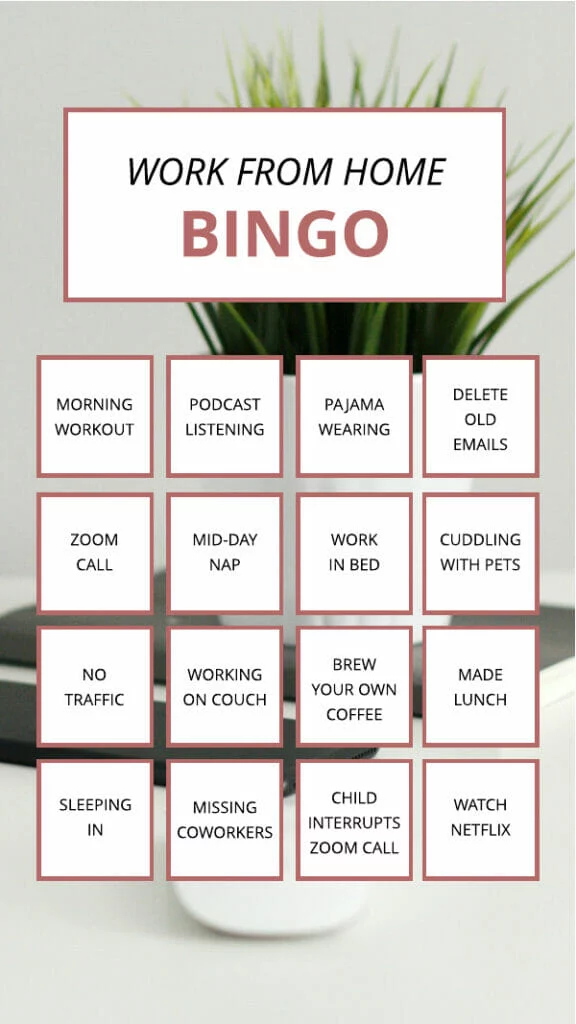
Nike
We love what Nike did here with their short-form video IG Story series. They sat down with some of their athletes for a short look into their career accomplishments – and didn’t mention any of Nike’s products. It’s a masterclass example of using compelling storytelling to your advantage. Not everything you post has to tie back to your product or service, but it should reinforce your brand and what it stands for.

With Instagram Stories, the possibilities are pretty much endless. Not sure where to start? Check out Marq’s free template library full of customizable Instagram Story templates and get creating!
Life comes at you fast, and social media trends are no exception. Time spent online has ballooned in the last year, with social media increasingly being used to satisfy needs from creating community to e-commerce. This social media trend has shifted power into platforms like Facebook and Instagram, where consumers now spend a huge chunk of their day.
So how do you grab the attention of that captive audience and harness it for your small business? Here are nine social media trends to boost engagement, attract followers and elevate your brand.
Grow brand influence with these 9 social media trends
Already know the lay of the land? Dig into creating branded social media content with our free social media templates.
1. Social selling is the future of e-commerce
Social selling, or the integration of e-commerce into social media platforms, is thriving. Product tags and shoppable posts are making it easier than ever for small businesses to not only connect with customers but convert them.
These seamless social media shopping experiences reduce friction in the customer journey by offering options to purchase products without leaving the platform. With online retail up nearly 30% in both the UK and the US, social selling has the potential to transform online sales.
2. Harness the power of micro-influencers
One long-standing social media trend is influencers. These powerful brand ambassadors have the ability to make or break a product launch and can be a better investment than advertising to get more visibility for your brand.
If your budget isn’t likely to support a shout-out from a Kardashian, never fear. Micro-influencers are effective in niche markets and far more affordable. These influencers have smaller spheres of influence but up to seven times more engagement with followers than larger accounts.
3. Focus on video content
From Instagram Reels to TikTok, the dominance of video content is here to stay. A study from Cisco indicates by next year, 82% of global internet traffic will come from video streaming and downloads. Whether it’s user-generated shorts or long-form YouTube, video content is king for generating engagement.
Social media trends like video don’t have to be a big investment. You can start small by livestreaming or doing quick tutorials. Many brands also get extra mileage by editing and recycling clips to create fresh video content.
4. Pay attention to private social media communities
Engaging your customers in the comments is an excellent first step, but there are benefits to social trends like connecting with private groups on social media. These collections of users with shared interests can blossom into robust communities that support your business goals.
For instance, Facebook groups for wandering nomads are a powerful place to get feedback on travel services or amplify products like luggage. On Instagram, you’ll find like-minded communities gather in shared hashtags such as #Eeeeeats or #GirlsWhoTravel.
5. Get real with social listening
Increasingly, social media audiences are less interested in what you’re promoting and more invested in having meaningful conversations. Once you frame social media channels as a way to connect with customers and build community, sales inevitably follow.
Fortunately, the key to nourishing social media conversations is straightforward. Listen. Find opportunities for your followers to give feedback and ask questions. Create an authentic social media presence by committing to transparency, owning up to mistakes and apologizing. Having those hard conversations in the public eye shows your brand cares.
6. Try livestreaming
If you associate livestreaming with gaming, you’ve got some catching up to do. Livestreaming dominates social media as a way to connect with followers in real-time and gain a wider audience. Going live on Facebook or Instagram was once a novelty but is now the norm for both casual users and businesses.
Because much of our daily lives have shifted online, livestreaming is a way to hold events virtually, from pet adoptions to open houses. Streaming gives your audience a behind-the-scenes peek into your work and helps them feel more invested in what you do and who you are.
7. Combat the rise of disinformation
Social media isn’t all roses, and the rise of disinformation on many platforms has proven it. The good news is brands can become part of the solution. Taking responsibility to correct misinformation within your industry earns you karma points and loyal followers who will amplify your stuff.
However, proceeding with caution when promoting social media trends like this is paramount. Even small missteps can generate embarrassing attention online, so double-check your facts before posting.
8. Invest in socially conscious content
As brands have discovered recently, the line between personal choices, politics and public policy can become blurred. Using your social media channels to amplify socially responsible messaging communicates the kind of support for the community that can be a brand booster.
According to 5W Public Relation’s 2020 Consumer Culture Report, 83% of millennials and younger consumers want to support companies that align with their values. Given that forecast, social media trends like social action campaigns are here to stay.
9. Get more out of your metrics
Much to the frustration of social media marketers, metrics used to boil down to conversion. That focus is shifting as more brands recognize the power of social media translates to more than sales. Measures of success are widening to include not just how followers engage but also the reach of social media content.
Here are few metrics to consider for your social media marketing plan:
- Brand awareness (post reach, mentions and impressions)
- Engagement (amplification rate, applause factors)
- Customer satisfaction (testimonials, review scores)
Social media platforms like Instagram and Facebook still offer metrics on conversion like click-through rate (CTR) and cost-per-click (CPC). But some of the newest metrics seek to capture customers whose interest lands higher up in the sales funnel.
Staying on top of social media trends helps your business adapt and thrive online, but it’s also important to cover the basics of a well-branded social media presence. Lucidpress can help. Get started and try our free social media templates.
There’s no denying it – Facebook isn’t the powerhouse of a social media platform it used to be back in the aughts. But while organic reach has declined over the years, don’t discount how valuable Facebook can be as a part of your social media marketing strategy.
As of 2023, Facebook has over 3.03 billion monthly active users. That means if you want to get eyes on your brand, Facebook is definitely a place to build a consistent presence.
Want some tips on building brand affinity on Facebook in 2023 and beyond? Keep reading!
How to build brand affinity on Facebook
1. Create captivating, on-brand creative
With so much competition already on Facebook, you want to be publishing content that not only catches peoples’ eye, but content that is clearly consistent with how your brand looks elsewhere. Using unique imagery and bright colors can be a good start, but only if that fits with the brand you’ve already curated.
For example, if you publish 20 Facebook ads that all use different styles and colors, no one is going to be able to recognize your brand.
Instead, stick to your brand colors whenever possible and always include your logo in the ad. You should also use the same principal font that’s on your site, and never use more than two fonts in one ad.
Here’s a great example of what to do vs. what not to do:
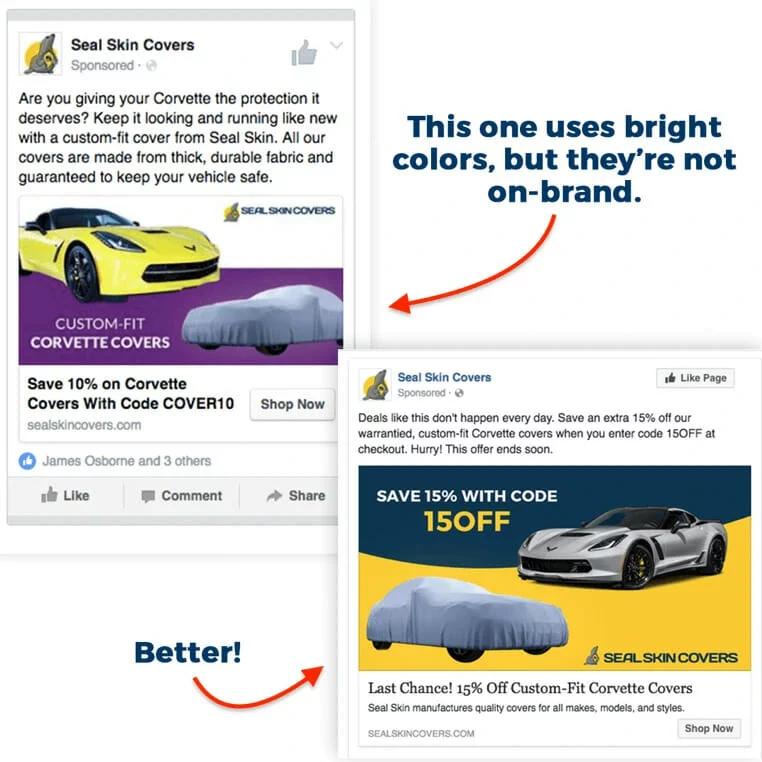
2. Use targeting filters and “Lookalike audiences” to find new fans
While remarketing campaigns are like shooting a fish in a barrel, finding new consumers who will have a genuine interest in your brand is a far more challenging task. Luckily, Facebook has a variety of unique targeting features that can help you refine your audience. Think about the demographics, behaviors and interests of your ideal customer and use that information to narrow your selection. For example, if you own a bridal shop and want to increase your wedding dress sales, you could target people who recently became engaged.
Facebook also has a unique feature called Lookalike Audiences. Think of it like a matchmaking service for brands looking to grow their audiences. To use this tool, you’ll want to create or import a custom audience that fits your ideal consumer.
Then, Facebook will work its magic and identify new customers who are likely to be interested in your brand based on that custom audience. This can be an incredibly valuable tool, and can help you save on ad spend and spend less time searching for quality leads.
3. Establish a brand voice—and stick with it
One of the most important elements of building brand affinity (no matter what platform you’re using) is sticking to your brand voice. For example, if you own a mortgage firm and your brand voice is authoritative and professorial, then you don’t want to run ads that are filled with over-the-top puns and jokes.
We recommend being consistent with your terminology as well. If your e-commerce company refers to buy-one-get-one-free sales as “BOGO,” this should be a consistent term in all your ads.
The more people you have working on copy for your Facebook ads, the trickier it can be to establish a consistent brand voice. Creating a brand style guide with rules on tone, voice, and POV can help.
4. Advertise free content, too
Everyone likes free stuff – especially if they might not be ready to fully commit yet. Instead of focusing exclusively on selling, get creative with free content, whether that’s free information (whitepapers, newsletters, ebooks, etc), or free products.
Athleisure brand Girlfriend Collective used this tactic to their advantage when they first launched. To drum up word-of-mouth and interest in their sustainably-made leggings, they offered their audience free leggings for a limited time. The result? They received over 10,000 orders on the first day of this freebie campaign. Not too shabby, eh?

5. Follow the right image sizing guidelines
Visuals are everything, and in the world of social media, they’re often the first things your audience notices. As such, you want to make sure your images are the right dimensions.
Here’s a handy guide to Facebook image sizing.
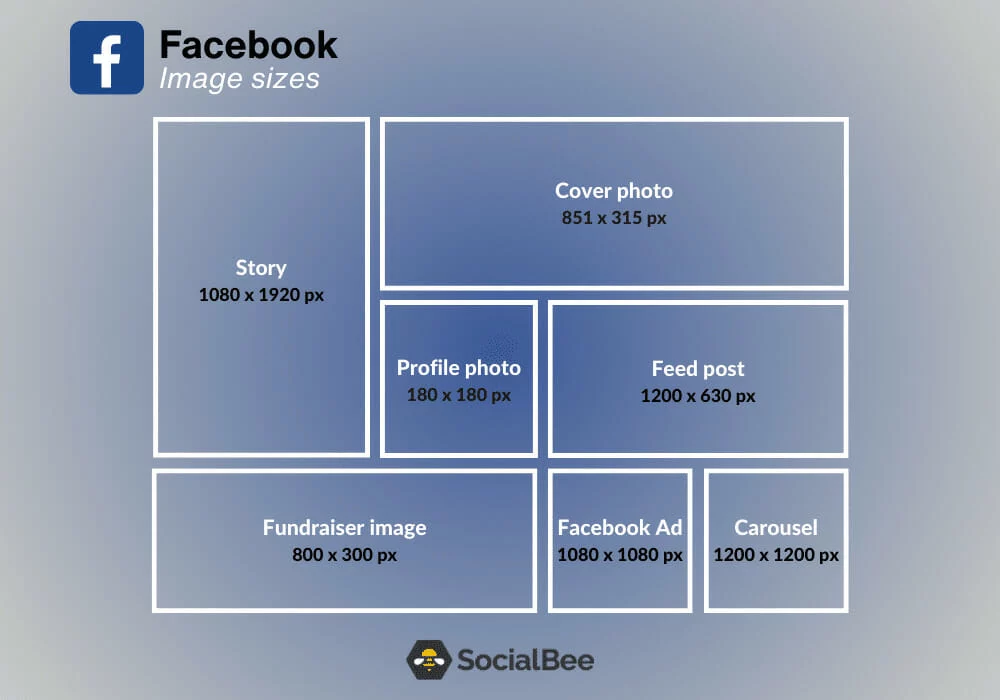
When it comes to your profile page in particular, making sure your imagery is visible both on desktop and mobile devices is crucial. While the ideal Facebook cover photo size is 820 pixels wide by 360 pixels tall, if you use an image that size, the edges will be cropped on mobile (and the top and bottom will be cropped on a computer). To avoid losing important elements of your cover photo, keep the most important details 90 pixels from the right and left sides and 12 pixels from the top and bottom edges – like this:

Want to streamline your Facebook marketing process? Check out our free library of customizable Facebook ad, cover photo, and post templates and get publishing today!
Each month, over two billion users log in to their YouTube accounts. Needless to say, the site sees a pretty unbelievable amount of traffic — it’s probably why you created a YouTube channel in the first place.
There’s also an unbelievable amount of content on YouTube. (Over 500 hours of video are uploaded to YouTube every minute — that’s 720,000 hours of new content every single day.) Your channel — and any channel, for that matter — is just a tiny drop in an enormous river of content. So how can you make your videos stand out?
Making content is only the first step towards a successful YouTube channel. To reach your audience, you also have to promote your YouTube channel. And there’s no “right” way to do this. In this post, we’ll break down various strategies you can use to promote your YouTube channel and start racking up the views.
Understanding the YouTube algorithm
Like Google (or Bing), YouTube is a search engine, which means that the best way to promote your YouTube channel is by optimizing your content to rank well in YouTube searches. It’s a pretty simple concept: The higher your videos are ranked in searches, the more likely they will be watched.
So how does YouTube’s algorithm rank content?
First, let’s see what YouTube has to say about it: “Videos are ranked based on a variety of factors including how well the title, description, and video content match the viewer’s query. Beyond that, we look at which videos have driven the most engagement for a query.”
While the description is a little vague, it gives us a list of places to include keywords: the title, description, and content (closed captions are important!). Once you’ve loaded up on keywords, you’ll want to turn your attention to engagement. YouTube wants users to stay on their platform for as long as possible — your videos can help make this happen.
Not sure where to go from here? Don’t worry — we explain how to find YouTube keywords, increase engagement, and further promote your YouTube channel in the following section.
List of ways to promote your channel
Remember: There’s no “right” way to promote your YouTube channel. And there’s also no fix-all — you’ll have the best results using a number of the strategies listed below. The good news is that most of the following ways to promote your YouTube channel are completely free!
Identify and include high-volume keywords
Finding YouTube keywords can be tricky (and unreliable) — the results are often just pulled from Google keyword tools. If you’re interested in doing a deep dive, Ahrefs has a great guide on YouTube SEO.
Before diving into YouTube keyword research, we’d recommend starting with Google keywords. For many Google searches, the top results are videos — these could be your videos! As you create your content, do some Google keyword research and include those keywords in your video title and description. You may also want to plug those keywords into Google quickly: What types of videos are showing up? How long are they? You’ll want to pattern your content after the videos that are ranking well. (We’re not calling for plagiarism, of course. Your content should be original.)
Make your own thumbnails
Before clicking on your video, a YouTube user sees two things: the title and thumbnail. YouTube allows you to create your own thumbnails for your videos — as in you have control of the viewer’s first impression! YouTube suggests using thumbnail images that catch the viewer’s eye, aren’t misleading, and show the viewer what your video is about. It’s a tall order, but they offer loads of great tips.
Use metadata
YouTube allows you to add “Tags” — searchable keywords that don’t show up in your description or title — to your videos. Make sure to include a few for each video you publish. Don’t go overboard: You want the tags to be accurate and relevant to your content.
Interact with your audience
One of the easiest ways to drive engagement with your YouTube videos and channel is replying to comments (good and bad). Interacting with viewers gives a chance to show your channel’s personality, so have fun with it!
Create playlists
Remember how we said YouTube wants viewers to stay on the site? By creating playlists of your related videos and linking them at the end of each video, you can help drive viewer engagement and rack up more views!
Promote on other social media platforms
Your company’s online presence likely extends beyond YouTube — so make use of those other social media platforms! Whether it’s on Facebook, Instagram, or your blog, link to your YouTube channel and embed videos to drive traffic towards your channel.
Invest in YouTube ads
If you have room in your budget, YouTube ads are one of the best ways to promote your content. You can target specific demographics with your ads to try and reach the ideal persona with your content.
As you implement these strategies, remember that promoting your YouTube channel is a process — you don’t have to do everything right away! Start by focusing on keywords or cross-promoting, and build from there. The longer you stick with it, the more results you’ll see.
There’s not much point in promoting your YouTube channel if it looks unprofessional. Potential viewers are ruthless — they might take one look at your page and leave! Ensure your YouTube channel makes a good first impression with Lucidpress YouTube channel art templates.
Instagram is one of the fastest-growing social media platforms, with over one billion monthly users spending up to an hour a day perusing the app’s vibrant, visual content. Home to the influencer and brand ambassador, Instagram allows powerful companies and small businesses alike to level the playing field and connect with prospective customers.
Instagram says 90% of its users follow at least one business account, and two in three Instagram users confirm the app drives their interactions with brands. While you might not be Nike with 133 million followers, Instagram can still be a lucrative space for small businesses to leverage.
Why small businesses should use Instagram for business
Instagram business usage has exploded in the last few years among brands that realize the platform’s potential to reach younger audiences. With dynamic video and lifestyle content, Instagram is an ideal space for marketing campaigns, product launches and brand building.
Because this social media community has a mobile-first approach, it can seem intimidating to small businesses. But if you’ve been lukewarm about launching a business account, now is the time to establish your Instagram presence and take advantage of the exposure this popular platform provides.
How to set up your Instagram business account
If you’ve been tinkering with a semi-official personal account, take the plunge and switch your profile to a business account. If you don’t have an Instagram presence yet, create a personal account first, then switch it over to a business profile.
Confused about how to get started? Pop over to Instagram for Business and get the official Guide to Getting Started for detailed instructions and more information.
Instagram doesn’t allow much to be packed into your profile, so make sure your bio is succinct with contact information such as your company’s website. Think carefully about including branding elements in your profile pic to make your business stand out in a sea of selfies and carefully staged photos.
Learn more about types of Instagram content
Once you’ve got a profile established, it’s time to populate it with content. Just remember that not all eye candy is created equal. The kind of content you choose to invest in may differ depending on your business goals. Here are the basic types of content available on Instagram.
Instagram Posts
Because Instagram is a visually driven platform, every post begins with a photo or video. While you’ll have plenty of space to caption the image and include details, the picture is the focal point of every good Instagram post.
But fantastic photography isn’t going to distinguish your business profile from all the visual noise on Instagram. Instead, engage your audience through diversifying your Instagram posts and content. Need some inspiration? Lucidpress has some Instagram post ideas proven to boost sales.
Instagram Stories
This Instagram feature splices together video and photos into a story that expires in 24 hours. Creator-generated filters for Instagram stories use AR and other effects to layer over your content for a signature Instagram experience.
New to Instagram stories and need a little hand-holding until you get the hang of it? Lucidpress has Instagram story templates to get you started.
Instagram Reels
For users who dig TikTok, Instagram Reels provides a similar approach with short videos you can share. Overlaid with filters, music and other effects, Reels is a handy way for brands and small businesses to showcase products and share behind-the-scenes footage.
IGTV
You guessed it. IGTV stands for Instagram TV. It’s a channel dedicated to promoting longer videos of up to 10 minutes. Bonus points if you’ve got a verified account because you’ll get the perk of posting 60-minute videos. Businesses use IGTV for tutorials, Q&A sessions, and customer success stories.
Instagram Shops
While all of this brand-building content is a plus, you need a way to monetize and convert traffic from your business social media accounts. That’s where Instagram Shops comes in with a shopping experience that works seamlessly with Instagram and helps convert followers into customers.
Use these Instagram engagement strategies to boost your business profile
Boost your Instagram engagement, grow your following and expand the reach of your content with the following strategies.
Leverage hashtags
The best way to make a splash on Instagram is to ride the wave of trending topics. Instagram’s search feature is driven by hashtags, so tagging all your content with relevant hashtags is an easy way to increase reach.
While you can use up to 30 hashtags per post, more isn’t always better. On Instagram, you’ll get more traction from hashtags that are trending. Avoid randomly throwing in trendy topics that don’t apply to your content, though, or you’ll risk seeming spammy.
Sponsor contests and giveaways
Who doesn’t love free stuff? Instagram is a great place to promote giveaways that’ll garner attention and shares. And while you should take engagement on these tantalizing promotions with a grain of salt, it’s still an excellent opportunity to find new followers and recruit lifelong customers.
The most successful giveaways and contests on Instagram have a few things in common. First, they run for a short period of time and provide exclusive products or content for those who participate. Secondly, using branded visual elements and customized hashtags boosts shares and organically expands the reach of your promotion.
Encourage collaborations
Influencers and brand ambassadors with large followings make a legitimate living on Instagram by amplifying products and campaigns they care about. You can leverage that influence for your small business, but successful collaborations come with some caveats.
It’s vital to do research and connect with an influencer who has some “social proof” or credibility in your industry. While a Hollywood celebrity account reaches millions, those fans may not be the best market for your product or brand. You also don’t have to spend a hefty chunk of change to make successful collaborations or sponsor a post. There are plenty of influencers who have fewer followers but work with niche audiences that could be a great fit for your Instagram business.
Create valuable content
Whether you use Instagram for business or personal reasons, there’s a simple rule to gaining followers. Create high-quality content that people care about. Instagram has a strong level of user engagement, so figure out what your audience wants and deliver it consistently. From how-to videos to deep-dive infographics, don’t hesitate to explore the passion behind your product or brand.
Another way to make sure your business is creating valuable content is to ask yourself if what you’re sharing on Instagram builds community. While some accounts might chase clout, ultimately the brands that have high levels of engagement are those that have built trust with followers.
Write compelling captions
Instagram is visually-driven, but captions are your last and best chance to communicate with your customers. Write compelling captions with these simple rules.
- Start with a good hook. Instagram makes you click to read past the first 125 characters, so make sure people want to read on.
- Place keywords at the beginning to capture attention.
- Get expressive with emojis.
- Sneak in trending hashtags at the end.
- Don’t forget a CTA or a question to boost engagement.
Maintain visual and voice consistency
Before rolling out the red carpet on your brand new Instagram presence, think carefully about your brand voice and values. How can you communicate what you care about through the visuals on your Instagram business profile?
Whether you’ve decided to keep it consistent with a certain color palette or using humor and wordplay to show off your products, you can keep your Instagram vibe consistent with Lucidpress Instagram post templates.
Measure results
Using Instagram for business puts a wealth of data at your fingertips to measure engagement on your posts and tweak campaigns to produce better results. The reporting tools aggregate data into a single dashboard, so you can glean insights at a glance. You’ll see overall stats for your business profile, and you’ll also be able to drill into post engagement to find the best performing hashtags and content. Learn more about how to use Instagram insights for your business over at Facebook’s Business Center.
How to use Instagram ads
Advertising on Instagram is relatively cost-effective and accessible for small businesses. If you already have a Facebook advertising account for your business, Instagram for business will look familiar since it runs on the same platform. In some cases, you can cross-promote campaigns or content across both Facebook and Instagram.
Before you dial in the details of your Instagram ad campaign, make sure you’ve articulated your goals. Whether it’s to increase followers or convert customers, your objectives will determine factors like ad placement, targeted audience, budget, schedule and the ad format. You can learn more about how to create effective Instagram ad campaigns at the Instagram for Business center.
Designing a dynamic Instagram presence for your small business won’t happen overnight, but if you commit to creating high-quality content, you’ll convert casual followers into lifelong customers for your small business.
Get started elevating your Instagram profile with Lucidpress’s Instagram templates.
Creating banners for social media and display campaigns can be a daunting undertaking, especially if you don’t have a creative team to help out. As a small business owner, this task may fall to you. Here are 15 banner design ideas to check out and help you get started.
Banner ad ideas
Business medium rectangle banner (300 x 250)
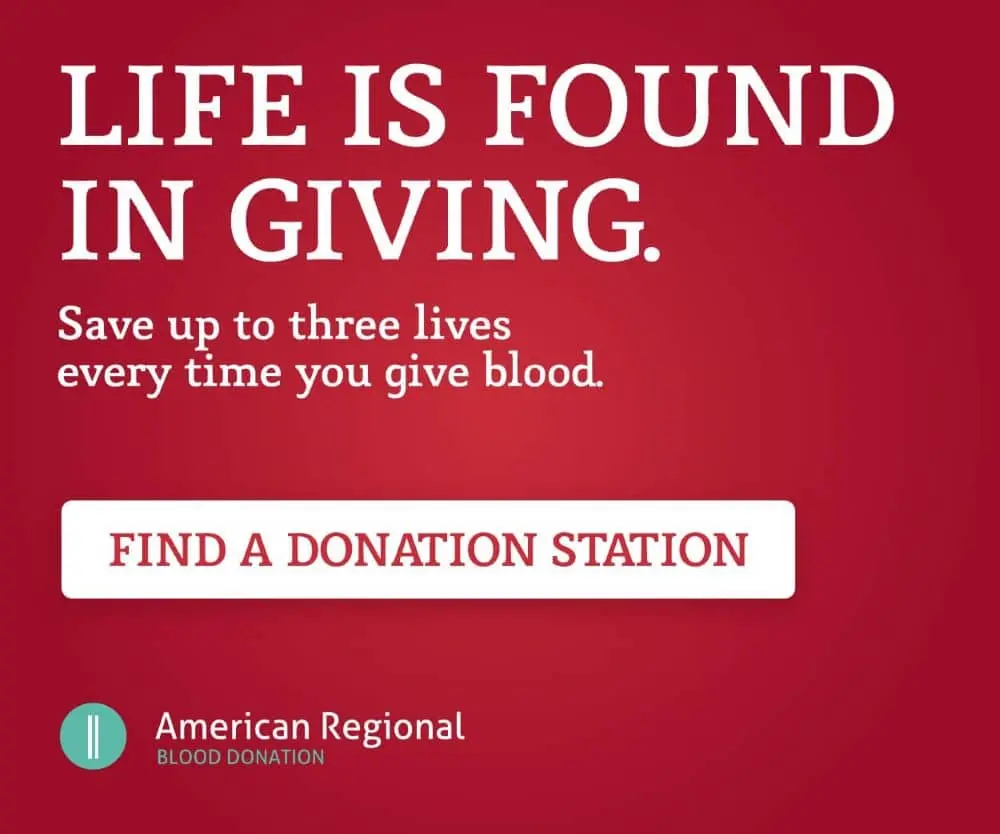
Of all our banner ideas, the medium rectangle banner is by far the most versatile. You can include this banner ad template in-line with text in web pages, news articles and other online communications.
Market full banner (468 x 60)


Inspired and designed after the very first banner to appear on the internet, the market full banner template follows that very size and format. This banner size offers the perfect space to show off your brand and product to thousands of potential customers.
Wide skyscraper banner (160 x 600)


A great pick for a digital marketing campaign, the wide skyscraper banner template can be used to show off products in various applications. Following this template, you can change images, colors and text to reflect your brand’s special offers.
Purple makeup banner ad
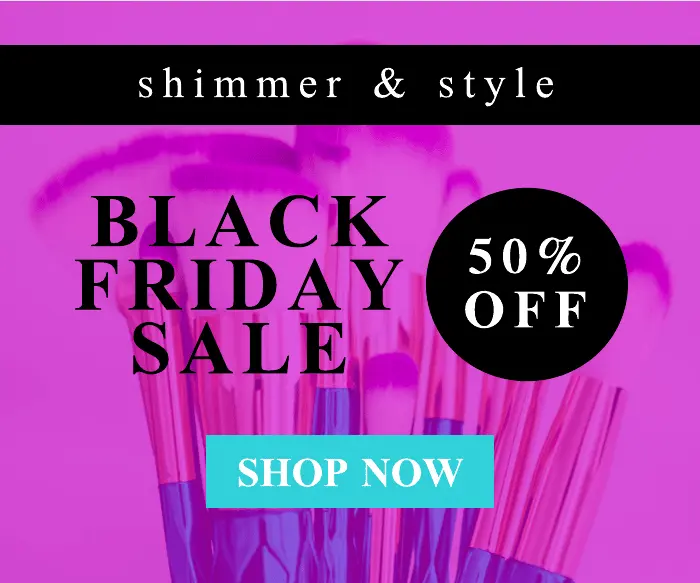

This banner ad works in a number of sizes, from a large rectangle (336 x 280) to a wide skyscraper (160 x 600). If you’re in the beauty industry, our purple makeup banner ad is a great template since it can be repurposed into multiple sizes.
Large website (1200 x 400)

A large website banner ad is the perfect option for today’s high-def screens. With this promotional large website banner template, you can upload your images and add text for your website banner, email header and more.
Print banner ideas
Job fair event (20 x 96)

Event banners are a necessity to advise and direct guests at a conference or job fair. In this particular template, the cityscape image will scream success and ambition. The neutral colors will allow you to sync it easily with your branding or the event branding.
Lush sale advertising (40 x 64)

Bordered by lush tropical green leaves, this beautiful sales advertising banner is a wonderful idea to promote products for brands that represent nature or use natural ingredients.
Executive business (40 x 128)

If you need a more professional template, the executive business banner is right for you. Designed with a professional air, this banner is sleek and modern.
Vibrant business (20 x 96)

We’ve converted the infographic into a vibrant banner template that will highlight the stats you’re proud of quickly and effectively — the more simple, the better.
Athletic event (40 x 128)

This dynamic athletic event banner is one of the best banner ideas out there for athletic events. You can use it to mark distance, give detailed stats, or showcase sponsors involved.
Social media banner ideas
Grand opening Facebook cover photo (851 x 315)
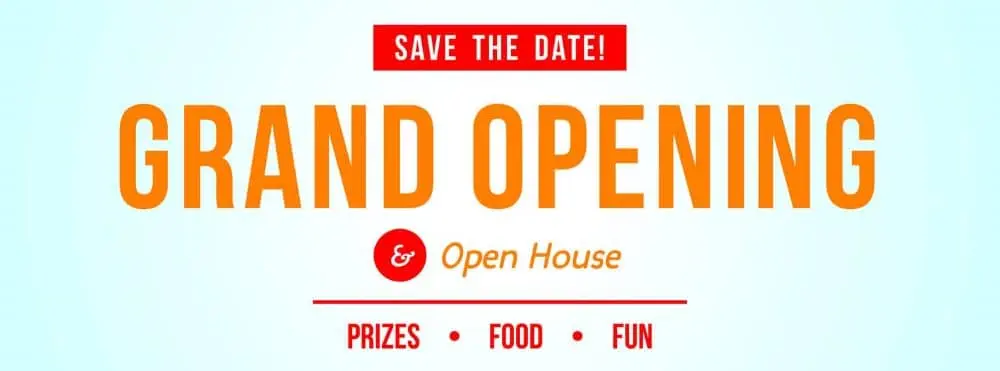
If you’re prepping for a grand opening and are hoping to advertise it on Facebook, using the right-sized banners is key to inviting people in. You can use this Facebook cover photo template by updating the fonts, colors and details to match your business.
Restaurant YouTube banner (1440 x 2650)
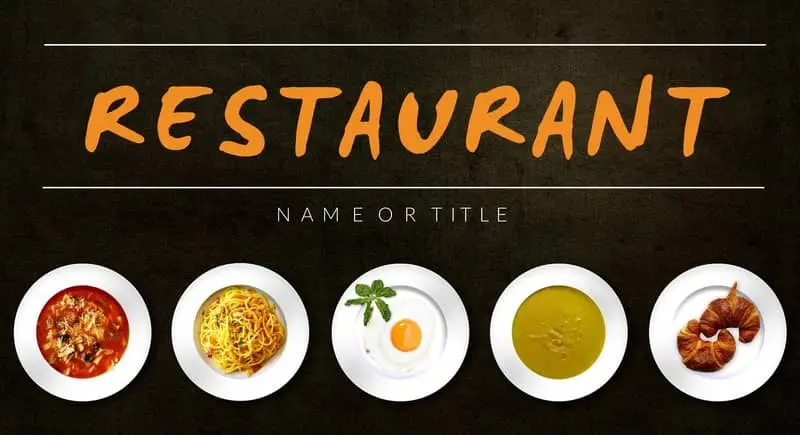
Your business is more than simply what happens in the kitchen, and if you’re trying to expand your social media reach through YouTube, this restaurant banner template is right for you. YouTube banners can highlight your food and immediately show what your channel is all about.
Travel blog Twitter tweet (1024 x 512)
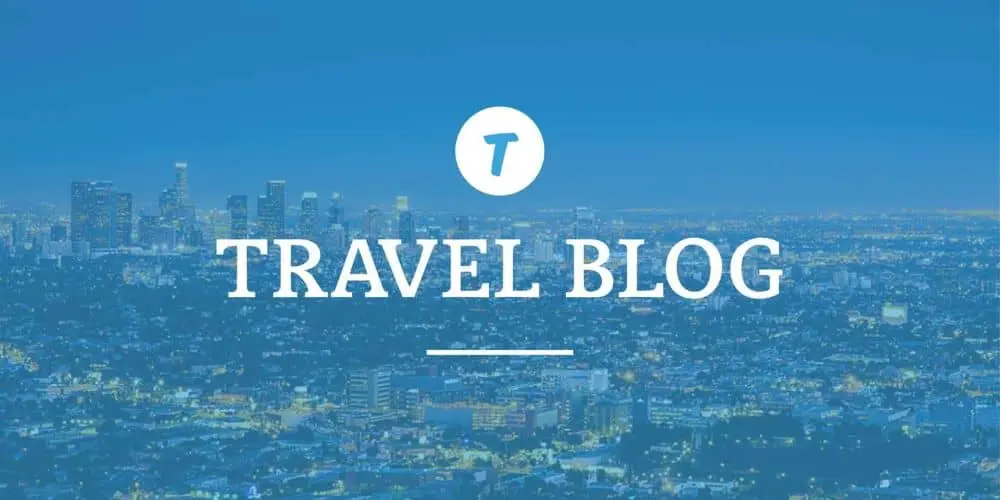
As a travel blogger, you most likely use Twitter to share content with your followers. But a link may not be getting the response or reach that you had hoped for. By implementing images into your tweets with this travel blog Twitter tweet template, you’ll keep readers engaged and entice them to click.
Band YouTube banner
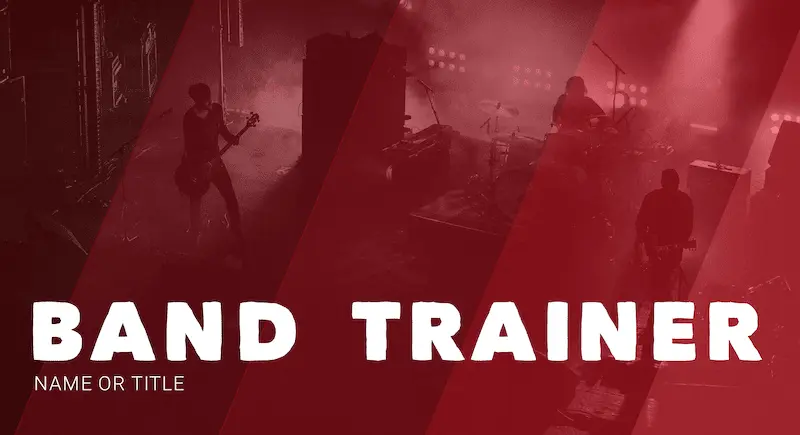
Create visual interest with a gradient overlay. This band YouTube banner design does a great job of creating a sense of mystery to pump up excitement for your next performance and drive subscribers to your YouTube channel.
Photography YouTube Channel Art

This photography YouTube channel art keeps things simple yet interesting with a box around the headline and a nearly black photograph, all on a plain, yellow background. Every element of the banner works together to let the viewer know that this channel is by artists and for artists.
Now it’s your turn to start designing your own banner! And if you want to make it extra easy, try our free banner templates.
When Instagram rolled out Stories in 2016, it became a social media sensation. Since then, the use of Instagram stories has skyrocketed, with an estimated 500 million people engaging daily. Because of its reach, Instagram Stories are a fantastic business marketing tool for small businesses and large brands alike.
As you peruse the platform, you’ll see creative Instagram story ideas on display, from quick videos to fun quizzes. Consistently coming up with fresh content for your Instagram Stories may seem like a stretch, but get into a groove and you’ll discover endless inspiration to pursue. Let’s explore some of the best Instagram story ideas to strut your brand’s stuff.
Ready to get creating? Find the Lucidpress Instagram story template that’ll make your Instagram story ideas pop.
20 of the best Instagram story ideas to engage your followers
1. Feature tutorials
The best way to gain a loyal following is to give your followers more of what they want when they want it. Tutorials describing how to make or use your product or services don’t have to be lengthy diatribes. Even short videos or custom graphics offer valuable insights to your audience.
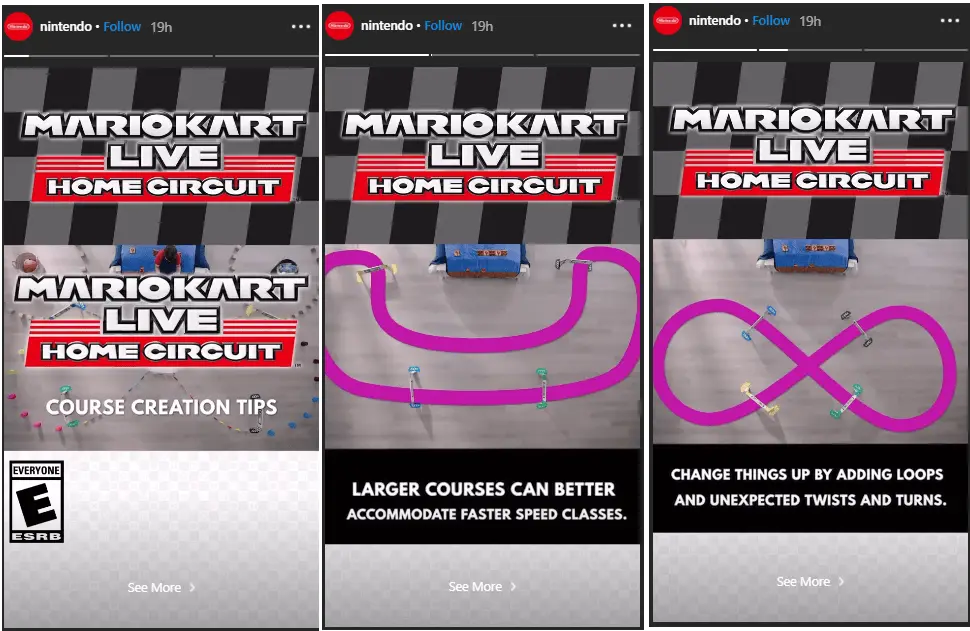
2. Offer freebies
Free is everyone’s favorite word, so feature contests and giveaways prominently as part of your Instagram Stories. Create branded graphics and think outside the literal box. Free trials, consultations and even collaborations with other businesses are part of a good giveaway strategy. If you’re hosting a contest, use a custom hashtag and ask participants to tag you to enter.
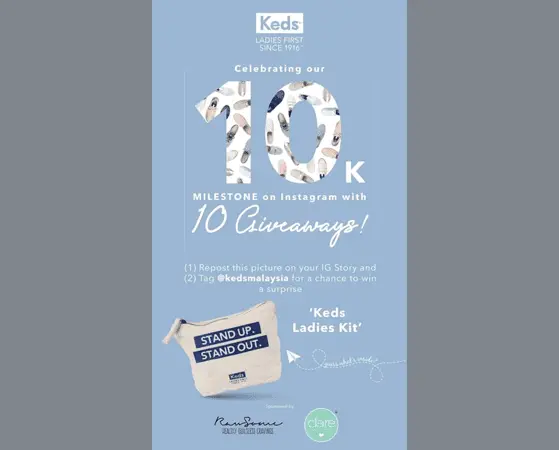
3. Polls, polls, polls
Instagram offers quite a few stickers to make stories sing and increase clickability, and poll stickers are one of them. Providing choices makes your followers feel like part of the conversation and boosts audience engagement. You can use polls to gather feedback, highlight a product or just spice up your profile with a little fun for everyone.
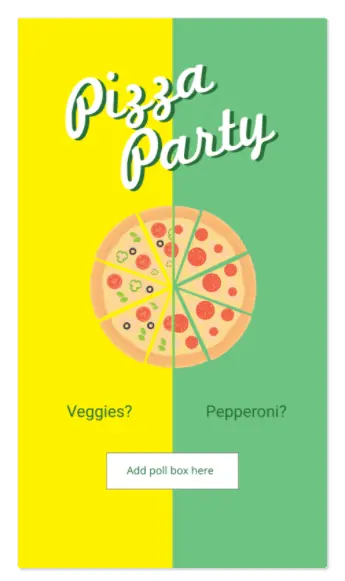
Get this Lucidpress Instagram story template HERE.
4. Show off the before and after
You don’t have to download a fancy photo editor to do before and after comparisons in Instagram Stories. Simply superimpose text on images and string them together as part of a peek at a transformation in progress. Before and after highlights can be a great strategy for cosmetic services, photo editing, home improvement projects, product or brand updates and much more.
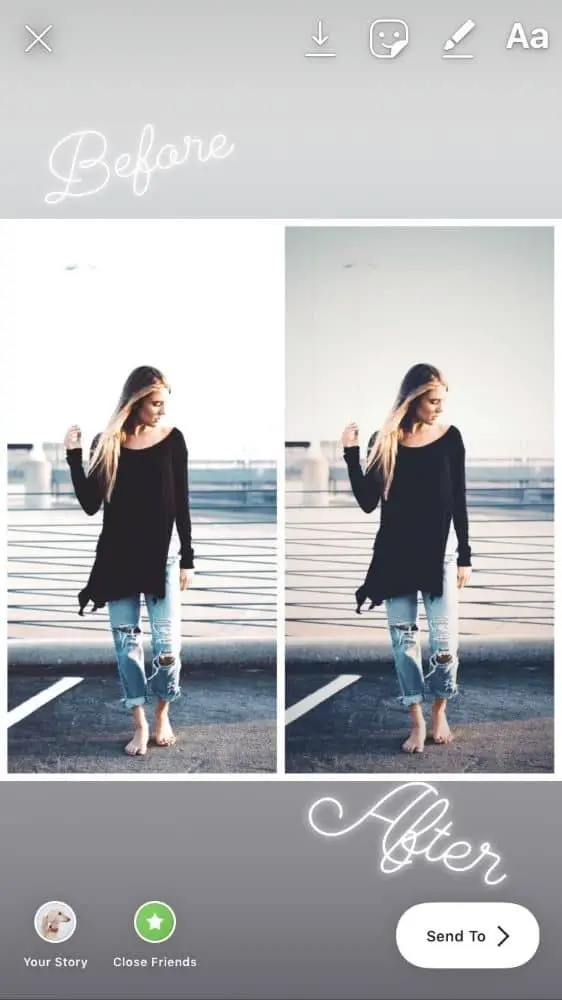
5. Choose this or that
Give your followers a little customizable content with a fresh take on the “this or that” questionnaire. These templates work as downloadable graphics where followers can circle or cross out choices and repost the completed copy on their own Instagram story. From food to travel to memes, it’s easy to populate this-or-that templates with topics that’ll align to your brand and pique your audience’s interest
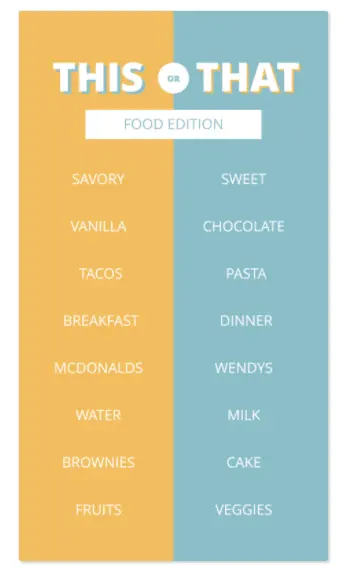
Get this Lucidpress Instagram story template HERE.
6. Stage an Instagram takeover
Move over and make room for an Instagram takeover. This Instagram story idea is exactly what it sounds like. In a takeover, your business allows someone to commandeer your account for a short period. A takeover involves allowing employees, influencers, competitors, and even customers to take the wheel. Letting someone else drive can generate clever clips to spice up your Instagram Story ideas and attract new followers.
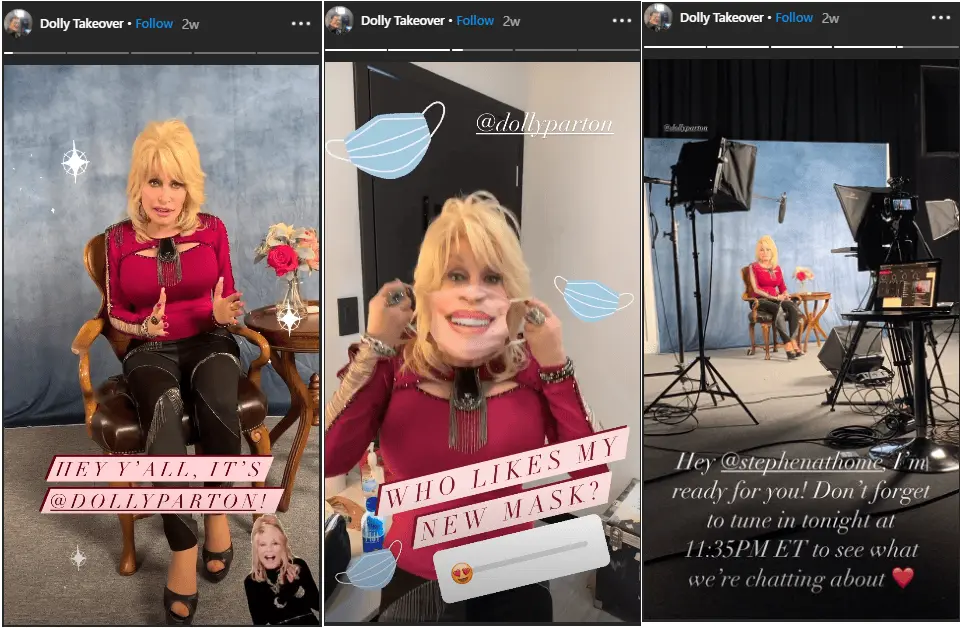
7. Go behind the scenes
There’s nothing more fascinating for brand enthusiasts than seeing how the secret sauce is made. Give them a peek behind the scenes in your Instagram stories with tours, bloopers, reels and exclusive content that lifts the veil between product and producer. Letting your audience see the mess behind the magic lends a uniquely human feel to your social media presence.
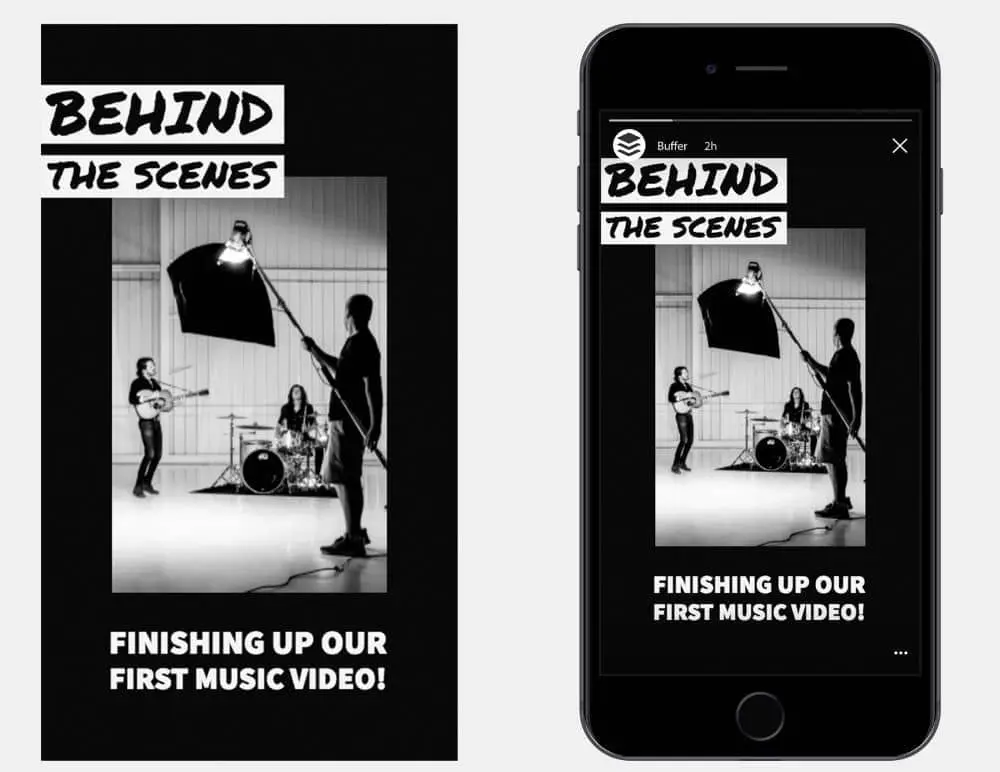
8. Interview an employee
Your greatest asset is your employees, so hand over the microphone and let them speak for themselves. Choose an employee who has a compelling personal story or insights that align well with your brand. Then step aside and let employees use Instagram Stories as a platform to educate your followers in their area of expertise.
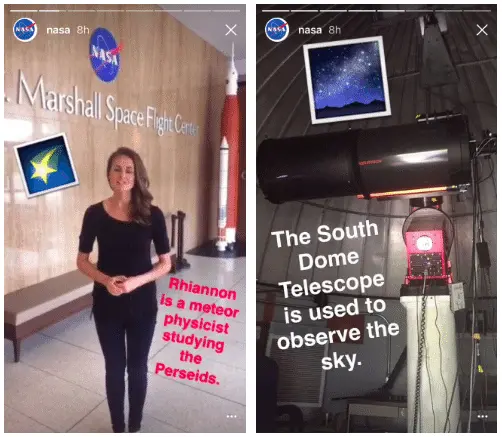
9. Promote a blog post
Building a following on Instagram is a worthy goal, but most businesses are also looking to boost traffic to a website. Instagram Stories is a solid strategy for promoting posts and directing followers to your blog. Take a few tantalizing snippets from your latest post and pop them into a visually appealing template. Then use the Instagram story swipe-up option or sticker to direct users to your website for more.
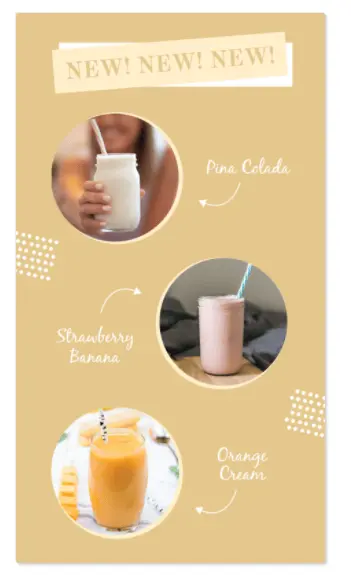
Get the Lucidpress Instagram story template HERE.
10. Play bingo
You don’t have to leave the couch (or Instagram, for that matter) to play bingo. Create a quirky, custom take on this traditional game that aligns with your brand. Books, movies, memes, emojis, food and much more are all fair game. Users upload the image you create to their camera roll, use the drawing tools (located in Stories) to mark it up, and repost to their own timeline or story.

Get the Lucidpress Instagram story template HERE.
11. Solicit suggestions
Not sure what your followers want? Go ahead and ask them. Solicit Instagram story ideas, new products, or just general feedback. If you’re brave, you can encourage followers to connect via direct message with their insights. Once you’ve gathered these fantastic tidbits, don’t let them go to waste. Share them in subsequent Instagram stories so your followers can benefit.
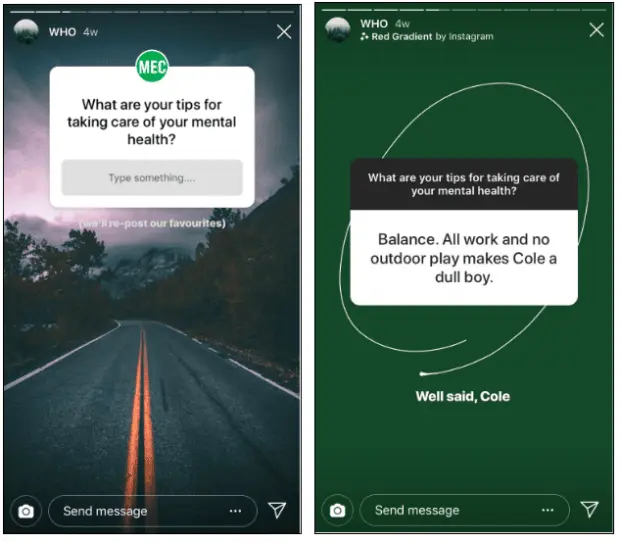
12. Share and link to CSR campaigns
Many companies have chosen to invest in promoting corporate social responsibility campaigns, and your Instagram Stories can be a perfect spot to highlight that work. Once you’ve shared a branded graphic on the campaign or community action you’re supporting, don’t forget to use the Instagram mention sticker to direct followers to where they can learn more or donate.
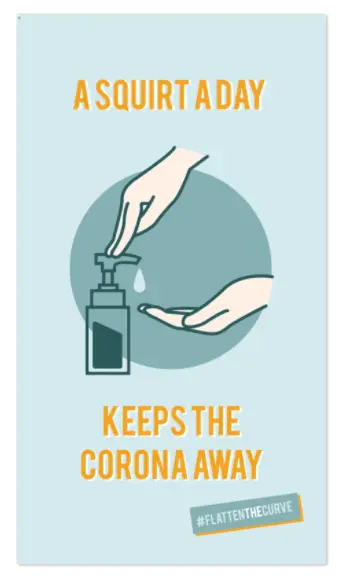
Get the Lucidpress Instagram story template HERE.
13. Design a shoppable story
Embedding a shopping experience into your Instagram Stories is a surefire way to convert followers into customers. Highlight your product with a little eye candy and include an Instagram sticker to swipe up and take users off-site. Be warned that not every business qualifies for shoppable stickers. Brands must have a business profile and offer a physical product that complies with Instagram’s policies.
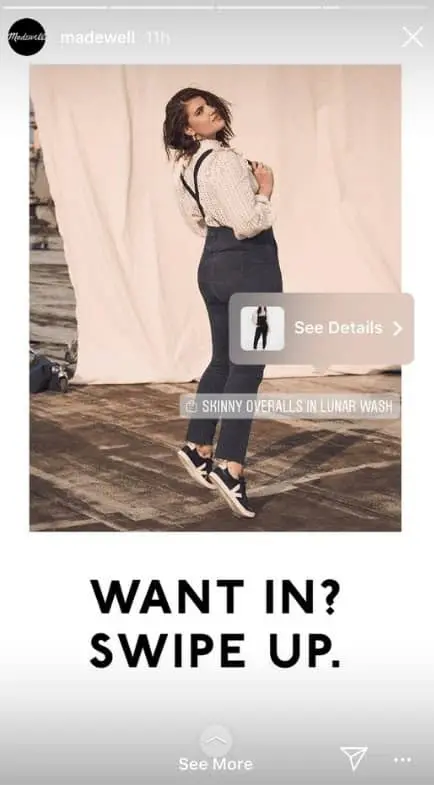
14. Create a quiz
Enough about you. Let’s talk about your followers. Quizzes give your audience a chance to weigh in and discover more not just about themselves but also about your products, services, or brand. Start a story and select the quiz sticker to create a series of questions for your followers to answer. You can customize colors and other elements for a branded effect.
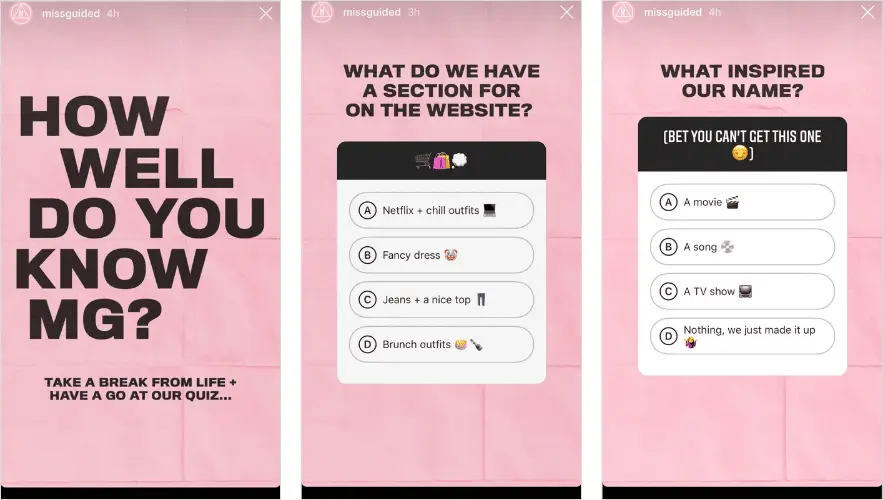
15. Do an unboxing
Unboxing videos aren’t just for YouTube anymore. Watching someone unpack a basket of goodies is profoundly satisfying for viewers, but it’s also a creative way to showcase your products. Even if you don’t offer a physical product, creative Instagram users can partner with affiliates to do an unboxing video.
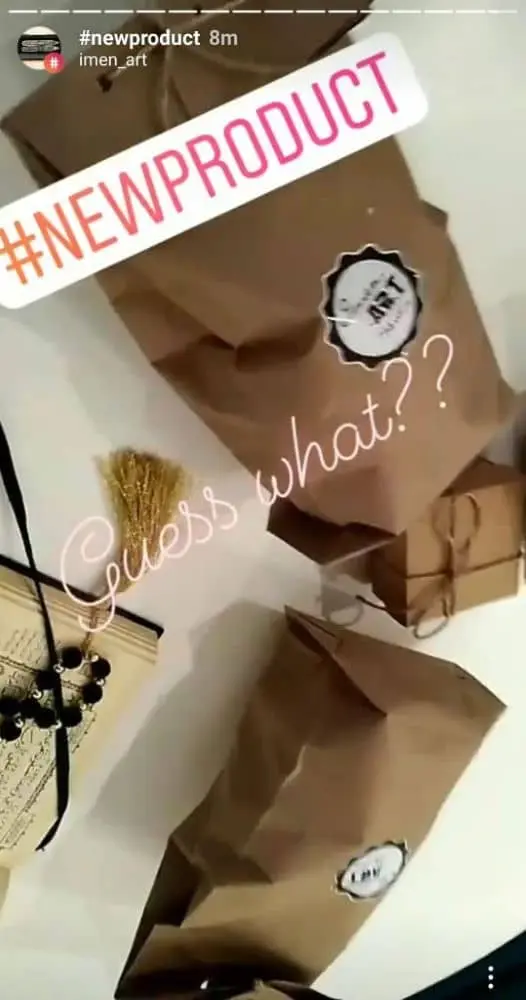
16. Go live
Half the fun of Instagram Stories is that they feel exclusive because they have an expiration date. Going live in your Instagram Stories is a way to directly engage with your audience and keep them checking your social media content daily. Notifications that you’re live go out once you start rolling, but for maximum impact, brands follow a consistent schedule and advertise live sessions in advance.

Get the Lucidpress Instagram story template HERE.
17. Promote a product or service
Finding unique ways to connect with followers on social media is crucial, but at the end of the day, your business exists because you have a product or service that meets a need. Show off your stuff in your Instagram Stories with branded graphics, promotional offers and periodic reminders that you take pride in the work you do.

Get the Lucidpress Instagram story template HERE.
18. Feature a testimonial
Testimonials are powerful social proof, so don’t hesitate to flaunt your glowing reviews. Pick the cream of the crop and pop them up on your Instagram Stories periodically. You can give these testimonials a polished feel or a little signature flair by repurposing branded quote templates.
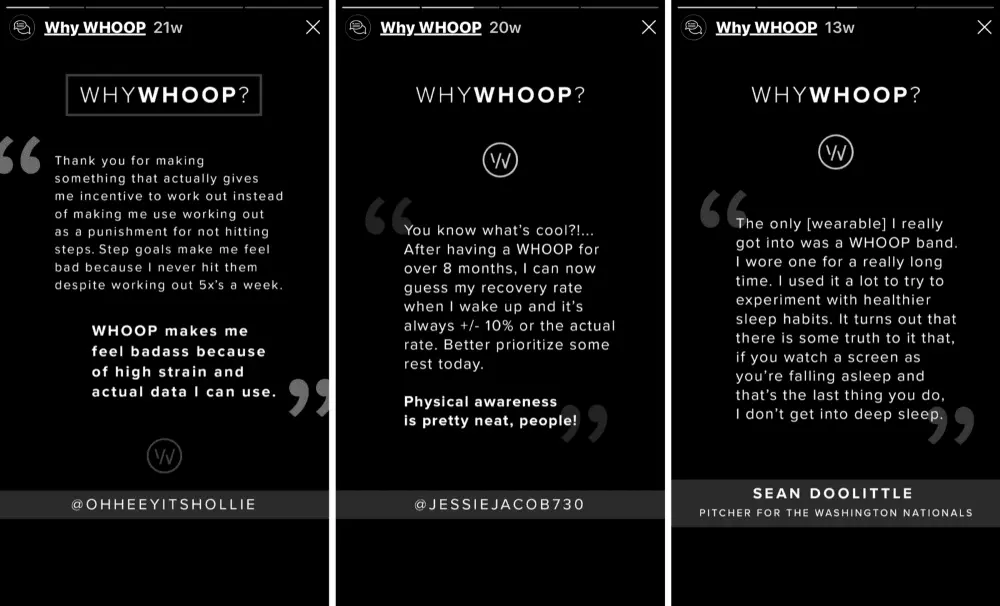
19. Give a sneak peek
Got something great in the can? Start generating buzz with a sneak peek on your Instagram Stories. Whether it’s a new product line, a seasonal promotion or an exciting rebrand or company update, you can start creating some suspense with a teaser. If you don’t have an exact launch date, maintain an aura of mystery by labeling it “coming soon” or “TBA.”
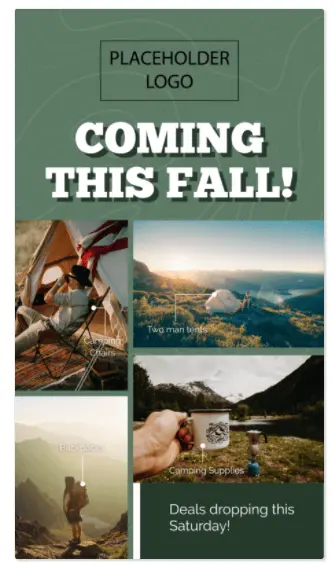
Get the Lucidpress Instagram story template HERE.
20. Count it down
Instagram Stories offers a customizable countdown sticker so you can celebrate no matter what the milestone. Product launches, sales, anniversaries, holidays, giveaways and events are all good fodder for the Instagram story countdown. Followers can also click on the sticker to set up an alert for when the count winds down.
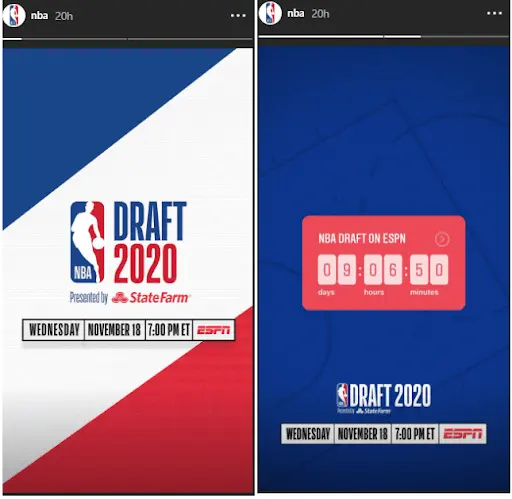
If you’re on autopilot periodically posting photos to your Instagram business profile, you’re missing out on the powerhouse of promotion this social media giant has become.
Learn how to leverage Instagram Stories and generate Instagram story ideas with Lucidpress Instagram story templates.
With 330 million active users monthly, Twitter can be a goldmine for business marketing. Celebrities, journalists and politicians flock to this powerful social network daily to strut their stuff and engage with followers. And it’s become a hub for brands who use Twitter as a clearinghouse for customer service concerns and boost brand reputations. However, if you haven’t figured out how to use Twitter for business marketing, you’re not alone.
Tweets fly thick and fast on the platform (nearly 500 million a day), so it’s easy to lose your way in the buzz of trending hashtags. Before jumping into the fray, we recommend developing a Twitter marketing strategy that centers your organization’s priorities — from brand awareness to boosting conversions; Twitter is a fantastic tool to reach your target audience if you leverage it effectively.
How to create a Twitter marketing strategy
Not all social media is created equal. Your Twitter marketing strategy should play to the platform’s strengths while centering around your business goals. Follow these steps to solidify your Twitter marketing strategy and start building a solid foundation for your brand’s social media presence.
Audit your accounts
Whether your brand has a handle you’ve used a handful of times or a patchwork of accounts, take stock of your Twitter presence. Make a list of:
- The profiles associated with your organization
- Who manages them
- What these profiles are currently being used for
Pay attention to metrics like how often the account tweets and how many followers it has. If an account isn’t verified yet, now is a good time to reach out to the Twitter verification team.
Keep an eye on competitor accounts
Once you have a good sense of your own social media presence, it pays to take a peek at the competition. Look for the good, the bad and the ugly in terms of engagement on the platform, as well as reach and whatever else you can learn from any missteps made. Keeping your finger on the pulse of industry leaders can serve as inspiration for how to refresh your presence on the platform.
Articulate your goals
A commitment to improving your brand’s Twitter marketing strategy should start with SMART goals that are specific and measurable. While you may be tasked with a vague sense of improving the brand’s social media reach, setting goals requires quantifying what success looks like. Make sure the goals you set are reasonable and actionable, and break down the strategies you’ll use to get there.
Assign responsibility
It doesn’t make sense to drive traffic to your Twitter account if no one is going to tend it. Discuss who is responsible for monitoring the account and set expectations for response time. Twitter is a fast-paced platform, and complaints can snowball into serious PR issues. Every engagement is your brand’s opportunity to build trust in the public marketplace.
Set some guidelines
If you don’t already have social media guidelines, now is a good time to define them. Communication between various members of the team attending your Twitter account should be consistent and transition seamlessly. Discuss how handoffs with the customer service team will occur and protocols for addressing the most frequently surfaced concerns.
Find your voice
Leverage your brand style guide to figure out what your social media voice sounds like. Set guidelines not only for when you’ll engage with followers but how. While you might opt to use humor or keep it more buttoned-up, the most critical piece of advice for successful social media engagement is to be human. Whether someone is a fickle Twitter follower or devoted customer, people appreciate brands that strive to be authentic and sincere.
Create a content strategy
In the same way that you create a content strategy for your blog or website, you should create a strategy for your Twitter content. Focusing on customer success stories, amplifying promotions or providing industry insights are all ways Twitter content can communicate your brand’s priorities. Studying buyer personas may also help you to flesh out what content your audience craves.
Plan a Twitter content calendar
Having goals for your Twitter marketing strategy is a start, but taking action is paramount. Establishing a social content calendar enables you to control the timing of your messaging for maximum impact and implement effective campaigns across all your channels. There are several third-party services that can help manage campaigns in one place and schedule tweets in advance.
Measure, analyze and adjust
Once you have a Twitter marketing strategy solidified, start measuring your progress. Fortunately, Twitter puts much of the data you’ll need at your fingertips. Here are just a few of the metrics Twitter analytics provides.
- Engagement: You can click to see engagement on each tweet or access overall engagement metrics for your account from the main menu.
- Impressions: Impressions are a measurement of how many people have seen your tweet and the reach of your content.
- Hashtags: Twitter measures the popularity of certain hashtags among your followers, so you know what to amplify.
- Top tweets: See your top-performing tweets, so you know what’s working and can tweak your approach to gain better traction.
If you’re using Twitter ads, you’ll get additional analytics and advice on how to improve performance in the Twitter Business Center.
Twitter marketing best practices you should follow
While there’s no single approach for using Twitter for business marketing, there are some best practices brands follow to make the most of the platform. Here are some ways to get your Twitter handles churning out social media buzz.
Brand your profile
From the images you display to the website your account connects to, every piece of your Twitter profile should align carefully with your brand. Twitter allows users to customize profiles, so make the most of that valuable real estate with content creation tools like the Lucidpress Twitter header template.
Leverage hashtags
Every social media platform has unwritten rules about hashtags. On Twitter, the home of hashtags, the motto is to use them sparingly. Branded hashtags are a great way to amplify campaigns, but sprinkling in too many will trigger Twitter’s spammy senses. Using popular hashtags also helps your brand ride the wave of Twitter trending topics and expand organic reach.
Engage, engage, engage
Gaining more followers is the name of the game on any social media platform, but it’s especially important on Twitter. However, instead of approaching Twitter as an opportunity to build clout, think of it as a chance to build community. The more you engage in the replies or the discussions happening in your mentions, the more you’ll build trust.
Mix it up with media
While Twitter might not be as visually appealing as platforms like Instagram, users still love dynamic tweets with high-quality images, GIFs, and videos. Including a mixture of media creates “shareable” content and enables you to do more with Twitter’s 280 character limit. In some cases, a picture really is worth a thousand words.
Want to create branded graphics for your tweets that’ll pop-off with your audience? Use Lucidpress Twitter post templates.
Promote and advertise
Twitter offers a few different ways for brands to advertise. One method is through promoted tweets, where businesses pay a monthly fee to promote tweets to a targeted audience. The other method is through Twitter Ads, which leverages keyword or timeline targeting. Both promotion methods can be great ways to elevate your brand profile and build a following while driving conversions.
Keep these helpful tools handy
Twitter does offer other bells and whistles worth discussing. One is Twitter lists, which weed through the chatter by aggregating tweets from accounts you select. Creating lists is a clever way to curate content and amplify trends within your industry. Twitter Moments also offers customization by allowing users to select tweets from their own timeline and mix in tweets from other accounts to create a comprehensive take on a topic.
Take the time to listen
Instead of dropping into your brand’s mentions or replies sporadically, set up scheduled interactions with followers by soliciting feedback through Twitter polls or hosting a Twitter chat. Many brands find Twitter chats are more successful if organized around a theme or hashtag and scheduled consistently from week to week.
Know that challenging interactions are par for the course
Twitterverse is notorious for broadcasting customer service mishaps. And your response to those complaints can make or break your brand’s reputation. Once an incident starts trending, it can be hard not to watch the train wreck. That’s why it’s critical to tend your mentions closely and respond quickly. Decide whether it’s a conversation you want to have in a public forum and direct the customer to your direct messages for a speedy resolution.
Whether you’re pruning a Twitter presence or nourishing a neglected handle back to life, you don’t have to go it alone. Lucidpress is here to help with streamlined Twitter templates and resources.
Try these Lucidpress Twitter templates to create a buzz-worthy, branded Twitter presence.
Increasingly, social media platforms have become online communities that are central to the way users connect, spend, and socialize. Pew Research’s 2021 report on social media use indicates 72% of American adults use social media, with a majority of Facebook, Snapchat, and Instagram users logging in daily to check their feeds.
While it might be tempting to turn a blind eye to your employees’ social media use, the reality is most of your staff has an online presence. And without a social media policy for nonprofits in place, a small misstep online could do damage to your organization’s reputation and brand. That’s why it’s imperative to establish and implement a nonprofit social media policy.
What is a nonprofit social media policy?
A nonprofit social media policy is a set of guidelines about how a nonprofit organization and its staff and volunteers should interact online, specifically on social media accounts. Social media policy for nonprofits can cover both the organization’s brand channels as well as how employees use their own social media accounts either professionally or personally.
You can think of a social media policy for nonprofits as a code of conduct for online spaces instead of office spaces. It can span a wide range of issues, from responding to customer service complaints to security and password protocol. A nonprofit social media policy template also details the kinds of content that would be considered problematic and how employees can participate in brand advocacy.
Why do you need a social media policy for nonprofits?
The days of saying employees can’t be held responsible for what they post online have definitely passed. Today you ignore the need for a social media policy for nonprofits at your peril. Here are a few reasons drafting and implementing a social media policy is crucial to your nonprofit marketing strategy and can help mitigate risk for your organization’s brand.
Clarify expectations for employees and volunteers
Setting expectations for social media use can be tricky for nonprofits because they can be staffed by a large number of volunteers. But when people join your organization, your social media policy for nonprofits should detail how to engage in advocacy online and empower your mission with appropriate messaging. Otherwise, you risk an errant post on Instagram or Facebook compromising the reputation of your nonprofit and alienating potential donors.
Squash PR problems before they happen
Increasingly, online platforms have become clearinghouses for customer service complaints, and the nonprofit space is no different. Establishing a social media policy for nonprofits ensures that when staff stumble across someone with a negative experience, they know how to respond and who to contact. The Humane Society was an early adopter of social media, and its network of nonprofit organizations is a great example of how staying active and engaging in online communities can avert a PR crisis and build your brand.
Keep your brand consistent across channels
Because a social media policy for nonprofits also defines content and tone on brand channels, it can be a great tool to keep the voice of your organization consistent. Clarifying who is in charge of posting on social media is also essential because it helps employees and volunteers understand their online responsibilities and avoid potential security breaches. The fallout when a social media account has been compromised will garner your nonprofit attention, but for all the wrong reasons.
What your nonprofit social media policy should cover
While you might run out and start googling “nonprofit social media policy template” after skimming the section above, it’s worthwhile to consider exactly what a social media policy for nonprofits should include. Look for a nonprofit social media policy template that details the following:
- Designate which staff or volunteers are approved to post on social media accounts and brand channels.
- Specific guidelines for responding to social media comments.
- Definitions of what is considered plagiarism and how to avoid copyright issues.
- Protocols for secure passwords, installing software updates, and other basic online security concerns.
- Guidelines for social media managers and brand channel users about how to respond to conflict, manage crises, and address customer service issues.
- Guidelines for employee and volunteers’ personal media accounts that empower advocacy for your nonprofit but discourage problematic behavior.
And last but not least, provide plenty of easy-to-use social media templates that reflect your nonprofit branding. Lucidpress has customizable templates that are perfect for keeping your nonprofit social media posts consistent and professional.
Download our free ebook to learn more about social media policy for nonprofits and how to keep your nonprofit messaging mission-focused.
Have your organization’s social media platforms gone radio silent since the intern left? Welcome to the world of social media strategy for nonprofits where the struggle to post consistently is real. Nonprofits rely on an army of volunteers and don’t always have the financial bandwidth to staff an office. This bootstrapped approach means social media marketing for nonprofits can become an afterthought.
Like gardens, social media channels languish unattended. Following the social media best practices for nonprofits listed below is a great place to start building a social media nonprofit marketing strategy or to revive an existing one. In each tip, you’ll find insight on how to use social media for nonprofits from social media managers and CEOs who know what it takes to engage successfully.
7 tips on running social media for nonprofits
1. Go where your audience is
You can’t be all things to all people. Part of a successful social media strategy for nonprofits is to think about where your audience is spending time. Focus your efforts on the social media platforms that potential donors are most likely to use either personally or professionally.
Whether it’s the eye candy on Instagram or the younger crowd on TikTok, focus on the platform your audience calls home. And keep in mind it might not be Facebook.
“I think nonprofits benefit from being on LinkedIn so that they can be found easily. It adds credibility and transparency when you know the people you are meeting or working with know people in common. LinkedIn has become more than an online rolodex — it is the foundation for building trusted relationships in the digital economy.”
Paige Arnof-Fenn, Founder & CEO of Mavens & Moguls
2. Post with a purpose
Starting with the purpose in mind is a key part of social media best practices for nonprofits. If your timeline hasn’t seen much action in a while, posting a flurry of updates won’t produce engagement. Instead, develop a strategy for each platform that considers how your content can have the most impact.
Think carefully not just about social media best practices for nonprofits but also about your organization’s goals. What do you want to accomplish? Get specific. If the purpose of your social media strategy is to gain more followers, connect to your why. There’s a reason that’s important to social media marketing for nonprofits. Consider what success looks like, whether that’s increases in nonprofit fundraising or recruiting more volunteers.
3. Get consistent across channels
In social media, consistency is about more than posting at the same time every day. Cracking the formula for how to use social media for nonprofits requires both the right amount of engagement and keeping content streamlined across different channels. It’s about frequency, timing, and a dash of experimentation to determine what works for you and your audience.
If that sounds a little daunting, don’t despair. Julia Sellers from Thirty Press, a communications consultancy for nonprofits, advises falling back on the 80/20 rule, which is one of several social media best practices for nonprofits.
“Posts should follow the 80/20 rule. 80% education and inspiration versus 20% hard asks for donations. Nonprofits do not have to be on every social platform. Evaluate your target market and get really strong at being present on the one or two platforms where that market intersects.”
4. Find an authentic voice
It can be tempting if you have the financial bandwidth to outsource social media management, but that can be tricky for nonprofits. Social media strategy for nonprofits relies on connecting to the passion people have for a particular cause and turning it into action.
As Magie Stevens from Lets All Do Good advises, it’s crucial to find an authentic voice and to use it in your social media marketing for nonprofits.
“Having both in-house and agency experience, my advice on running social for a nonprofit is to not outsource it. It seems to be one of the first things marketing departments look to give to an agency to take over, and it doesn’t work. For organic social to resonate, it needs to be authentic, agile, and timely. It requires someone who knows the industry, the organization, the mission, and the audience — all pieces of the puzzle that an agency cannot bring to the table.”
5. Make it emotional
Hitting the jackpot with viral content is peak success in social media for nonprofits, but research indicates it’s less a matter of luck and more about well-crafted, highly emotional content.
And contrary to expectations about how to use social media for nonprofits, the content doesn’t have to be relentlessly upbeat. While it might not seem out of the playbook for social media best practices for nonprofits, anger can actually drive viral content with outrage clicks.
“One important point is nonprofits need to tap into high-arousal emotions. We learned this in Jonah Berger’s book, Contagious. That means not posting sad, demoralizing, or bland informational content. Instead, try to inspire awe, inspiration, excitement, or even anger.”
Allison Mahoney, Estorie Agency
6. Make it visual
While it can depend on the platform, dynamic visuals remain one of the most vital aspects of successful social media marketing for nonprofits. Infographics, photographs, and videos are the staples of social media posts for a reason.
However, as the CEO of nonprofit Cancer Kids First, Olivia Zhang, explains, viral videos are no accident. Incorporating viral videos into your social media strategy for nonprofits requires paying careful attention to a platform’s algorithms and users to determine the best framing, timing, and topics.
“TikTok has become extremely popular during the pandemic, and nonprofits can use this new audience to their advantage. Before launching our official account, I did in-depth research on the best ways to go viral. I studied TikTok algorithms and watched countless videos with titles such as “How to Go Viral on TikTok in Under a Week” or “Knowing When and What to Post on TikTok to Gain Views.” I even created a schedule of the best days to post — Tuesdays, Thursdays, and Saturdays — and the best times.”
7. Engage, engage, engage
Instead of thinking of social media as a bullhorn for your nonprofit’s mission, consider it a channel for conversation with a community of users. The best advice for how to use social media for nonprofits boils down to focusing on forging relationships with followers. And like any relationship, you have to invest the time and engage.
Social media best practices for nonprofits include asking your audience what they think through surveys, polls, and feedback. Get into the comments regularly. Listen carefully. While your ultimate goal may be to recruit volunteers or gain donors, you’re also raising awareness and creating a community that’ll rally your cause.
Social media marketing for nonprofits can be a powerful tool to expand your donor base and fundraise. But your channels require a social media marketing strategy for nonprofits that focuses on consistency and platform- and audience-specific insights that maximize your organization’s impact.
Learn more about social media for nonprofits, including how to amplify your mission with our free nonprofit messaging guide.
While other industries raced to embrace social media platforms to connect with customers and create loyal brand followings, healthcare social media marketing has been more tentative. Many hospitals and healthcare organizations cited concerns like HIPAA and professionalism as reasons not to be actively involved in digital marketing on social media channels.
However, social media healthcare marketing has come a long way in the last few years and is beginning to transform how we interact with and access health information online. Healthcare marketing teams have recognized the outsized role social media can play in driving conversations on topics like preventative care and public health measures.
Why social media healthcare marketing matters
From helping navigate healthcare crises to making patients feel more comfortable seeking care, healthcare organizations are beginning to use their social media presence to connect in meaningful ways. Here are just a few reasons healthcare social media marketing content matters.
Creating a sense of community
Communities aren’t just physical spaces anymore. Healthcare organizations that invest in a robust healthcare social media marketing strategy can become trusted members of an online community by being present and interacting with patients.
Connecting with a new audience
Hospitals and clinics used to exclusively rely on word-of-mouth referrals or simply being the closest local provider to win over patients. Today’s digital marketing and social media channels allow hospitals and clinics to reach new audiences and build a national brand.
Establishing trust in online spaces
One of the unspoken rules of the internet is if you don’t answer the question, someone else will. As most providers know, Dr. Google is not a good substitute for medical expertise. Healthcare social media channels are fantastic avenues to answer patients’ frequently asked health questions, provide professional advice, and correct health misinformation.
7 tips for effective healthcare social media marketing
Using social media channels to market your healthcare organization can be a tricky balancing act. Unlike businesses that can showcase products and strut their stuff openly, hospitals and clinics have to be wary about HIPAA concerns and medical ethics. However, that doesn’t mean social media platforms can’t be leveraged in the following ways to benefit both your organization and the public.
1. Focus on the patient experience
Going behind the scenes and highlighting the patient experience can be a profound way to connect to followers. It also offers the opportunity to indulge in a little healthcare social media marketing by showing off the expertise and services your organization provides. Take, for instance, this Facebook post from New York-Presbyterian Hospital that showcases the incredible neonatal care a patient received and how it helped her triumph over the odds.
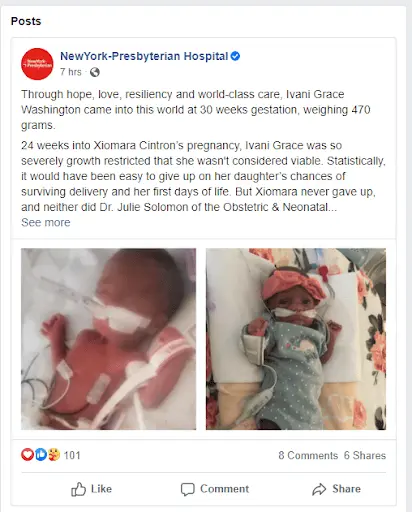
When you do a deep dive on a patient experience, be sure you have their express permission to share that content or to amplify social media posts. Shout-outs for other user-generated content like reviews also demonstrate you’re engaging in social listening and can go a long way toward making patients feel seen and heard.
2. Combat misinformation
The proliferation of health misinformation on social media cannot be overstated. A 2021 study from the Journal of Medical Internet Research indicates as many as 87% of social media users are affected by health misinformation on the platforms they frequent. Reputable medical organizations can play a role in correcting and minimizing the harm misinformation causes.
Social media healthcare marketing creates space for trusted voices of medical providers to deliver reassurance and fact-based medical advice. For instance, the American Academy of Pediatrics has long been considered an authority in pediatric medicine, and its advocacy for vaccination is the cornerstone of a powerful and persuasive public health campaign.

3. Educate the public
Alongside fighting the spread of misinformation, healthcare social media marketing content is an effective educational tool. Keeping up with research and helping the public understand its relevance to current practice goes a long way toward establishing your credibility on social media.
Organizations like Cedars-Sinai that have their own health information databases can use social media channels to not only distribute these articles but also drive engagement with the hospital’s website and improve search engine rankings.

4. Shine a light on preventative care
Raising awareness is one of the crucial ways healthcare organizations have an outsized impact on social media. But it’s also an effective means to market preventative services that can really make a difference in medical outcomes. Take, for instance, the World Health Organization’s campaign to end cervical cancer by promoting screenings for 70% of women around the world.
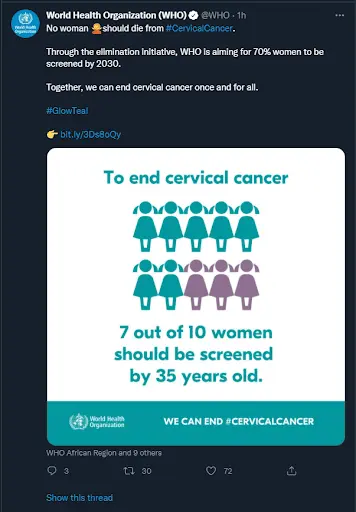
Preventative care campaigns are also an excellent opportunity to create a partnership with another healthcare organization. Tackling the social media healthcare marketing campaign together can amplify the reach of your content and expand your audience.
5. Become a trusted source
As you invest in healthcare social media marketing, you’ll want to pay special attention to becoming a source of trusted healthcare information and an authoritative voice in the industry. The best way to accomplish this is to look for ways to highlight the fantastic talent within your organization.
The Mayo Clinic is renowned for its social media prowess, and it’s built a powerhouse brand because of it. The secret sauce to Mayo Clinic’s success is to lean into its world-class doctors and cutting-edge researchers as the face of the organization. They are repeatedly put front and center in social media channels, allowing these trusted professionals to reach millions of followers.

6. Create a community of support
Social media platforms are online communities, and as such, they can be tools to create support for patients and their families. Even if your healthcare organization doesn’t have the bandwidth to support patient communities as part of its healthcare social media marketing strategy, you can act as a catalyst to connect people to resources.
This approach is particularly helpful for hospitals and clinics that treat a large community of patients with chronic conditions and life-threatening diseases such as cancer. By giving patients the means to connect, you create a sense of community between your providers, patients, and the families you serve.
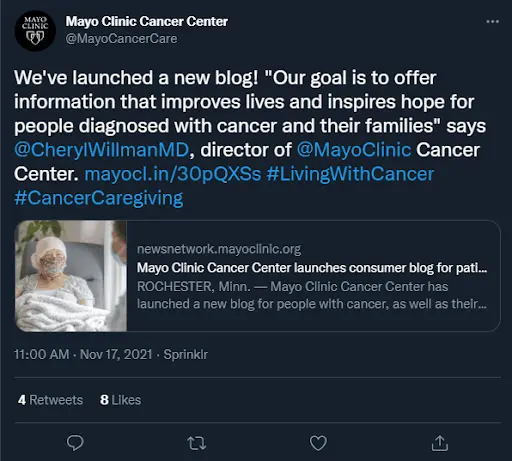
7. Destigmatize sensitive topics
Some healthcare topics can be a little sticky on social media, but allowing your providers to wade into those waters as trusted professionals can destigmatize important topics. And it serves your social media healthcare marketing strategy both by establishing trust and encouraging your followers to become more involved.
Doctors without Borders consistently exceeds fundraising goals, and it does so in part because the organization’s social media presence has a commitment to advocacy and tackling stigmatized topics with fact-based health advice.
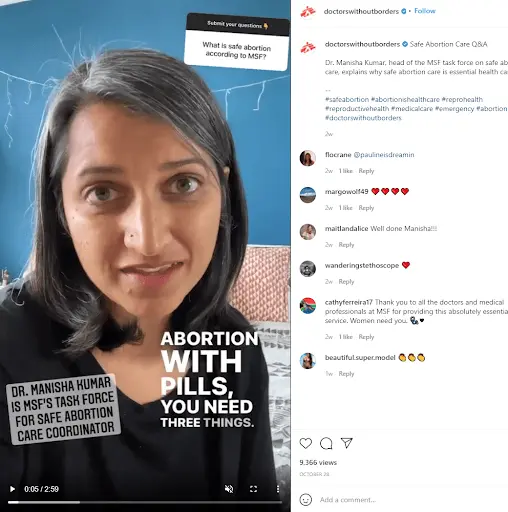
So while healthcare orgs can’t fill their social media timelines with brand ambassador endorsements or swag giveaways, there is a real opportunity for hospitals and clinics to provide trusted, sound medical advice from licensed practitioners. This approach can create healthcare social media marketing content that cements your healthcare brand’s reputation, reaches new patients, and expands your influence both online and within your local community.
Knock your healthcare social media marketing goals out of the park with our free ebook.